Pam Hawley Marlin
December 2023
"My first visit was at old Providence church near Col. Edward Lewis and Parson King's plantation now called Windsor. I found many good people and nearly all of them invited me to go home with them. Not like the people today, in a very big hurry, not even waiting to shake hands." -James Doig, Gainesville resident (1917)
Nestled within the historic settlement of Windsor in Alachua County, Florida, the Providence Community Christian Church stands as a serene testament to the region's rich heritage. Located on County Road 1474, or King Street, the white, rectangular frame building harmoniously blends with the picturesque, time-honored Florida landscape.
The church can be traced back to 1855 when it was originally established as the Providence Methodist Episcopal Church, South, well before the community of Windsor was founded in 1884. The first church built on this site was crafted from roughly hewn pine logs, standing as a symbol of faith in a rapidly evolving frontier. For most of its 170 years, this sacred site has faithfully served the nearby community as a house of worship.
Today, the church's tranquil surroundings are adorned by majestic ancient oak trees and vibrant azalea bushes, setting a fitting backdrop for the historic church and its adjacent graveyard. This sacred resting place bears witness to the final repose of Florida's earliest pioneers, preserving their legacy for generations to come.
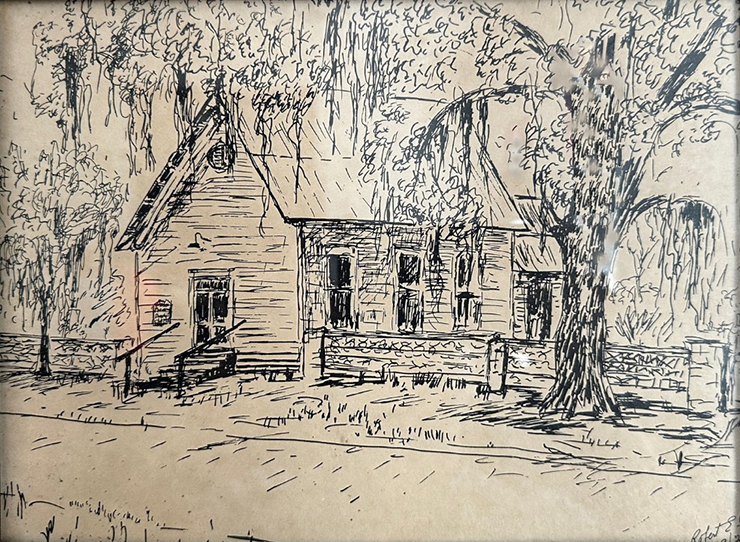 A 1960's sketch of the Providence church displayed inside
the church. P. Marlin
A 1960's sketch of the Providence church displayed inside
the church. P. Marlin
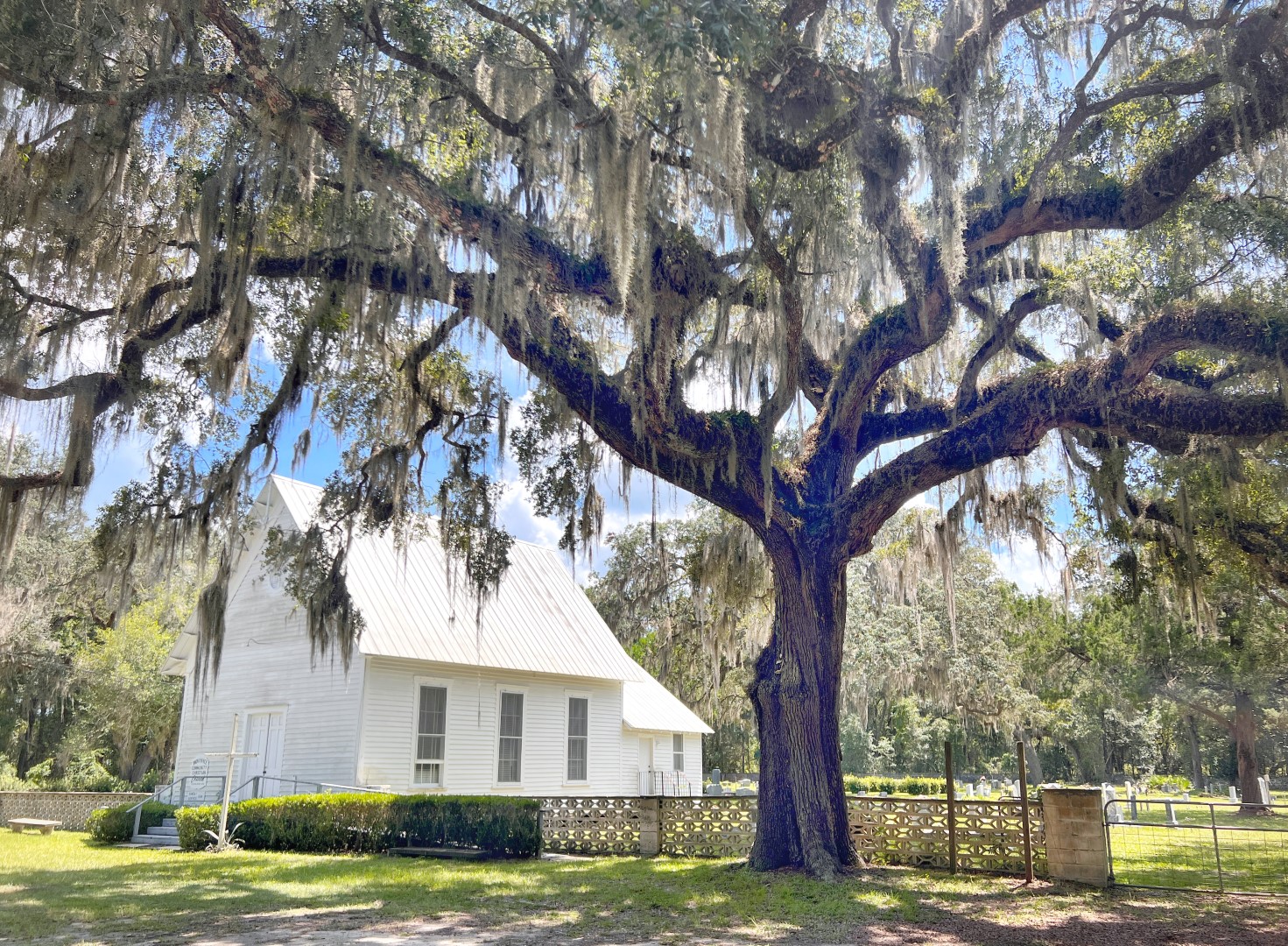 The Windsor Community Christian Church in 2023. P Marlin
The Windsor Community Christian Church in 2023. P Marlin
Florida's unique and diverse history boasts the first United States permanent European settlement - named St. Augustine - in 1565. Much of Florida, however, was not settled until the 19th century when railroads provided accessibility to its vast undeveloped regions. Through centuries of Spanish (and briefly British) rule, Florida remained untamed with its shrub-filled terrains, vast swamps, hostile Native Americans, formidable alligators, and disease-carrying mosquitoes. Those who dared to explore this unfamiliar territory were often discouraged by the harsh and unpredictable nature of the environment, along with the social animosities prevalent in the unexplored land.
Florida's earliest inland settlement can be traced to what is now Alachua County, situated in north-central Florida. This region was originally inhabited by the Timucuan and Seminole Indians prior to the European's arrival. As European-American settlers encroached upon their ancestral lands in the early 19th century, the Seminoles responded with violent raids on nearby plantations, intensifying tensions. These mounting hostilities eventually led to military confrontations. In 1812, Colonel Daniel Newnan clashed with the Seminoles on the shore of Newnans Lake, in an event known as "Newnan's Expedition." This encounter with the Seminoles was an initial conflict in Florida's Patriot War (this historic site is situated within close proximity of the Providence church).
In 1821, Florida transitioned into a United States territory after Spain ceded control. Courageous pioneers, who had fostered amicable relations with the Seminoles, ventured into Florida's interior via the "Alachua Trail." Upon arrival, these pioneers established Florida's first distinct inland American town, called Micanopy, located about twelve miles southwest of Windsor. The ensuing decades brought significant hardships to the Seminoles, as the Seminole Wars resulted in forced displacement from their ancestral lands.
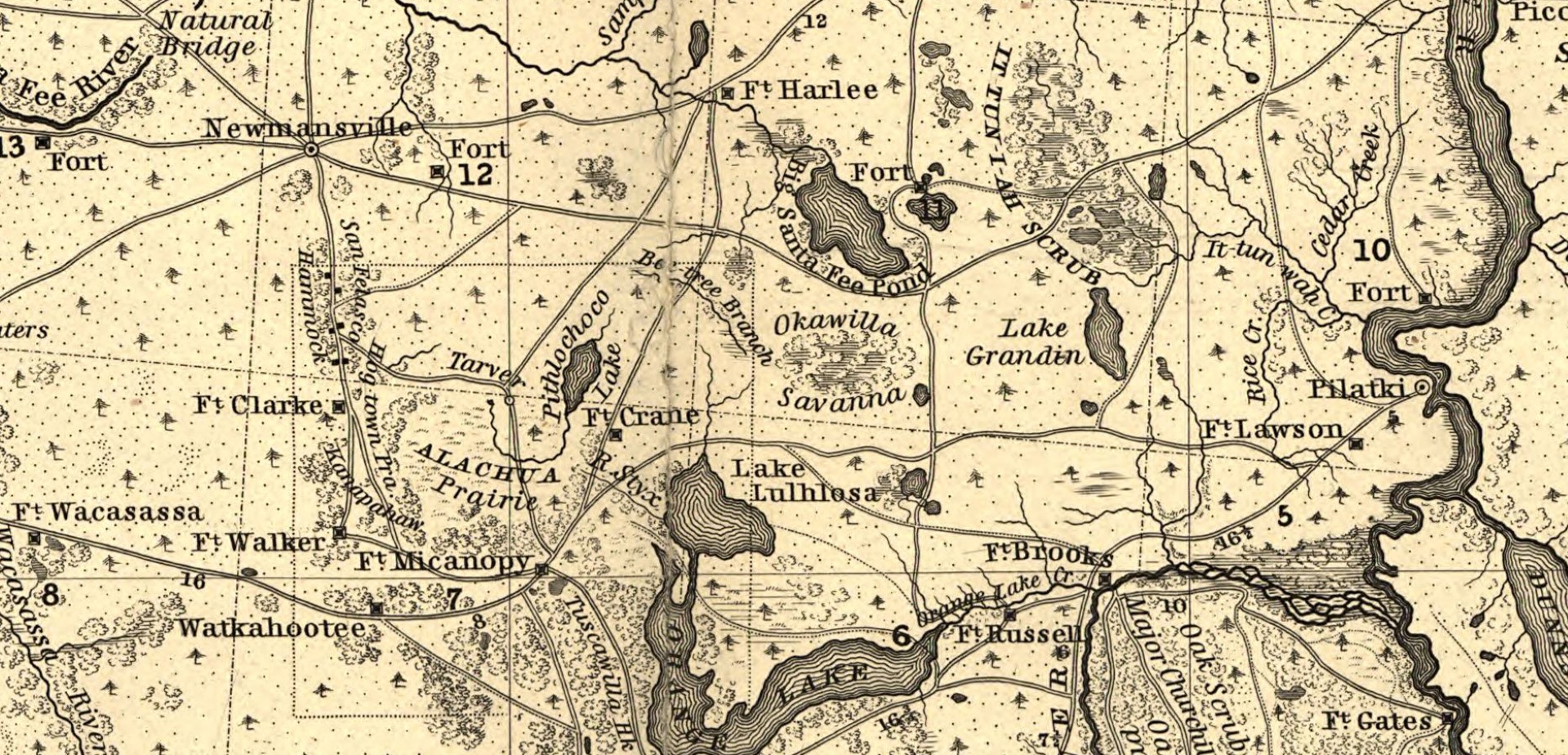 Seat of War map (1839) includes Ft. Micanopy,
Ft. Crane, and Ft. Harlee. Library of Congress
Seat of War map (1839) includes Ft. Micanopy,
Ft. Crane, and Ft. Harlee. Library of Congress
In the 1840s, opportunities to acquire land in Alachua County expanded through initiatives like the Arrendondo Grant and the Occupation Act of 1842. Settlers migrated to the area in search of economic opportunities in agriculture, particularly for crops such as cotton and citrus fruits, especially oranges. Despite ongoing conflicts with the Seminoles, plantation owners from the "older" southern states like Georgia and South Carolina were drawn to Florida's fertile soil as a potential alternative to their over-cultivated land. 1, 2
Continuing conflicts with the Seminoles necessitated a strong military presence in the region as evidenced by the 1840 census of Alachua County which was comprised of military forts; Fort Crane (Rochelle), Fort Harlee (Waldo), Fort Micanopy, and Fort Tarver. Those who displayed courage in settling in Florida's interior chose locations in close proximity to these forts, providing a sense of security and sanctuary in the event of Seminole raids. The Windsor settlement was located near Ft. Crane (Rochelle).
Located on the east shore of Lake Pithlachocco or Newnans Lake, historical resources suggest that the community of Windsor was established as a cotton plantation in 1846 by English cotton planters who gave it the English name of "Windsor." An 1885 publication titled Webb's Historical, Industrial, and Biographical Florida, described Windsor as a community "located on the banks of Lake Newnan. It is an old cotton plantation settled 39 years ago by several planters, whose children still reside here. It is widely believed that, originally, Windsor was settled by English cotton planters, who bestowed the town with its English name, "Windsor." 3
A Gainesville Sun article dated May 23, 1914, provides additional insight into how "Windsor" received its name. According to the account, in 1884, Dr. James Lawrence Kelly, a county superintendent, obtained the tract of land east of Newnans Lake through a lot allocation process. Acquiring the tract entitled Kelly to the priviledge of naming the town. In doing so, he used his wife's maiden name, "Windsor." Indeed, Kelly's wife was named Lillian M. Windsor Kelley.
Before Windsor was founded in 1884, records from an Arrendondo Grant map confirm the presence of Windsor's earliest settlers. The following Arredondo Grant map indicates that the Thigpen, Adams, and Pierce families had established homesteads along the Alachua Trail by 1846. Over the next decade, a significant influx of new settlers, predominantly engaged in cotton farming, established their presence in the region.
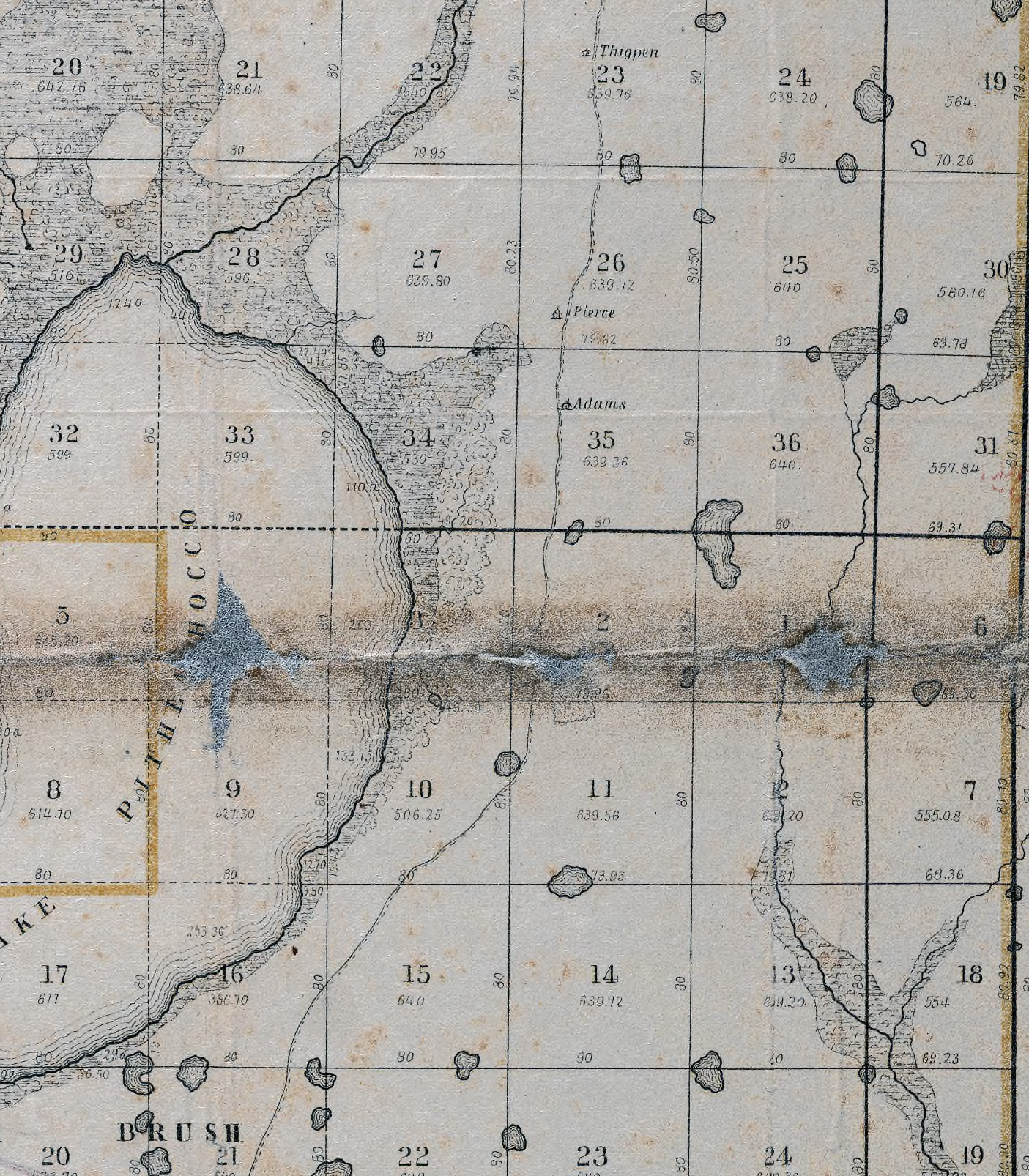 This 1846 map of the Arrendondo Grant shows the Alachua trail as it wanders along the east shore of Lake Pithlachocco
(Newnans Lake) toward Micanopy. The Providence church is located in section 2 of this map. University of Florida Digital Collections
This 1846 map of the Arrendondo Grant shows the Alachua trail as it wanders along the east shore of Lake Pithlachocco
(Newnans Lake) toward Micanopy. The Providence church is located in section 2 of this map. University of Florida Digital Collections
By 1850, north central Florida's allure as a fertile ground for cotton growth began to entice planters from the northern coastal areas, particularly South Carolina. The appeal lay in the suitability of the land for the growth of Sea-Island Cotton, an exceptional, high-quality, long-staple cotton variety that commanded premium prices in the market. Unlike other southern states, where the cultivation of this long-staple cotton was limited to coastal regions due to the influence of both Gulf and Atlantic sea breezes, Florida's unique peninsula provided a distinct opportunity for its cultivation across a broader landscape. It was into this lucrative setting that Windsor's first migrating pioneers, South Carolina cotton planters, made the arduous trek into Alachua County.
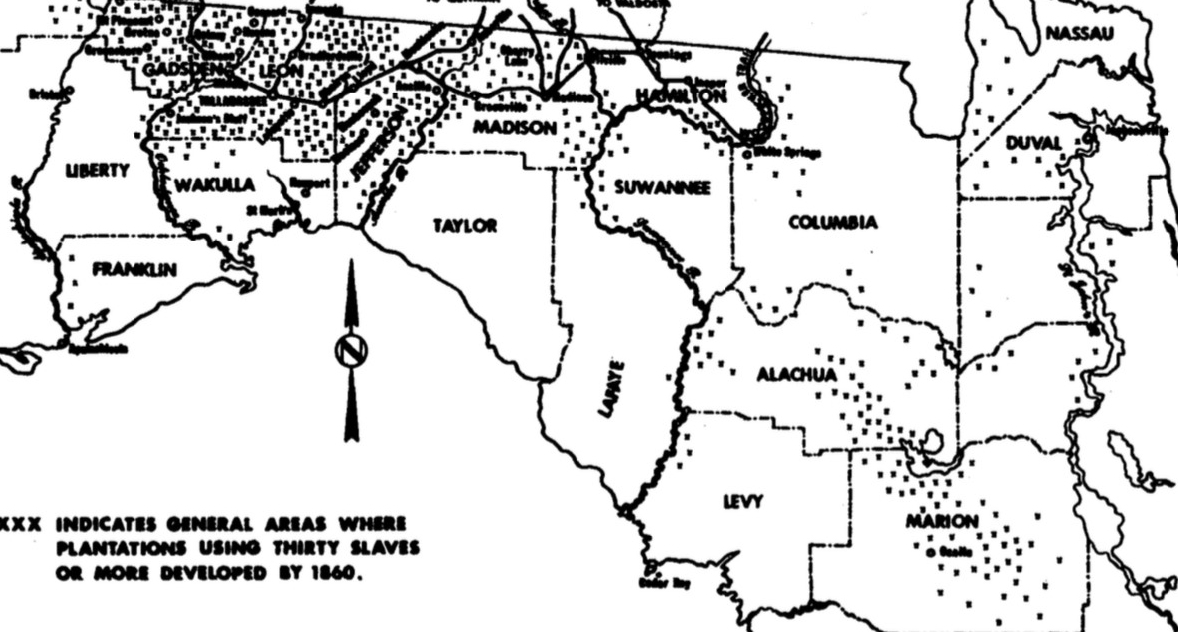 Florida's plantation belt: The dots on this map indicate the
areas where plantations were using thirty or more slaves. By 1860, Alachua County
had become one of Florida's major cotton producing counties, with
Florida surpassing South Carolina and Georgia in the production
of Sea Island Cotton.1, 2
Florida's plantation belt: The dots on this map indicate the
areas where plantations were using thirty or more slaves. By 1860, Alachua County
had become one of Florida's major cotton producing counties, with
Florida surpassing South Carolina and Georgia in the production
of Sea Island Cotton.1, 2
The South Carolina cotton planters who established cotton plantations along the east shore of Newnans Lake in Alachua County were the Reverend John Alexander Kennedy, Colonel Edward Lewis, Daniel Scott, and Reverend Edward L. King (who was the nephew of Edward Lewis). These pioneers, accompanied by their families, enslaved people, and personal possessions, made their journey via steamships on the St. John's River, as well as the "Alachua Trail," a sandy trail which wound its way from the Altamaha River in Georgia south to Micanopy. Alachua County deeds reveal that these early settlers acquired significant parcels of land in the Newnans Lake region. Today, this area encompasses the rural communities of Windsor, Rochelle, and Grove Park.
One can only envision the formidable challenge the new settlers faced in clearing land for agriculture in Florida's untamed and rugged terrain. With vast forests, marshes, and swamps, it could require a year or even two for a small-scale farmer to carve out enough arable land to sustain their family. However, for substantial cotton growers aiming for significant profits from their estates, it was imperative to undertake land clearance, planting, and harvesting with the help of either their own grown sons, hired workers, or enslaved people.1, 2
Edward Lewis arrived in the Newnans Lake region in 1851. Prior to that date, he managed a sizable cotton plantation in the Fairfield District of South Carolina, which he had inherited from his father, William Lewis. The 1840 South Carolina census reported that Edward Lewis owned fourteen enslaved people.
The Lewis family history is documented in a book titled, Edward Lewis, Antebellum Planter of Alachua County, Florida. Within this account, there is reference to the Stringfellow and Dudley families, also hailing from South Carolina, who potentially accompanied Lewis on his journey to Florida, using wagons for transportation. Prior to leaving South Carolina, the 1850 Slave Schedule indicates that Lewis' ownership of enslaved people had increased to thirty-two. They likely made the trip as well. 4
Upon arrival, Lewis undertook construction of an expansive plantation house situated along the Alachua Trail. Though in detiorated condition today, the house is still standing, with a brick first floor and a frame second floor. According to the Lewis Family narrative, the second story landing had two staircases, from which one could see the shore of Newnans Lake. The reconstructed drawing below depicts the houses's initial appearance. By 1860, Lewis' real estate in Alachua County was valued at $20,000 and his personal estate at a healthy $46,715.00. He owned forty-one enslaved people.
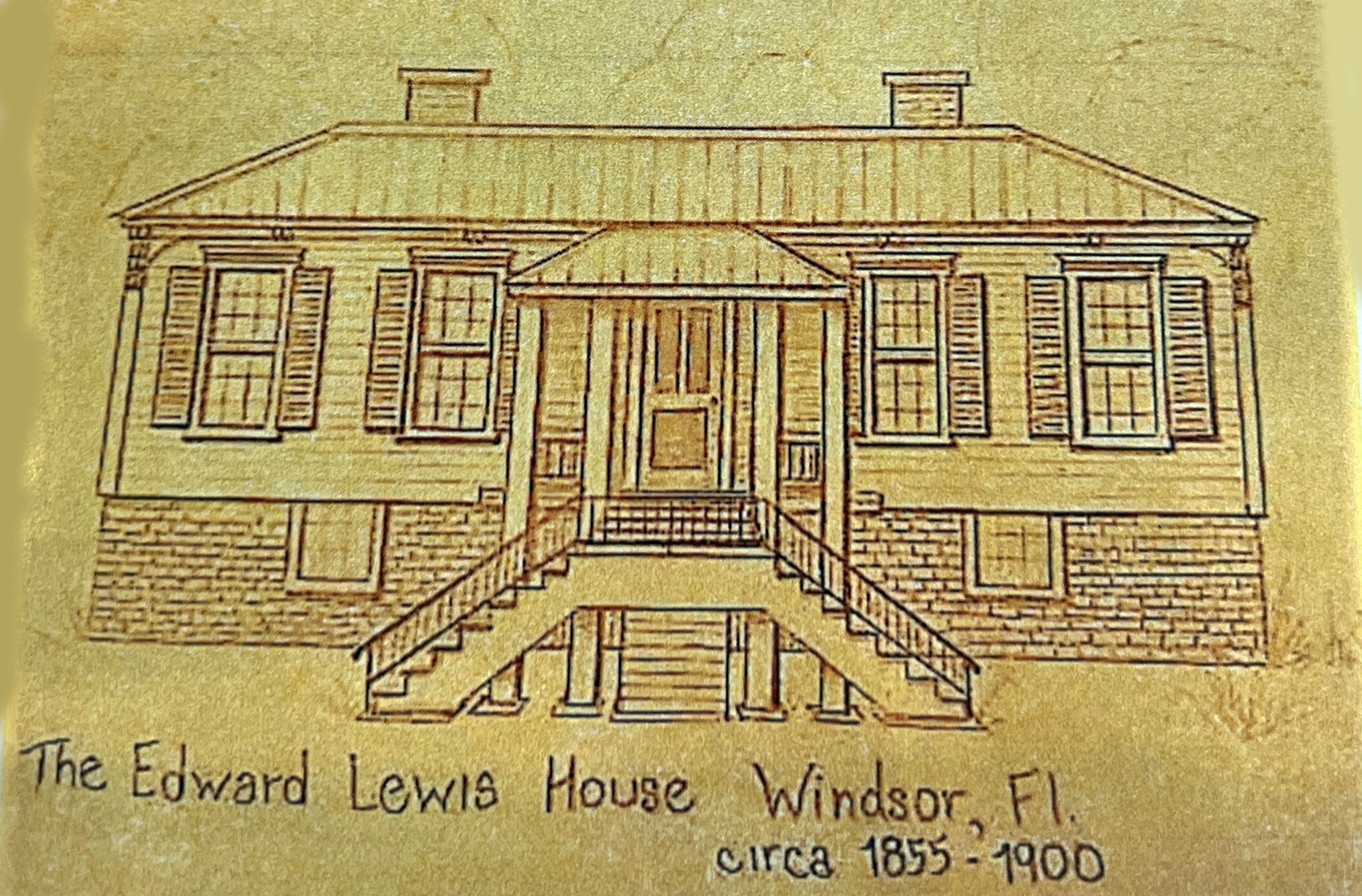 A sketch of the original Lewis Plantation. 4
A sketch of the original Lewis Plantation. 4
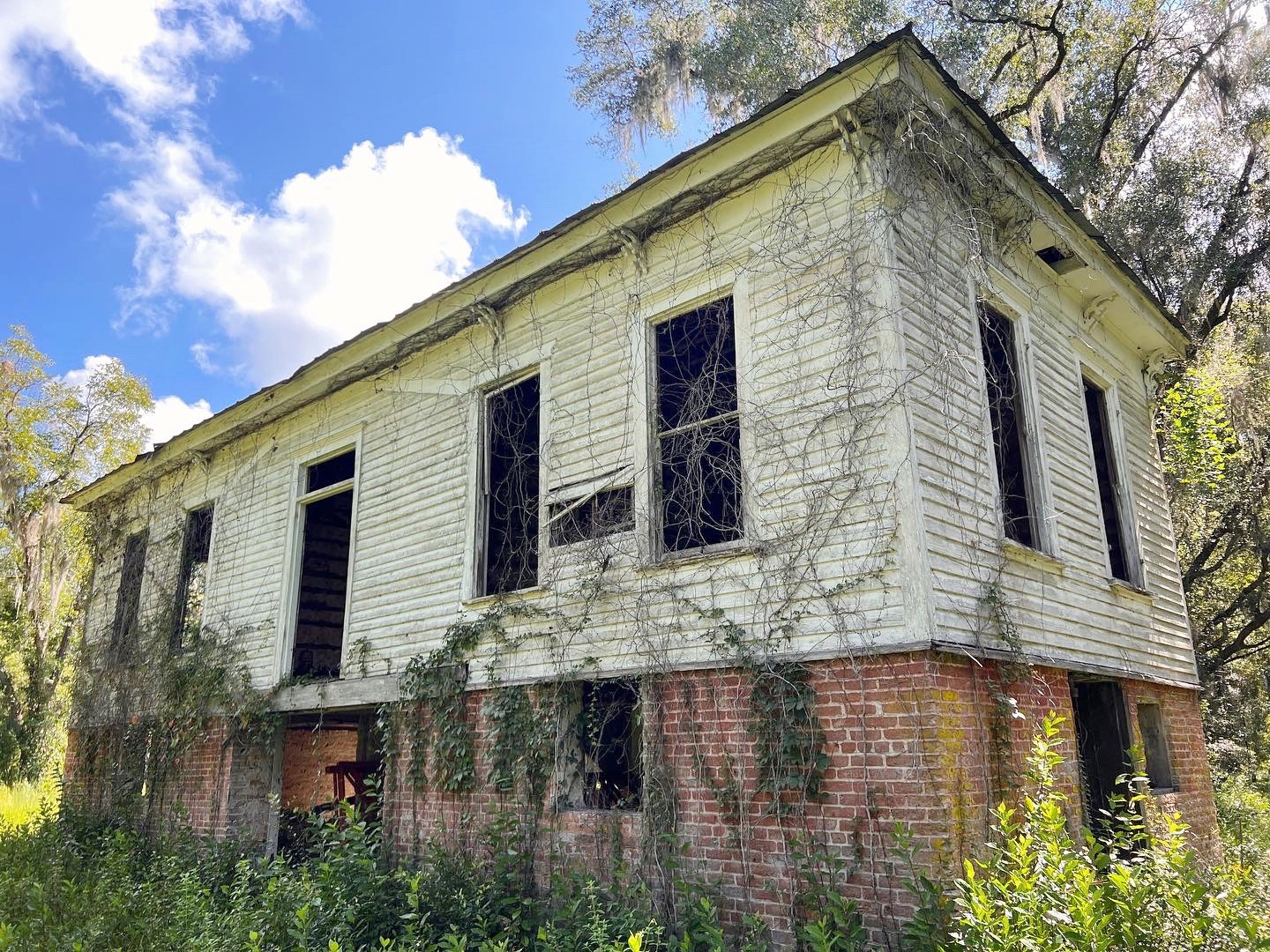 Remains of the Edward Lewis plantation. Built in 1854, this
plantation house was ransacked by Federal troops just prior to the
Battle of Gainesville in 1864. P Marlin
Remains of the Edward Lewis plantation. Built in 1854, this
plantation house was ransacked by Federal troops just prior to the
Battle of Gainesville in 1864. P Marlin
In 1854, James Doig, who had recently arrived in the area from South Carolina, paid a visit to the Edward Lewis plantation. He documented his experience in an article written for The Gainesville Sun, providing a glimpse into life at the Lewis residence. Doig settled in Gainesville, embarking on a business venture in the cotton ginning industry with local businessman H.F. Dutton.
"At dark I reached a place called Fort Crane, just south of Rochelle. It was owned by Colonel Starke Perry, afterwards Governor Perry. I made some inquiry from the negro whom I found at Perry's house, and he told me that Mr. Perry and his family had moved to Micanopy, and that he could not take anyone in.
I asked him then which would be the next house, and he told me it was about four miles north; and the man living there at the time was Colonel Edward Lewis. He was the man I was intending to visit.
On the road I got lost and was in the woods until after 12 o'clock before I reached Colonel Lewis' place. I hollered, and the first negro who came to meet me was the same one who had hauled us from Charleston to our original stopping place in S. C. many years before - Uncle Ned, a negro well known in the whole community.
I remained at Lewis' home for three or four months before I made a break to go anywhere else. I just stayed there, enjoying myself with his son. There were negroes to wait on us, and good horses to ride. It was heavenly.
It was the latter part of March, 1854, when I arrived at the Lewis home. This was located seven miles east of Gainesville, just across from Newnans Lake. The Kings and Lewises were the two prominent families in the neighborhood. I had known the Kings as well as the Lewises, in South Carolina. Mr. King was a Methodist Preacher, but owned Negroes and worked on his farm through the week and preached on Sunday."
In 1853, Daniel Scott, a cotton planter hailing from Fairfield, South Carolina, arrived in the Newnans Lake area with another cotton planter named David Finley. Together, they jointly acquired 2,664 acres of land situated to the east of Newnans Lake. In 1858, Daniel Scott bought out David Finley's share, and by 1860, he had erected a two-story timber-framed residence on the property.
According to the 1860 census, the assessed value of Scott's property was $12,000.00, and his personal estate was appraised at $30,000.00. During the same year, the plantation was home to over 60 enslaved people who resided in 12 one-room cabins and worked the land, producing 26,000 pounds of sea island cotton, along with crops such as peas, corn, sweet potatoes, and hay.
In 1866, Daniel Scott sold his plantation to Reverend Edward L. King and departed the region. However, he later returned and reacquired the plantation in 1871. Today, the original supporting pillars of the house can still be observed along Highway 20 in Alachua County.
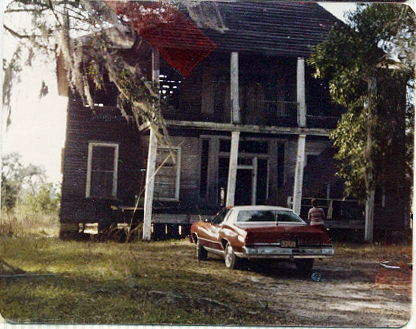 A photo of the abandoned Daniel Scott plantation taken by the
author's grandmother in the 1970s.
A photo of the abandoned Daniel Scott plantation taken by the
author's grandmother in the 1970s.
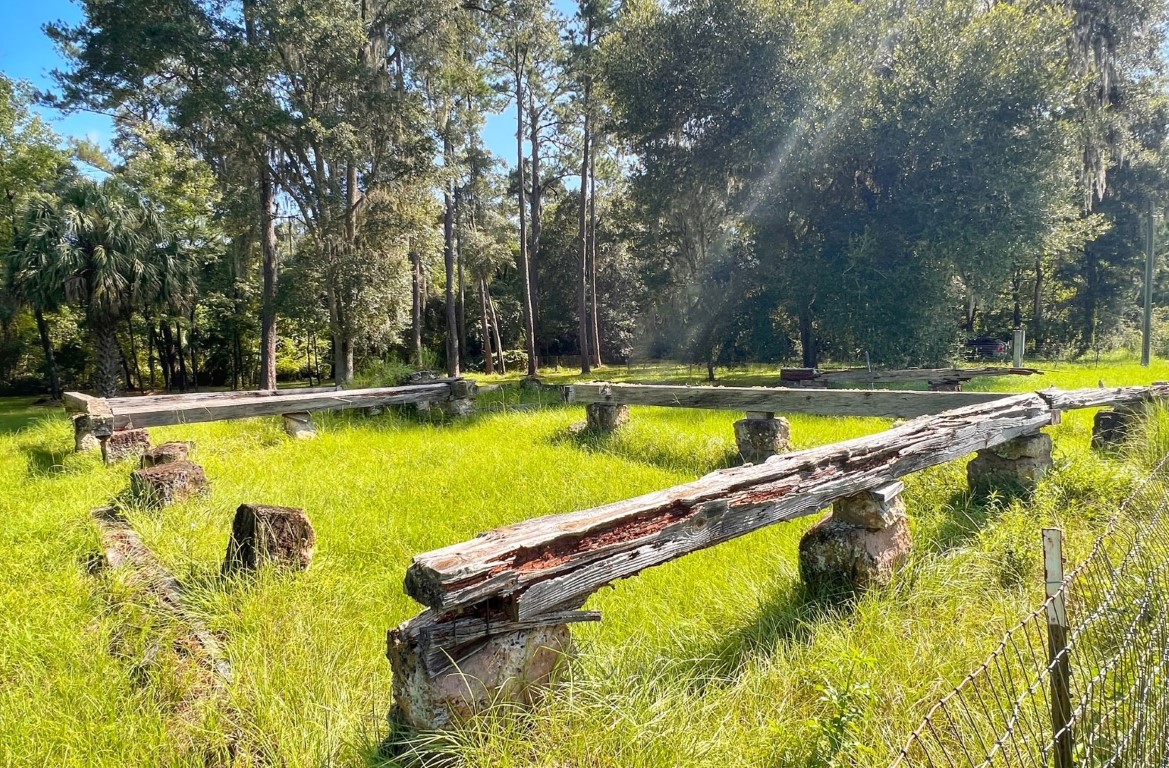 Supporting pillars of the Daniel Scott plantation. A historical
marker stands on this site today. P Marlin 2023
Supporting pillars of the Daniel Scott plantation. A historical
marker stands on this site today. P Marlin 2023
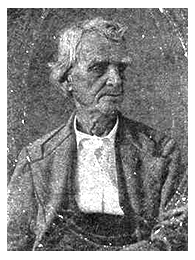 Originally from Camden,
South Carolina, Reverend John Alexander Kennedy emerged as one of
the earliest cotton planters to establish his presence in the
Newnans Lake region. His heritage can be traced back to William Kennedy,
a native of Scotland, and Mary Topham, whose family counted among
the "pioneering converts to Methodism in America." Kennedy joined
the Methodist church in Camden, South Carolina, in 1808 and attained
his preacher's license in 1821, subsequently being ordained as a
local Deacon in 1835.
Originally from Camden,
South Carolina, Reverend John Alexander Kennedy emerged as one of
the earliest cotton planters to establish his presence in the
Newnans Lake region. His heritage can be traced back to William Kennedy,
a native of Scotland, and Mary Topham, whose family counted among
the "pioneering converts to Methodism in America." Kennedy joined
the Methodist church in Camden, South Carolina, in 1808 and attained
his preacher's license in 1821, subsequently being ordained as a
local Deacon in 1835.
Records of Kennedy's arrival in Alachua County are cited in a 1914 Gainesville Sun article, "Mr. John A. Kennedy, came to this area from South Carolina in 1854, accompanied by a group of enslaved individuals, with whom he managed a substantial cotton plantation." Deeds and local electoral records indicate that Kennedy had established himself on the eastern shores of Newnans Lake as early as 1848. The 1850 Alachua County Slave Schedules document nine enslaved individuals working on the Kennedy plantation. By 1860, this number had risen to twelve. Kennedy's real estate holdings were valued at $15,000.00, with a personal estate worth $12,000.00.
John Alexander Kennedy played a role in introducing Methodism to the region by founding a Sabbath Day school named "Indian Bay," on or near his property. Kennedy's obituary reveals that he was "zealous for the salvation of those who had hovered for a generation on the frontier of the Seminoles. The societies formed by him then now embrance one station and the greater part of three flourishing Circuits in the Florida Conference."
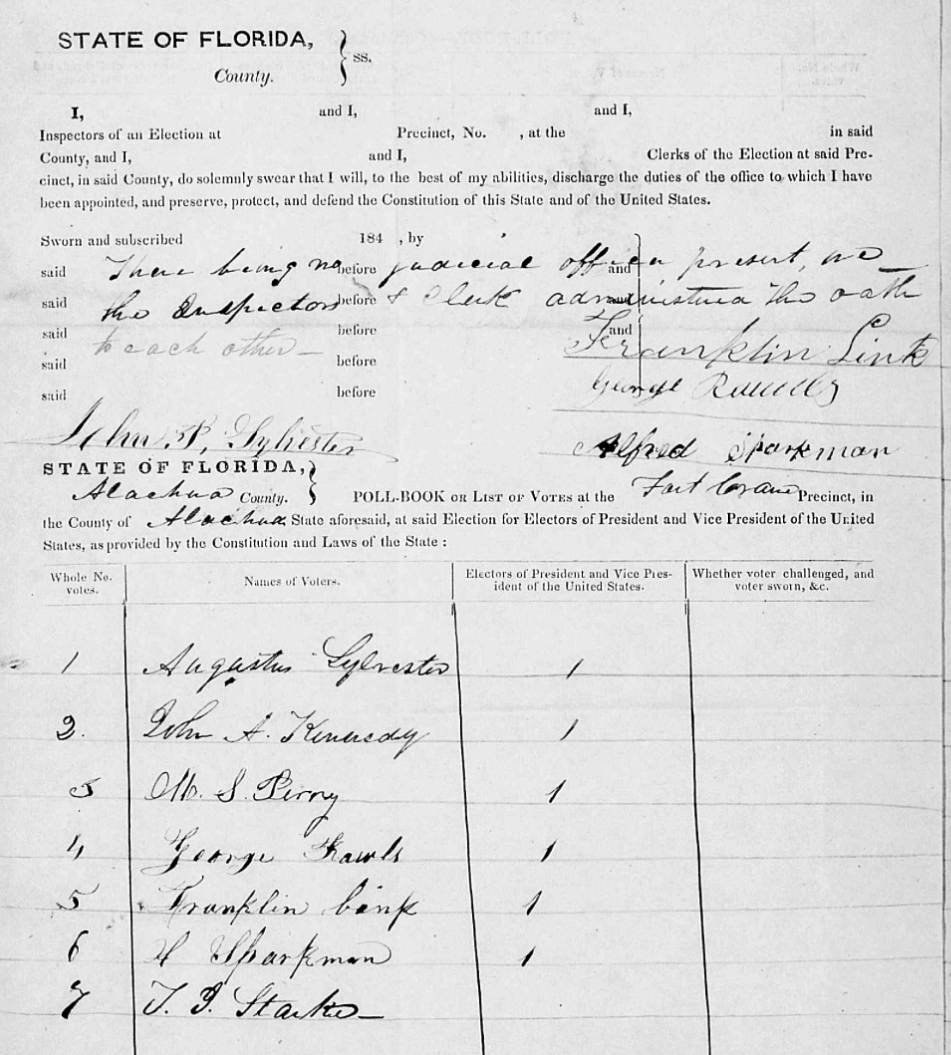 Ft. Crane election records (1848). John A. Kennedy is
listed as a voter. Family Search Records
Ft. Crane election records (1848). John A. Kennedy is
listed as a voter. Family Search Records
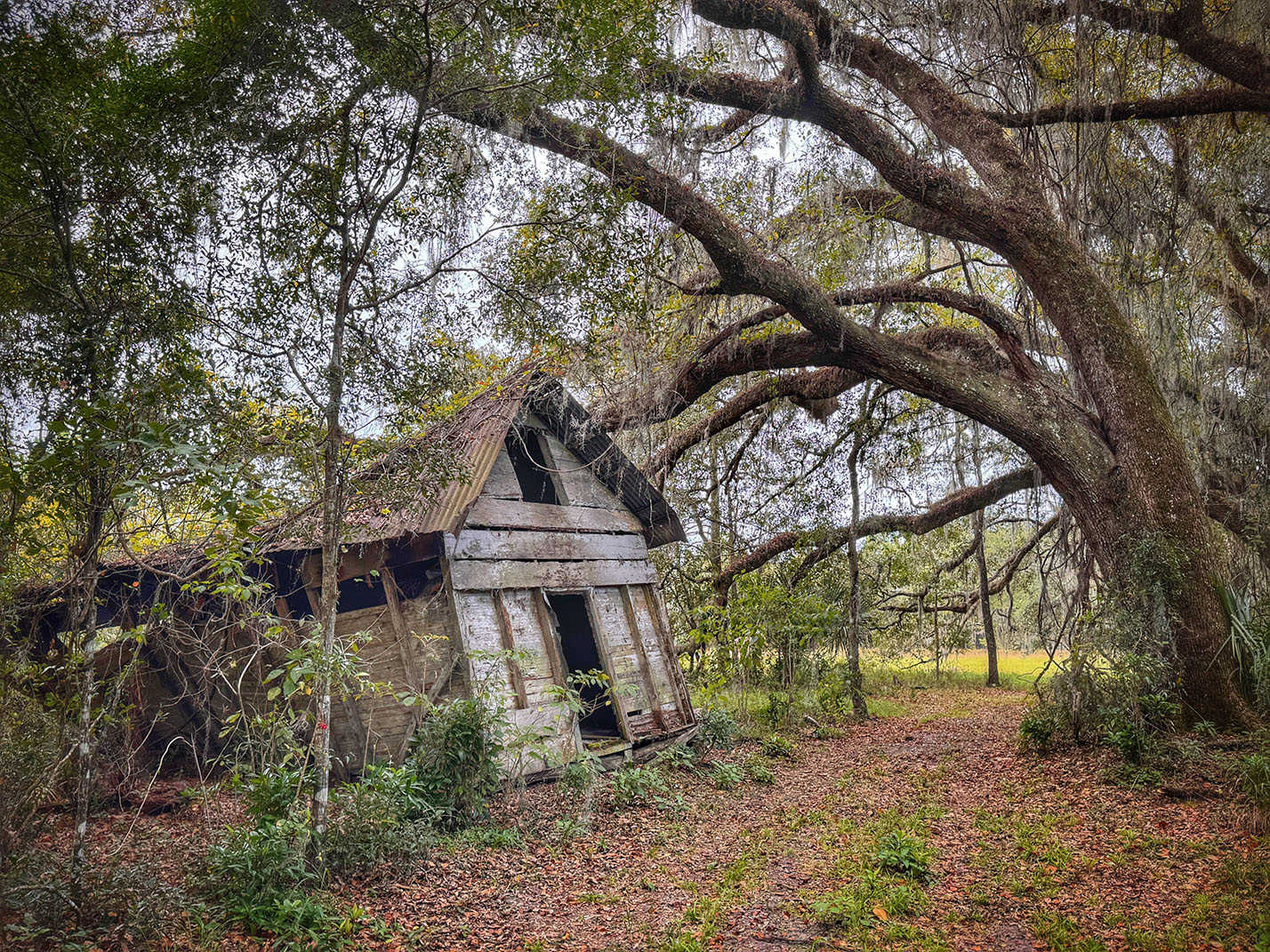 An old building sits on what was once the Kennedy property
located along the Alachua Trail. P Marlin 2023
An old building sits on what was once the Kennedy property
located along the Alachua Trail. P Marlin 2023
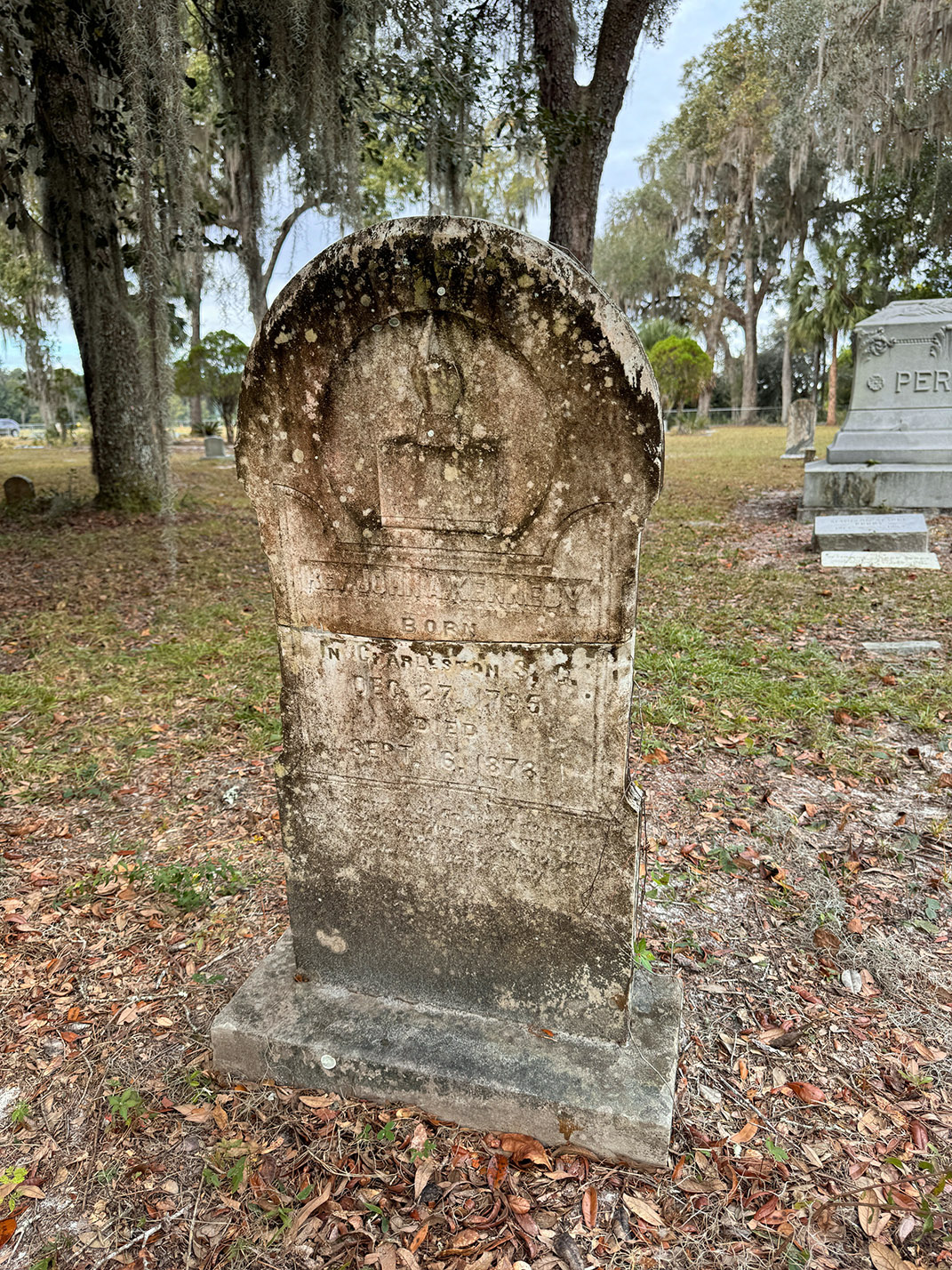 John Alexander Kennedy burial site at the Oak Ridge Cemetery
near Rochelle and Micanopy. Kennedy is buried near
Florida's governor, Madison Perry. P Marlin
John Alexander Kennedy burial site at the Oak Ridge Cemetery
near Rochelle and Micanopy. Kennedy is buried near
Florida's governor, Madison Perry. P Marlin
Edward L. King, a cotton planter and a young Methodist minister from the South Carolina Conference, arrived in Alachua County in 1853. An article from the Florida Times Union (1966) recounts King's arrival in Florida, "He'd come bringing 200 slaves to hoe his cotton, for the caterpillar had vanquished his crop back home." Another article from The Gainesville Sun (1914) also recalls King's arrival, "E.L. King came to the present site of Windsor as early as 1852 and settled upon a large tract of land. He brought fifty or sixty slaves with him and soon became one of the largest and best farmers in the whole State."
The 1850 Sumterville, South Carolina, Slave Schedule indicates King had six enslaved people. Potentially, he purchased additional enslaved people before arriving in Alachua County. By 1860, the Alachua County Slave Schedule indicates that King had increased his enslaved people to 25. In the same year, King's real estate was valued at $20,000.00 and his personal wealth at $30,000.00.
In addition to a establishing a large cotton plantation, King founded and became first pastor of the Providence Methodist Episcopal Church, South, of Windsor.
"There's no one out today but crows and Methodist ministers." 5
The importance of establishing a place of worship was a priority to the planter class as evidenced by the numerous small churches that sprang up within Florida's plantation belt. Methodism was established as courageous circuit riders embarked on journeys from Georgia and South Carolina into the newly formed Florida territory. These circuit riders traveled from settlement to settlement, often through perilous and remote regions, epitomizing a tale of enduring faith and resilience. In 1822, the new religious outreach in the Florida territory fell under the jurisdiction of the South Carolina Conference. Twenty three years later in 1845, the Florida Conference was established. This inaugural event occurred one month prior to Florida becoming a state.
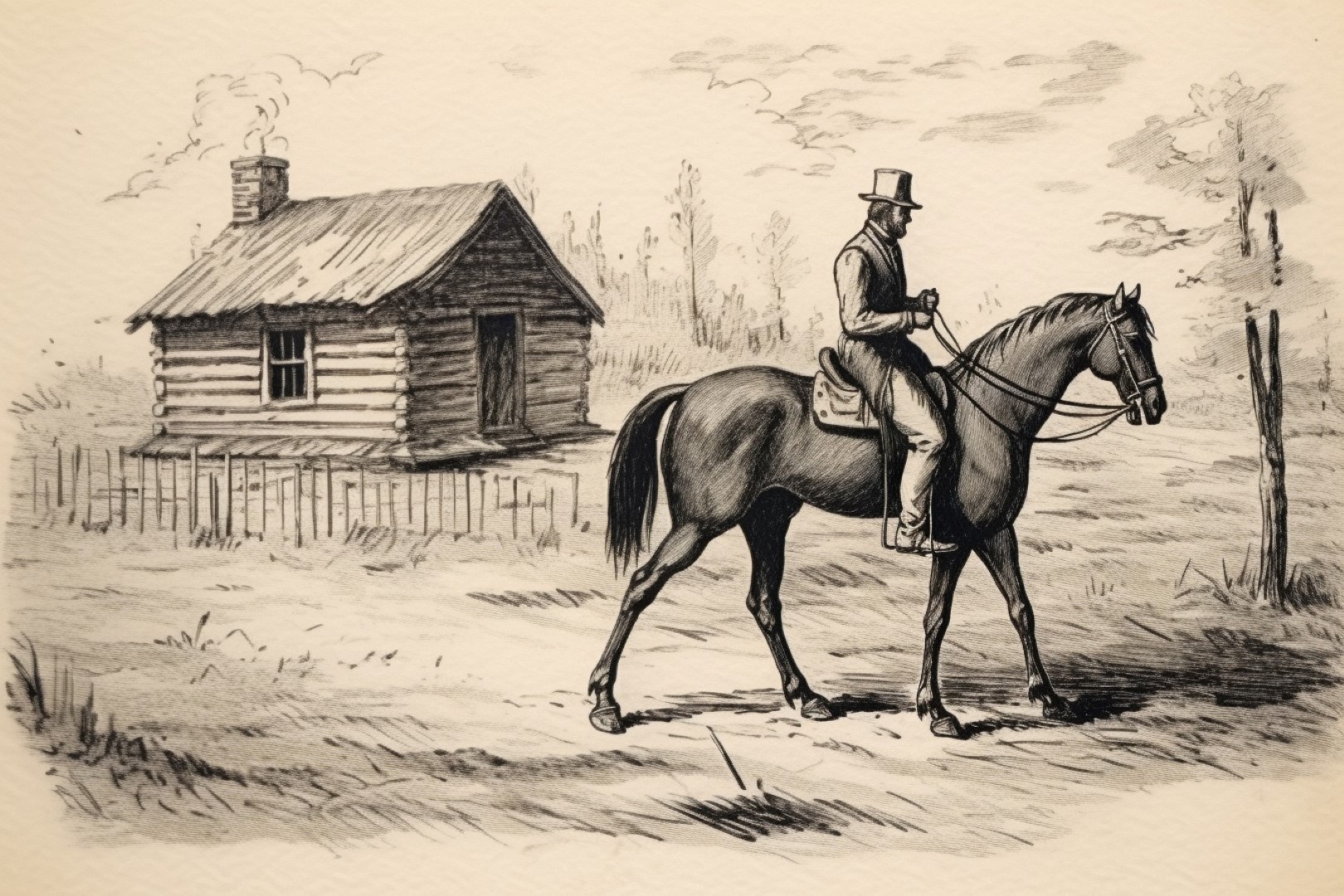 A representative sketch of a log cabin church and a
Methodist circuit rider. P Marlin
A representative sketch of a log cabin church and a
Methodist circuit rider. P Marlin
Prior to his arrival in Alachua County, Edward L. King was well established within the South Carolina Methodist church outreach circuit. Born in the Fairfield District of South Carolina in 1819, he was educated as a young man at the Cokesbury Conference School. While pursuing his studies, he converted and was admitted to the Church of Christ. In 1839, he obtained his license to preach and was admitted on trial to the Methodist South Carolina Conference. King began his years of service by working the Columbia Circuit and the Rocky Mount Mission, which was described an 1841 article in the Cheraw Gazette as, "15 plantations, 317 colored members, 144 of whom were received last year. 107 little negroes received catechetical instruction."
In 1844, King's work with the South Carolina circuit continued as he was appointed pastor at Pleasant Grove. From 1845 to 1851, King continued to be involved in various Methodist missions and circuits, including the St. Matthews Mission in 1845, the Lancaster Circuit in 1847, the Wateree Mission from 1848 to 1849, Sumterville in 1850, and the Cooper River Circuit in 1851. The 1850 South Carolina census lists King as a "Methodist Clergyman" with an industry of "Welfare and Religious Services." An 1884 publication titled, The History of Methodism in South Carolina, by Reverend Albert M. Shipp, describes King as, "a man of vigorous mind, sound judgment, deep piety, and amiable disposition. As a preacher, he was plain, earnest, practical, always conveying to the minds of his hearers the impression that he was deeply convinced of the truth of what he was preaching." 6
The Florida census acknowledged King's ministerial duties by listing him as a "Methodist Minister & Planter." As a minister, King adhered to a disciplined lifestyle in addition to his cotton farming duties. This ministerial calling necessitated unwavering devotion and a commitment to acquiring knowledge through diverse pursuits, ensuring continuous spiritual development. Among these responsibilities, personal Bible study stood as the foremost duty for a minister, commencing early each morning and continuing throughout the day. Methodist ministers were frequently referred to as "men of one book." Within the Methodist community, the belief in the divine inspiration of scriptures was universal, and no other book was deemed "equal to the Bible." 4
King surely grappled with the issue of enslaved people. John Wesley, the founder of the Methodist church, strongly opposed slavery as did other Methodist leaders. In 1784, the church issued a statement directly challenging slavery. Though an effort was made to prohibit slavery, many Methodist members and ministers "justified" it using scripture. This faction vehemently opposed the anti-slavery stance causing Methodist leaders to abandon the declaration of 1784. This led to the split of the Northern and Southern branches of the church, each with its own position on slavery. The Methodist Episcopal Church, South, was established in 1845 and explicitly supported slavery.
The initial indication of King's plan to establish a Methodist church in the Newnans Lake Region of Alachua County can be traced back to an agreement signed on December 12, 1851. In this document, Frederick Marquand, a silversmith from New York City (via attorney George F. Fairbanks), agreed to sell 640 acres of Section 2 in Township 10, Range 21 and other lands to E.L. King (these land parcels were part of the original Arredondo Grant). The terms of the agreement specified a purchase rate of 50 cents per acre. Notably, King made an initial payment of $213.33, with the remaining amount to be paid within one to two years from the agreement's date. On May 13, 1853, seventeen months after the original agreement, King made a final payment of $950.00 (deed) finalizing the original purchase agreement.
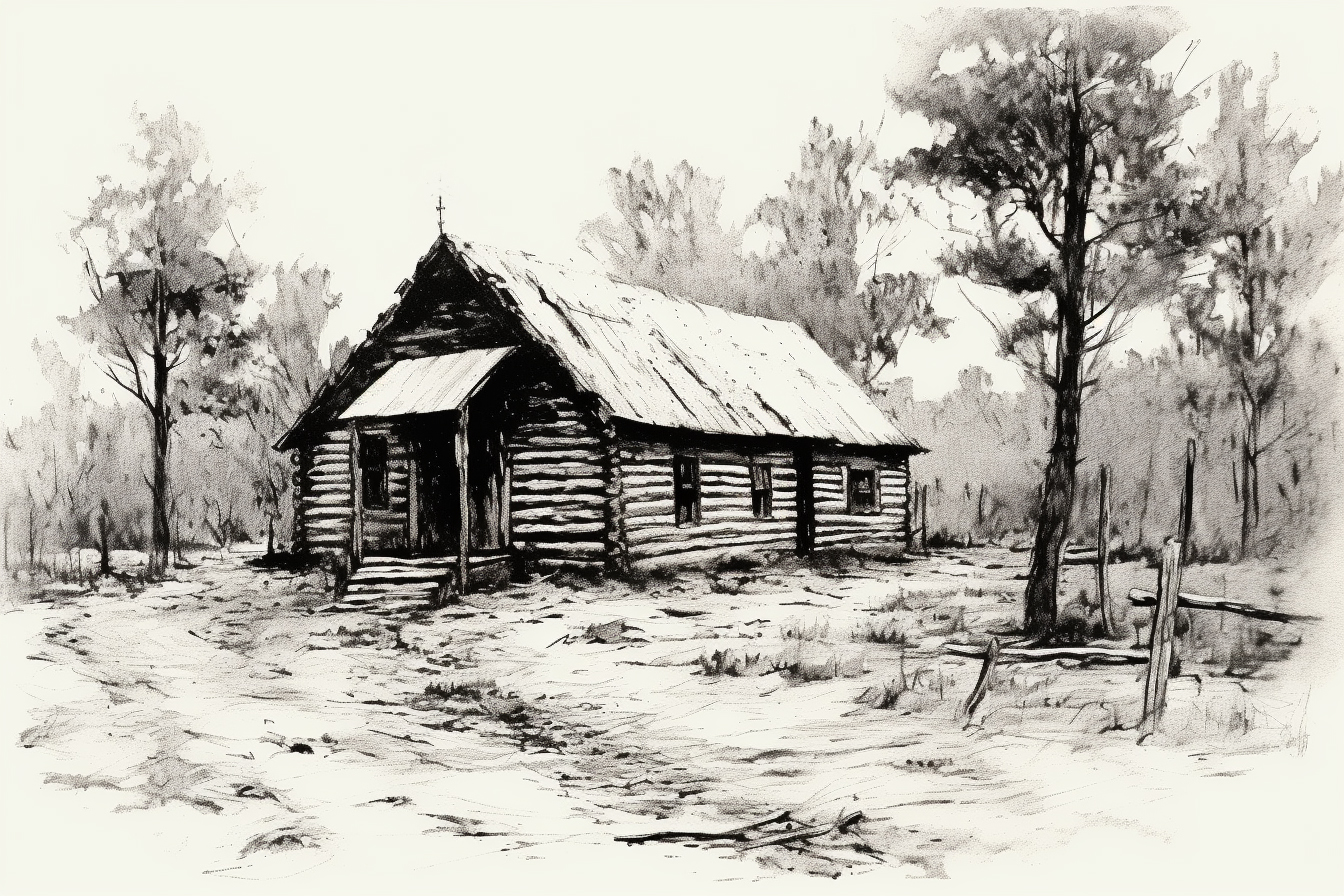 A representative sketch of an early log cabin church. P Marlin
A representative sketch of an early log cabin church. P Marlin
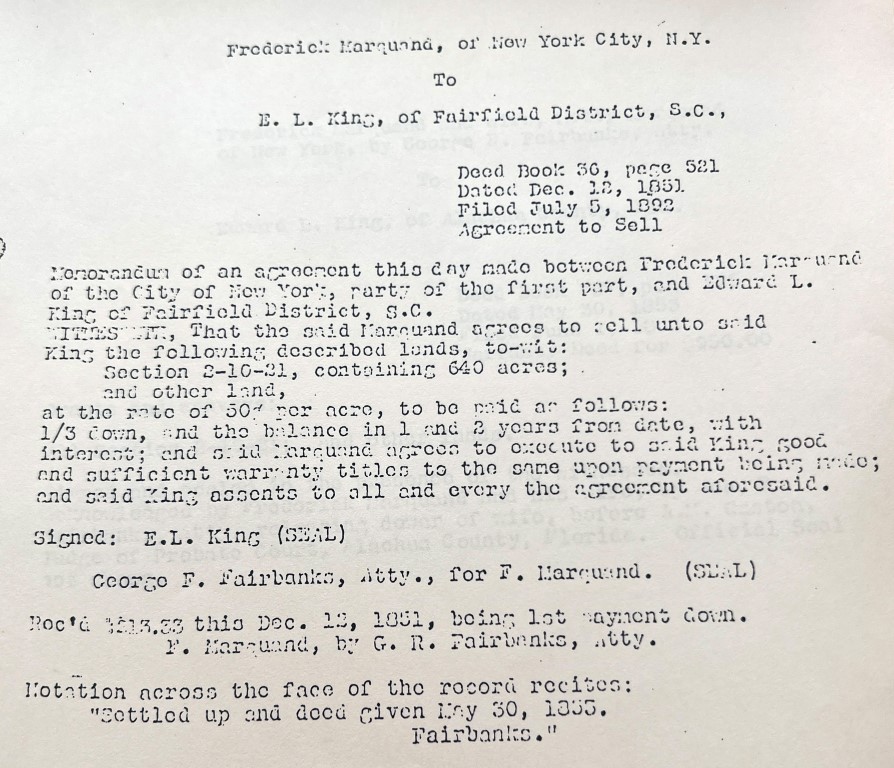 Windsor Providence Methodist Church Abstract of Title book.
Windsor Providence Methodist Church Abstract of Title book.
Upon acquiring the property, King began the task of clearing land and building a place of worship, likely with slave labor. The pine log building, to be named the Providence Methodist Episcopal Church, South, was constructed with hand-hewn longleaf pine logs which were abundant in the area. Joseph F. Bell, who was raised from a young child in the Providence church, described the inaugural church in a letter dated 1951, "The first house put up was built of pine logs, stood east and west, with that oak tree out at east front. But a much smaller tree then. The present building was erected I think about 1882 or '83."
A 1951 Gainesville Sun article indicates that, in the early days of the church, "men and women church-goers were segregated with the men on one side of the church and the women on the other. A gallery was provided for negro slaves." The following excerpt from Gainesville resident James Doig's also provides details of the church's early days, including the church's interior, the congregation, and Rev. Edward L. King. Written for The Gainesville Sun in 1917, the article was titled, "Reminisicenses of Early Days."
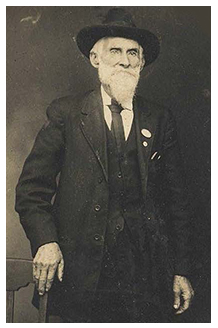 Image: James Doig
Image: James Doig
"As I have been asked to give some of my experiences of camp life during the early days after reaching this section, I will tell of my visit to a country church and how things were carried on in religious matters. My first visit was at old Providence church near Col. Edward Lewis and Parson Kings' plantation now called Windsor. I found many good people and nearly all of them invited me to go home with them. Not like the people of today, in a very big hurry, not even waiting to shake hands.
My first intention was to see where all these people were coming from, but behind the woods was moving with them. Some of the mules, some with oxen, but few horses and the most of them were walking. Some with shoes on, some barefooted and some with homemmade hats of palmetto. Very pretty, not like what is worn today - like a flower garden. The shoes were home-made, broad and comfortable, not like an Indian canoe sharp at both ends with the heel in the middle. The clothes mostly worn those days were hoop skirts made with steel hoops, some of bamboo cane and plenty of distance to walk in, not like the hobble skirts today, that make them jump up and down.
The most amusing thing that the writer saw was an old man that drove up at the church with a home-made cart made of split boards shaved off pine poles, run through the stirrup leathers, he riding straddle, holding down the counter balance, while the old lady and his grown daughter were in the cart. But unthoughtedly he jumped off and dumped the old lady and daughter nearly right on me. I thought that was a new way of unloading, but everything was covered up satisfactorily after the old lady had given him a good sermon.
Well, we all went into the church; there I saw many good people, and a great many old slaves that belonged to the different farms of the surrounding country. Some of them knew me from boyhood and it surely made me feel good, but not like one of my old friends, John. T. Matthews, that got so good that he got to shouting and an old lady called to her husband to get a lightwood knot and kill him as he would not hold out. And sure enough, he did not, for the writer saw him many times after in a condition that it would take all the trees in Gainesville to hold him up.
Now the writer will give you a statement as to the kind of furniture we had at that time. The seats were split logs with peg legs, not like the comfortable seats today that will put you to sleep so the preach has to holler out loud enough to wake up the dead. The man that preached was well known throughout this part of the country; his name was Parson King, one of the best Methodist preachers known at that time. He was no dude, but one of the best farmers of this section of the country. Worked all the week with his negroes, and preached on Sunday for the good of the people, free of charge at that time. Both white and black went to the same church of God, and mingled together, they prayed together. Oh! those good days that are passed are gone!"
The establishment of the Providence church wasn't the sole instance of King's involvement in the area's Methodist endeavors. He also had a brief role with the East Florida Seminary in the nearby town of Micanopy (not to be confused with the East Florida Seminary in Gainesville). Founded in 1852 by Methodists, Micanopy's East Florida Seminary operated under the authority of the Florida Annual Conference of the Methodist Episcopal Church, South. Originally, its purpose was to serve as a literary and not a theological institution, where students would receive an English and Classical education without any emphasis on teaching Methodism.
Facing challenges such as low enrollment, financial constraints, and inadequate management, the Seminary ultimately closed its doors in 1860. Deed records indicate that King held a position as a trustee in 1854 but resigned his position a year later on July 25, 1855. 7
Edward L. King, through his mother Elizabeth Lewis, was the nephew of both Edward (previously mentioned) and his brother, John Lewis. John Lewis, accompanied by his wife Nancy Buchanan Lewis, had relocated to the Newnans Lake area in 1851. Orphaned at a young age, King and his sister, Rebecca, found a nurturing maternal figure in Nancy Buchanan Lewis, who played a vital role in their upbringing. King's deep appreciation for Nancy was expressed in the following article he wrote upon her passing.
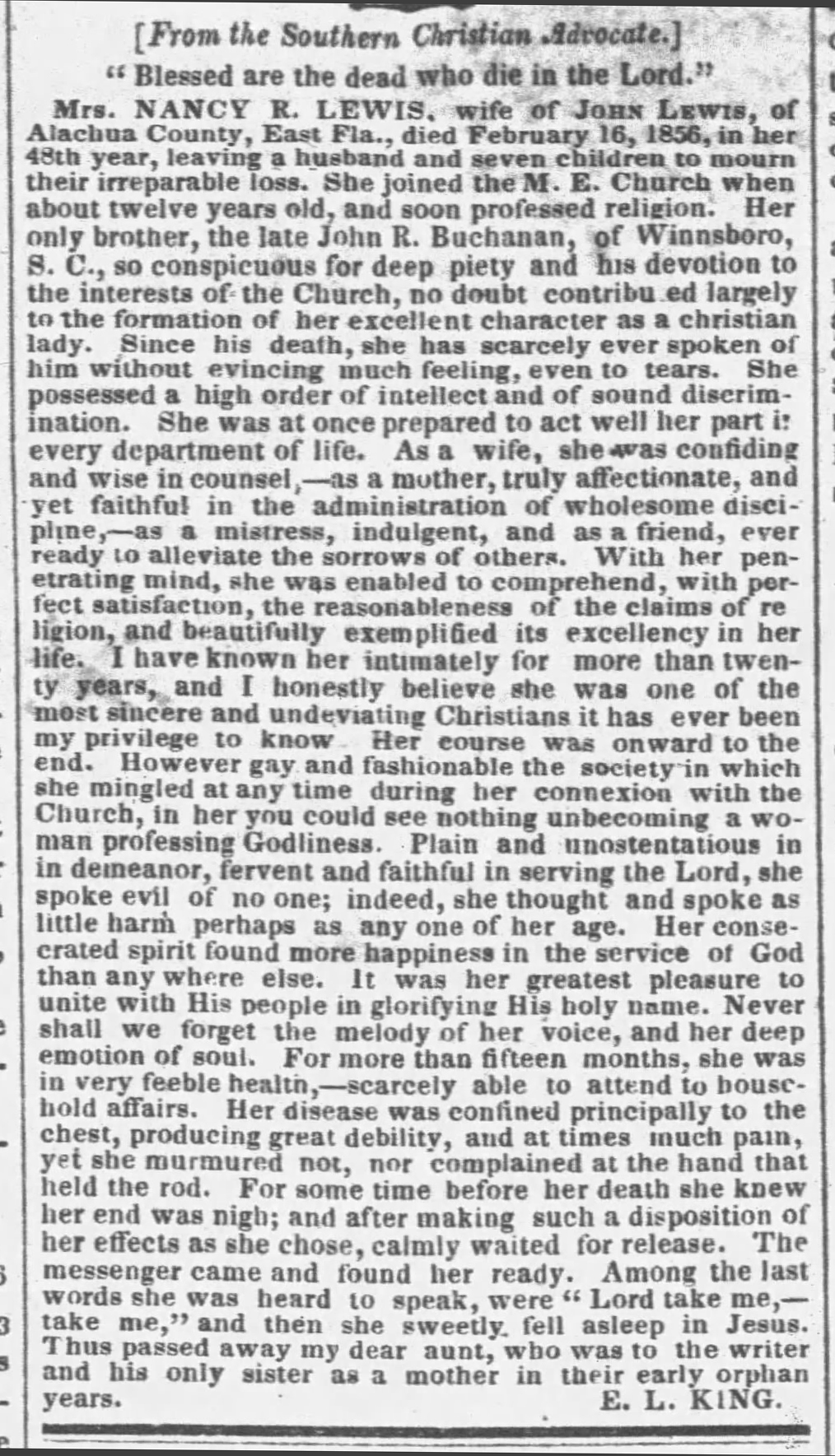 The Charleston Daily Courier April 18, 1856
The Charleston Daily Courier April 18, 1856
Apart from his connection to the Lewis family, King also had family ties to the Picket family of South Carolina through his mother's sister, Rebecca. Rebecca's children, Philip and J.R. Picket, both served as Methodist ministers. The Micanopy Gazette featured an article drawing a correlation between the preaching styles of Edward L. King and his first cousin, J.R. Picket.
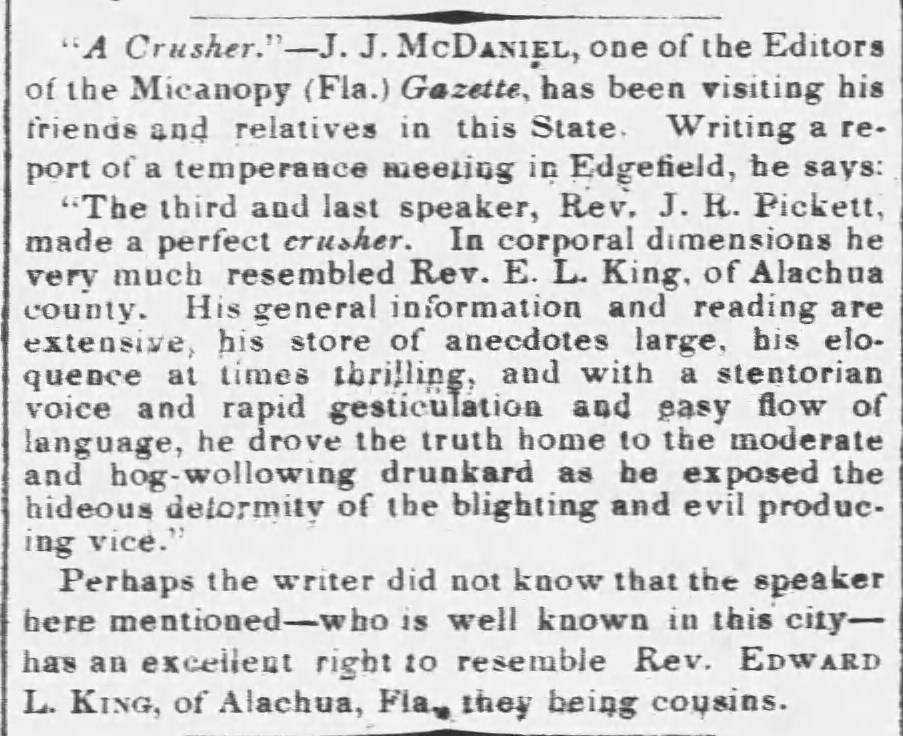 The Charleston Daily Courier August 29, 1860
The Charleston Daily Courier August 29, 1860
Windsor's established cotton plantations continued to thrive into the 1850s. By 1860, Alachua County had firmly established itself as one of Florida's leading cotton-producing regions, with the total value of real estate skyrocketing to more than seven times its 1850 worth. Only six Florida counties surpassed Alachua County in cotton production. The higher value Sea-Island cotton variety undoubtedly bolstered the profit margins of Windsor's farmers and planters. This way of life was in jeapardy, however, as the dispute over slavery led to the secession of the southern states, including Florida, in 1861. With the onset of the Civil War, the livelihood of cotton plantation owners faced a substantial threat. 1, 2
Windsor remained largely untouched by the Civil War until August 1864, when Colonel Andrew L. Harris, leading Federal (Union) troops, confronted J. J. Dickison, the Confederate forces' commander in nearby Gainesville. This event became known as "The Battle of Gainesville." In the days leading up to this conflict, Federal troops passed through the cotton plantations of Edward L. King, Edward Lewis, and John A. Kennedy. The route taken by the Federal troops is documented in a 1917 issue of the Gainesville Sun, stating, "In August 1864, a Federal force advanced from the St. Johns River on the morning of August 17, 1864, and occupied Gainesville, having traveled through Baldwin, Starke, and then east of Santa Fe and Newnans Lake."
A further detailed account of the battle and the days preceding it are told in a 1864 article in the The Charleston Daily Courier, "On the night of the 15th, about 11 o'clock, the Church bell tolled, and a number of the "Gainesville Guard" shouldered their muskets and proceeded to the Courthouse for orders, and in a short time twenty were on the train moving at a rapid rate to reinforce Captain Dickison at Waldo." These reinforcements provided a fascinating account of the Federal troops' raid through the plantations:
"The night was very warm, and there was so much water on the road that it was impossible for the infantry to keep up, most of the troops being old men and boys. When we reached the plantation of Rev. E.L. King, we learned that the enemy had passed and stole all the negroes, horses and mules belonging to Col. Edward Lewis. We pressed on and soon arrived at the place. Being broken down completely, we called up Mrs. Col. Lewis and asked if she had a horse to spare; she replied that she would give one with pleasure, but the Yankees had taken about 50 negroes, all of her mules and horses, and all of her clothing except what she had on her person. We still pressed on in hopes to be in time, knowing that the intrepid Dickison was about one hour behind the Yankees, and two hours ahead of us. Just as we reached the plantation of Rev. J.A. Kennedy, we heard the roaring of a cannon and knew that fighting had commenced."
The Battle of Gainesville resulted in a victory for J.J. Dickison and the Confederates. This victory ensured that Gainesville remained under Confederate control for the duration of the war. In recognition of his courageous deeds, plantation owner Edward Lewis generously presented Dickison with a horse as a token of appreciation.
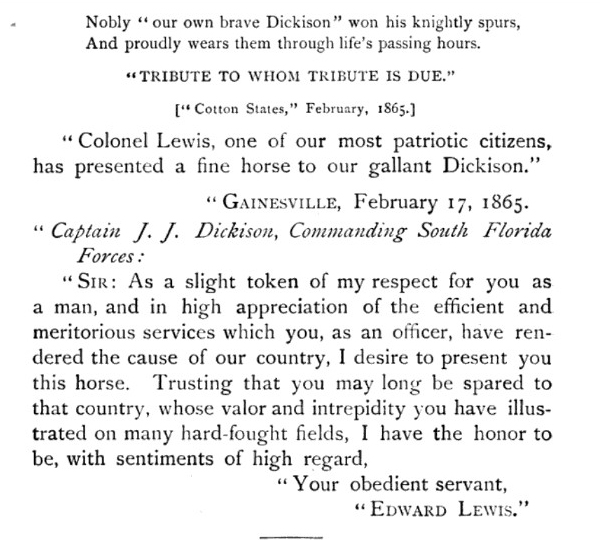 Excerpt from Dickison and His Men by Mary Elizabeth Dickison
Excerpt from Dickison and His Men by Mary Elizabeth Dickison
Florida, like other Confederate states, enacted conscription laws to raise and maintain troops for the Confederate army. These laws mandated the draft of eligible men into military service. The 1862 Conscription Act required all white men of a certain age to serve in the military, however, some exemptions were allowed. The number of preachers, physicians, and county officials seeking exemption under Confederate law grew significantly. Recruiting officers, dealing with various forms of subterfuge, became adept at interpreting the law in ways that favored their recruitment efforts, leading to a reduction in the number of those exempted from conscription. If conscripted individuals had any legal justification, they often resorted to appealing to the state courts.
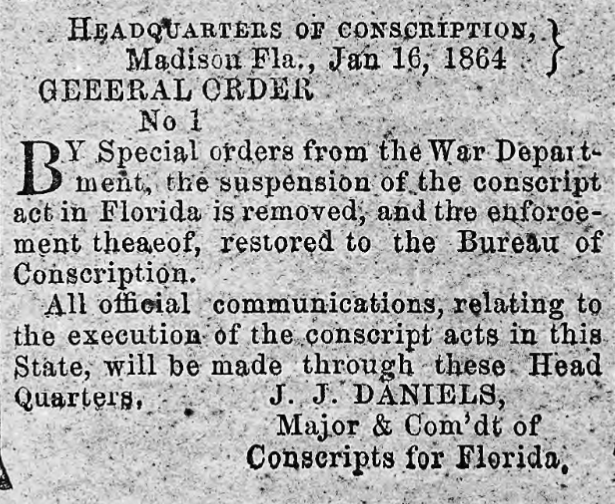 Cotton States March 19, 1864
Cotton States March 19, 1864
In an interesting turn of events, Edward L. King was arrested in October 1864 by Major James Jaquelin Daniel, the Commander of Conscripts for Florida, for owing military service. King had likely sought an exemption for military service due to his ministerial duties. Upon arrest, King was presented to the Judge of the Suwannee Circuit where he exhibited his ministerial credentials. This was to no avail, however, as King's case went all the way to the Florida Supreme Court. Once arguments were heard, the Florida Supreme Court exonerated King by reversing the Judge of the Suwannee Circuit's original decision. King was discharged from arrest. Additional details regarding the case are not well documented beyond what is recorded in the Florida Supreme Court's official record. An excerpt:
"The record shows that the appellant was arrested under the orders of the appellee (J.J. Daniel), who was the date of the arrest commandant of conscripts in the military district in which he resided. The writ of habeas corpus was sued out on the 18th of October, 1864, and the return to the same was made on the 29th day of the same month, and sets forth "that the said Edward L. King is held by him, the said J.J. Daniel, Major &c., as a conscript owing military service, by virtue of the laws thereof and the orders based thereupon, issuing the same by enactment of the said Confederate States."
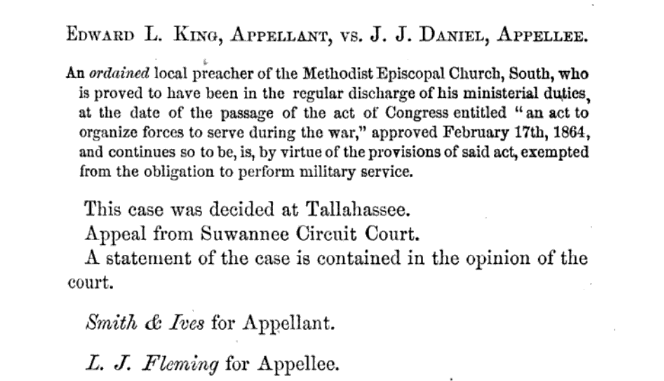 The Florida Supreme Court Case of
King vs. Daniel. Google Books
The Florida Supreme Court Case of
King vs. Daniel. Google Books
King's arrest and subsequent trial likely had a negative impact on him. In 1868, facing post Civil War financial challenges, King chose to sell his property holdings, including the Providence church. Deed records indicate that on October 29, 1868, Edward L. King sold the Providence church property, as well as other real estate holdings to John A. Rosborough (his son-in-law) and E. Lawrence King (his son). John Rosborough and E. Lawrence King were listed as "planters" working under the firm name of "Rosborough and King." The warranty deed was for $12,000.00. In 1870, Edward L. King's real estate value was estimated at $12,000.00 (probably from the recent sale of his properties), and his personal estate value had dwindled to $2,000.00.
By 1872, King had returned to South Carolina. In addition to continuing his ministeral duties, he also went into business with his son. He was readmitted into the South Carolina Conference where he served the Berkeley and Columbia Circuits. In the Minutes of the Annual Conference of the Methodist Church, South 1875, King was acknowledged, "By his zeal and earnestness as a preacher, and by his fidelity and tenderness as a pastor, he greatly endeared himself to the people of the Columbia Circuit, and was much expected by the Church there as a result of his faithful labors there."
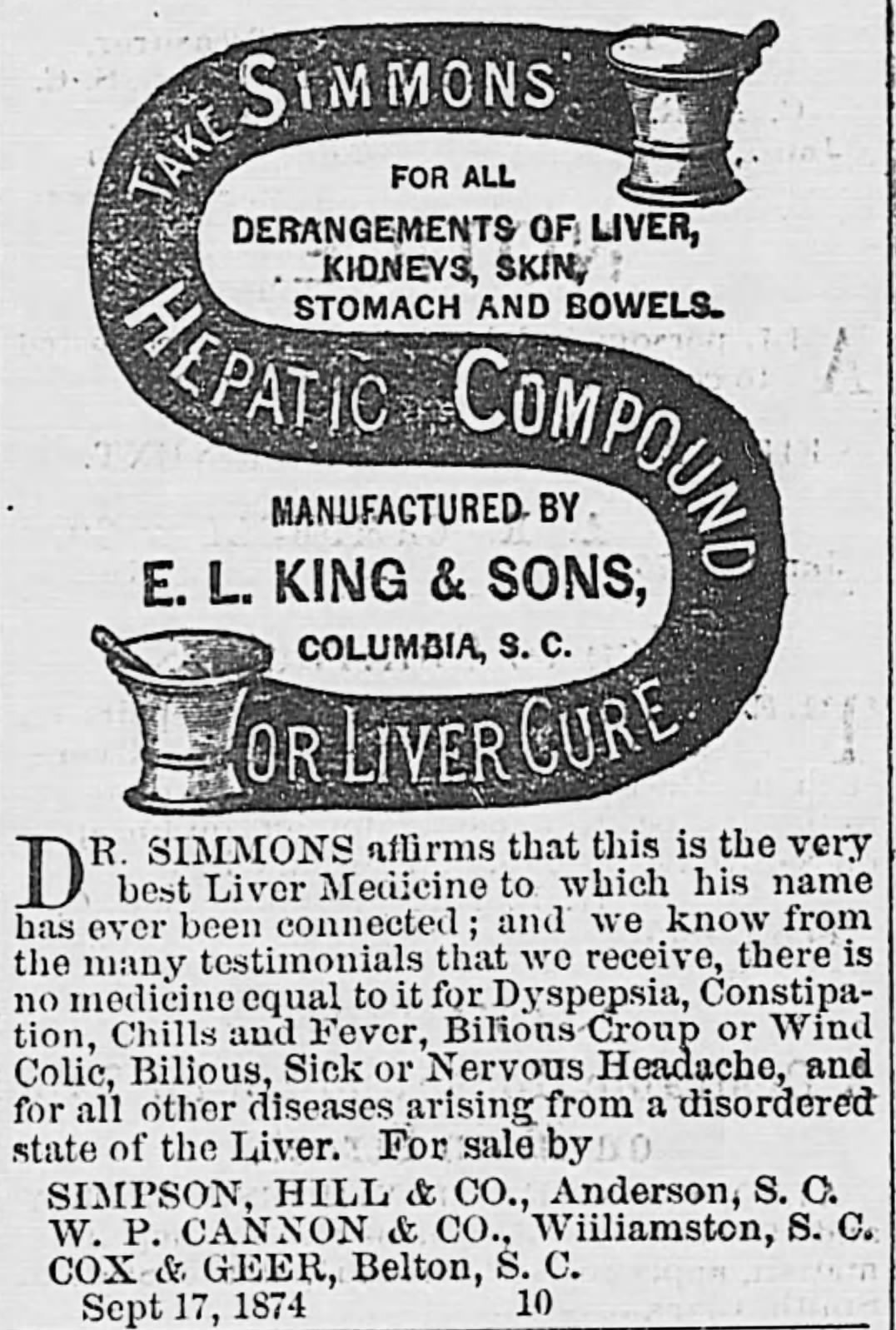 The Intelligencer, November 2, 1875
The Intelligencer, November 2, 1875
In July 1875, King's health began to fail and "he was called to exchange the field of active labor for a bed of suffering. For five months he lingered in constant suffering, enduring at times great physical pain. But he was one of the most patient of sufferers. He never once complained. Resting confidently on the merits of Jesus, and sustained by the assurance of his acceptance with God, he patiently waited for the summons to depart. He died without a struggle." 8
 Yorkville Enquirer, November 25, 1875
Yorkville Enquirer, November 25, 1875
Upon his passing, King was buried in Columbia, South Carolina, not at the Providence church he had founded in Florida. His wife, Martha, is buried in the Providence church graveyard.
"The church is in growing condition, congregations large and increasing at nearly every appointment. The good Lord is with us, pressing home his Holy word, which is causing many professors to seek a deeper work of grade and sinners to reflect on their ways." -Family Search Records
In the post-Civil War era, Alachua County's cotton industry gave way to citrus farming. As the region saw an influx of new planters and settlers, the Providence Methodist Episcopal Church continued to prosper. Succeeding Edward L. King as pastor were Robert H. Barnett in 1875, T.J. Phillips in 1878, William Watts in 1880, W.H. Steinmeyer in 1885, and E.H. Giles, 1886 - 1888. The church's earliest congregation members included the Phifer, Shearhouse, Lewi s, Beckham, Rosborough, Dickinson, Stewart, and Ormond families.
By 1876, the establishment of the Waldo Circuit marked a significant development within the local Methodist community. This circuit encompassed several churches, primarily the Providence church at Windsor, the Orange Creek church, and the Waldo church. During this period, detailed records from the quarterly conference reports (1876-1880) shed light on key figures who held significant positions within the circuit. These included McCollum and John Phifer, Israel Shearhouse, J.N. Ormond, W.D. Dickinson, F.A. Bell, J.N. Wylie, John A. Kennedy, and W.D. Tillman.
Waldo Circuit records (12 pages)
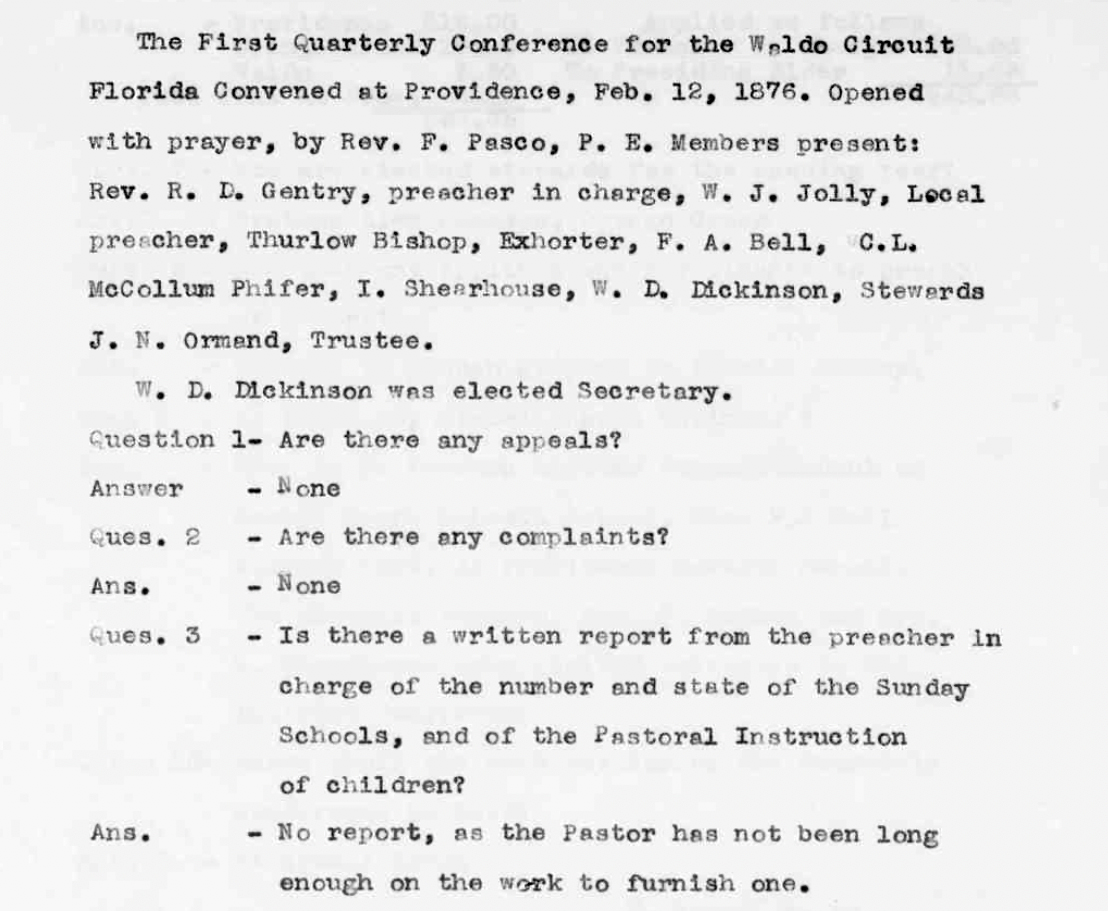 Family Search
Family Search
In addition to financial data, these reports provide a record of of individuals within the congregation who underwent changes in their church status, such as removal, addition, baptism, or death. The reports also detail the election of superintendents for Sabbath Schools, the selection of delegates to the district conference, those granted a license to preach, and the "general state" of the church. These four years of reports provide insight into the evolving composition and activities of this church community.
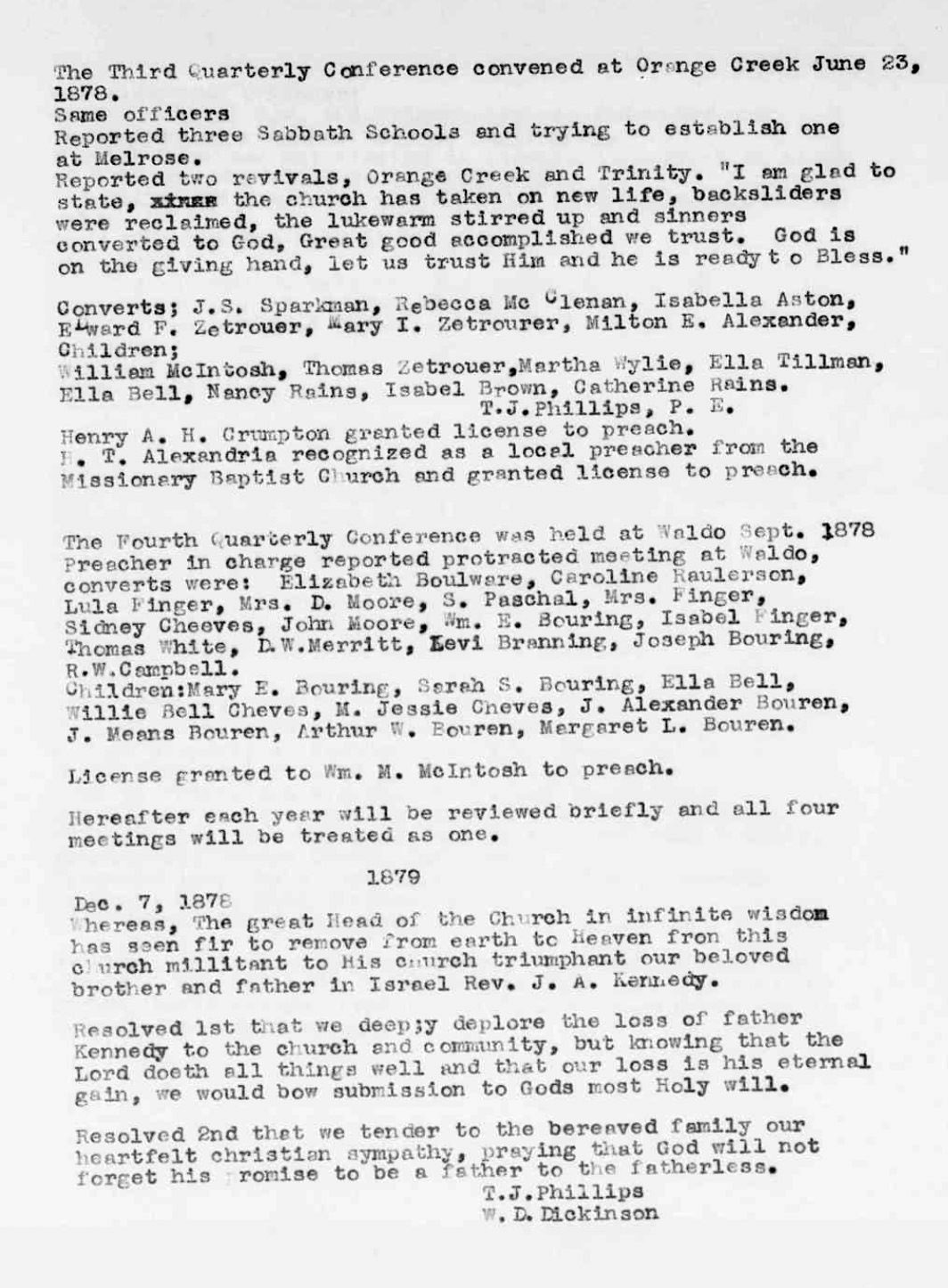 Family Search
Family Search
Progress toward the construction of a new place of worship to replace the church's log cabin must have been realized in 1884. In that year, William E. Alexander, who had acquired the church property from John Rosborough and E. Lawrence King, subsequently, sold the property to William J. Walker, George W. Kelly, and James Lawrence Kelly of Alachua County, for $4,000. The deed described the property as encompassing 82 acres of the area located between Main and King Streets, with its eastern boundary marked by the Section line of Section 2 and extending to Green Street.
Several months later, ownership of the property shifted to James Lawrence Kelly, who ultimately sold it for a nominal amount of $1.00 to the trustees of the Providence church, namely J.N. Ormond, J.W. Phifer, and McCollum Phifer. The deed specifically outlined that this land was designated for use as a place of worship and as a burial ground for the members of the Methodist Episcopal Church, South. James Lawrence Kelly, a county superintendent, was instrumental in establishing the community of Windsor (as mentioned earlier).
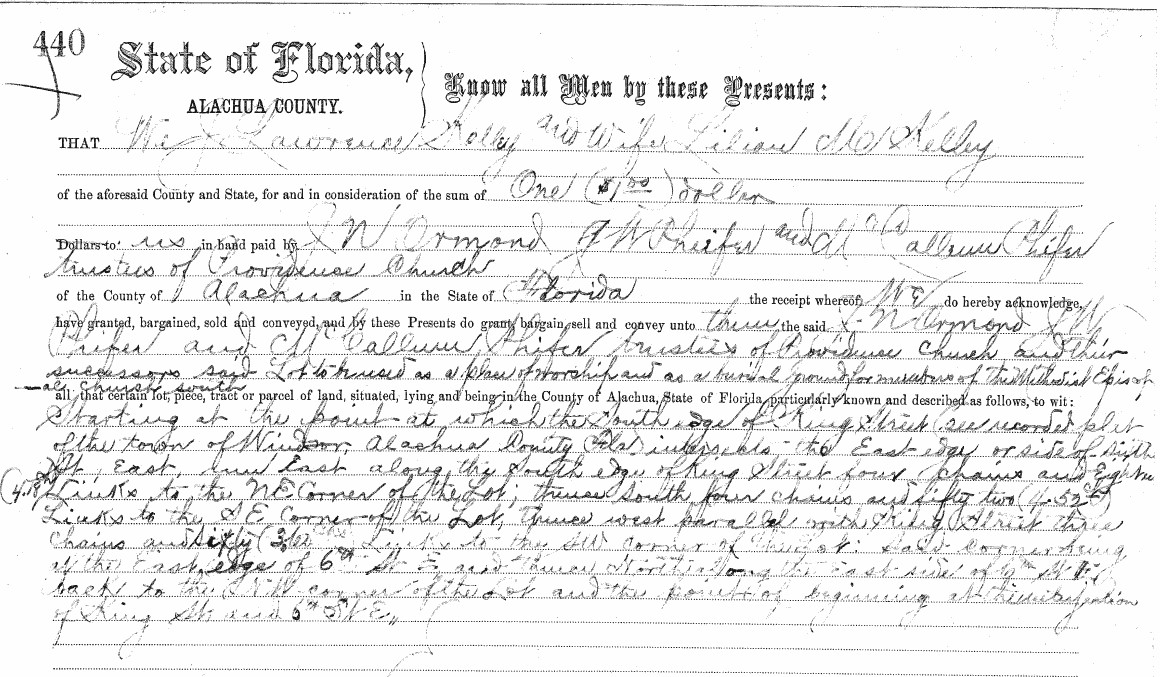 Alachua County Ancient Records
Alachua County Ancient Records
The new church building was designed in a modest white clapboard style. A 1958 Gainesville Sun article commemorating the "new" 74 year old church states that, "the interior of the church, decorated much as it was in 1884, is spacious, painted white. Original pews seat 200. An organ once lent melodic airs to the church, but it has since been replaced by a piano." The article goes on to note that the church's interior design "reflects a striking simplicity, with an altar rail adorned with a "gingerbread" effect, popular at the time." This "gingerbread effect" refers to intricately detailed embellishments commonly associated with the Victorian era. Remarkably, the gingerbread altar remains intact in the Providence church to this day, and this distinctive style is still observable on several of the older homes in the Windsor community.
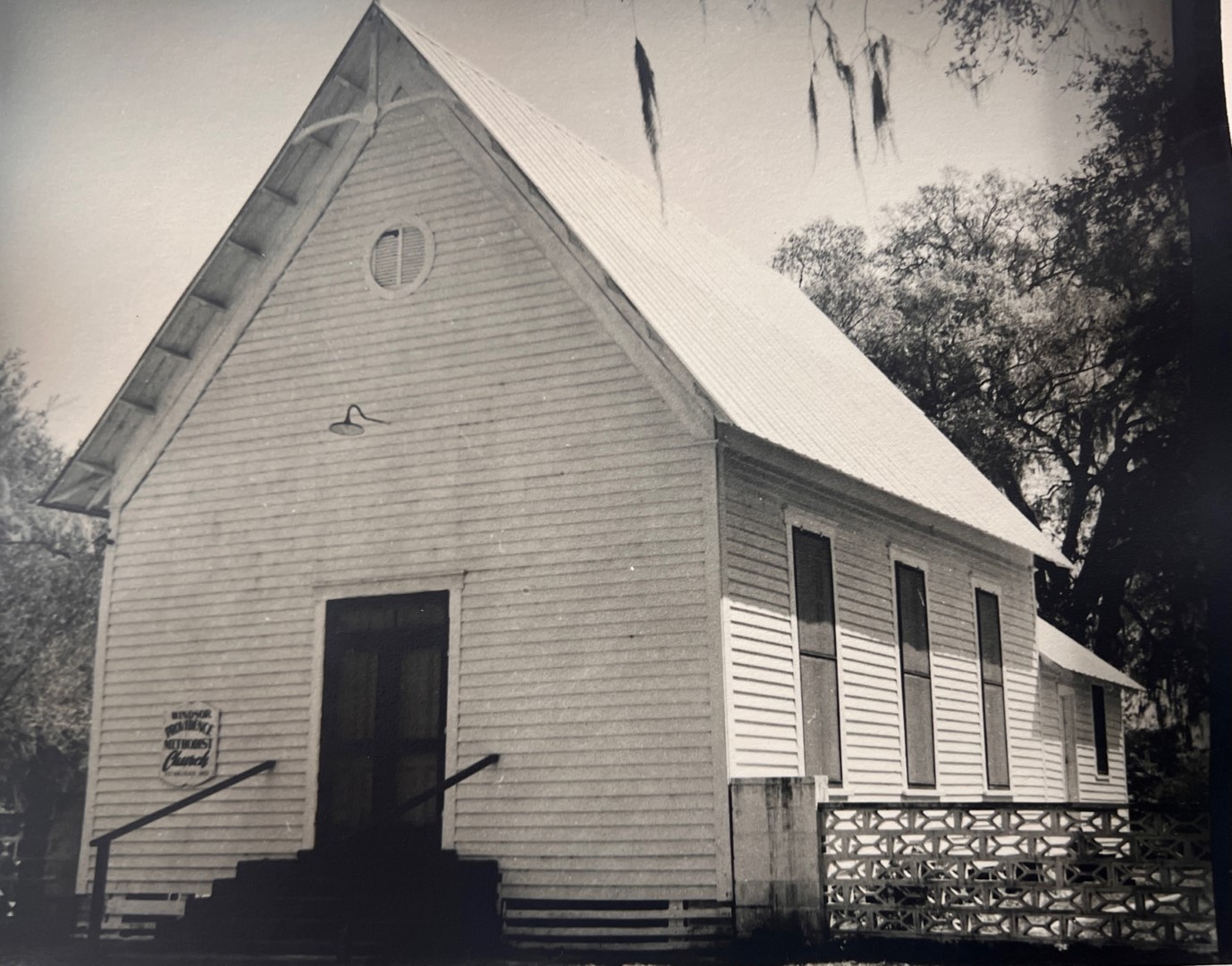 Photo provided by Gene Hunsucker
Photo provided by Gene Hunsucker
The earliest settlers of the Newnans Lake region can be traced through land ownership maps. These maps feature several families, such as Phifer, Ormond, Dickison, Lewis, King, Perry, and Kennedy, most of whom were associated with the Providence church. Notably, the Providence church property, situated in Section 2 of the map, was under the ownership of William Alexander from 1878 to 1884. John Alexander Rosborough, Edward King's son-in-law and a prominent figure in the Windsor community and the Providence church, is not included on the map as he did not settle in the area until 1884.
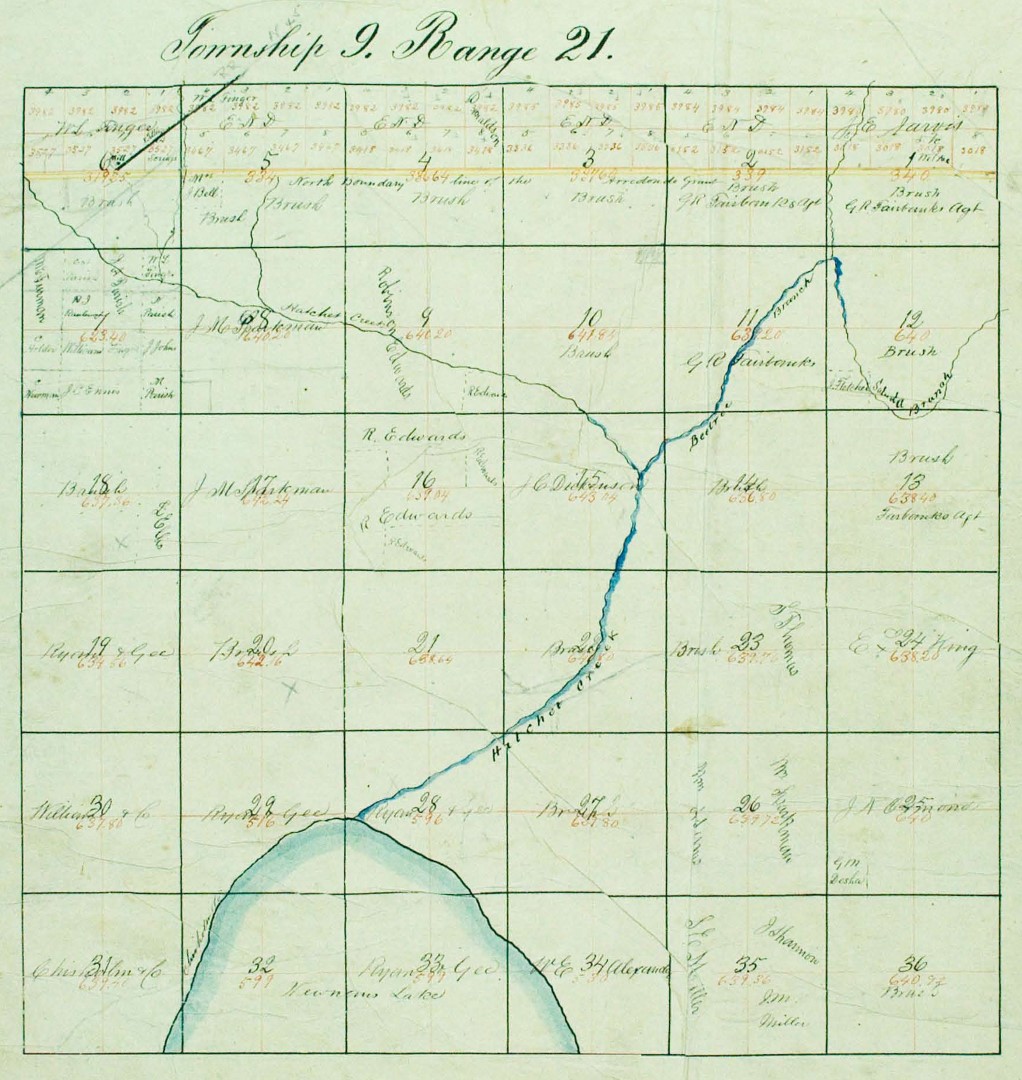 Land Ownership Map of Newnans Lake region. Estimated
date 1878 - 1884. Alachua County Ancient Records
Land Ownership Map of Newnans Lake region. Estimated
date 1878 - 1884. Alachua County Ancient Records
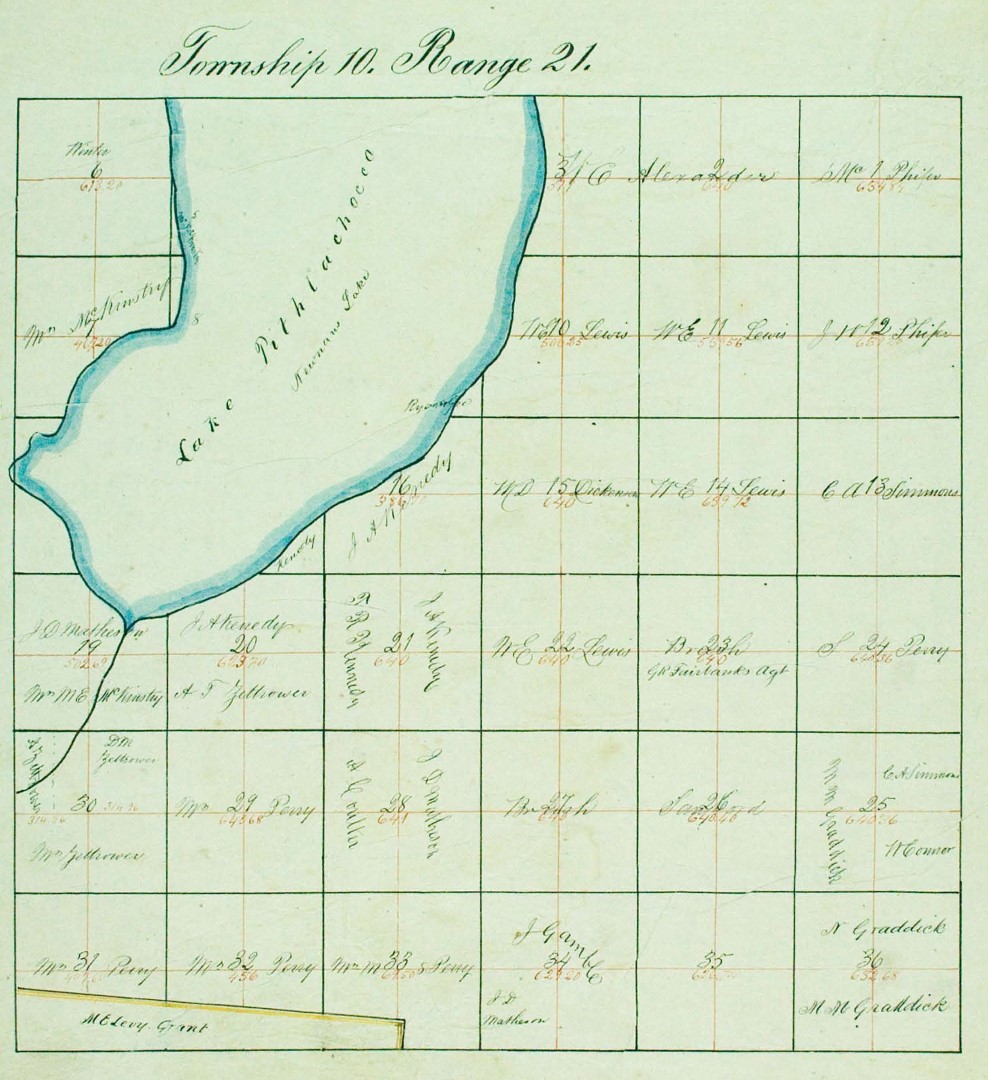 Land Ownership Map of Newnans Lake region. Estimated
date 1878 - 1884. Alachua County Ancient Records
Land Ownership Map of Newnans Lake region. Estimated
date 1878 - 1884. Alachua County Ancient Records
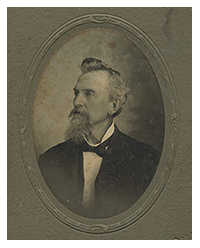 Born
in Fairfield County, South Carolina, John Alexander Rosborough
was the son of Robert Reed Rosborough and Mary Eliza Kennedy. The Scottish
Rosboroughs were among the first settlers of Fairfield County. At the age
of eighteen, John Rosborough volunteered with the Confederate forces during
the Civil War. Under the command of General Maxey Gregg within
Stonewall Jackson's division and later General Lee's Army of Virginia,
he saw action at Richmond, Antietam, Fredericksburg, Sharpsburg,
Chancellorsville, Gettysburg, and Petersburg. During the
conflict at Sharpsburg, he was wounded twice. Rosborough was
eventually captured by Union forces and sent to New York City where he was
imprisoned for the duration of the war.
Born
in Fairfield County, South Carolina, John Alexander Rosborough
was the son of Robert Reed Rosborough and Mary Eliza Kennedy. The Scottish
Rosboroughs were among the first settlers of Fairfield County. At the age
of eighteen, John Rosborough volunteered with the Confederate forces during
the Civil War. Under the command of General Maxey Gregg within
Stonewall Jackson's division and later General Lee's Army of Virginia,
he saw action at Richmond, Antietam, Fredericksburg, Sharpsburg,
Chancellorsville, Gettysburg, and Petersburg. During the
conflict at Sharpsburg, he was wounded twice. Rosborough was
eventually captured by Union forces and sent to New York City where he was
imprisoned for the duration of the war.
Following the Civil War, Rosborough journeyed to Windsor, Florida to visit with his mother's relatives, the Edward Lewis and Edward King families. During this visit, he met his first cousin, also named Mary Eliza, the eldest daughter of Edward L. King. On November 14th, 1867, John Rosborough and Mary Eliza King were married. In 1868, Rosborough purchased the Providence church property, as well as other real estate holdings, from his father-in-law, Edward King. At that time, John Rosborough and E. Lawrence King (Edward King's son) were listed as "planters" working under the firm name of "Rosborough and King." After several years in Windsor, John and Mary Rosborough returned to South Carolina. In 1882, they again returned to Windsor where they settled and raised a large family.
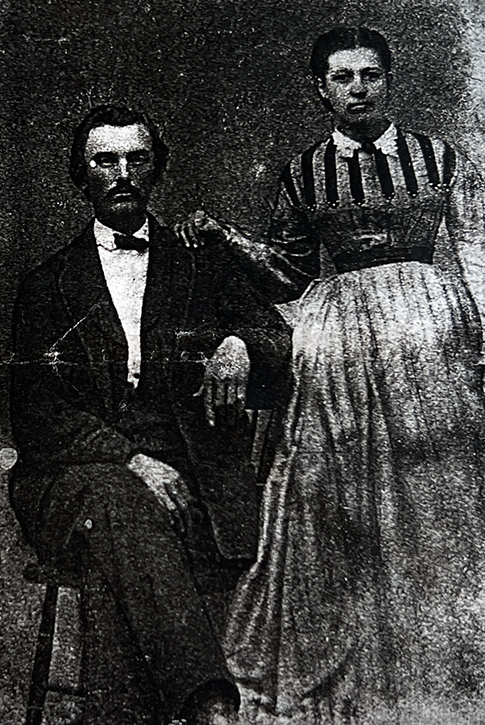 John Alexander and Mary Eliza (King) Rosborough.
John Alexander and Mary Eliza (King) Rosborough.
In 1884, as Windsor began to flourish as a community, Rosborough established one of its earliest residences. This splendid, grand Victorian- style home was befitting of a man embarking on a political career. Rosborough, a member of the Democratic Party, served as a representative of Alachua County in both the U.S. Senate (in 1889, 1891, and 1893) and the House (in 1905).
Around the year 1900, tragedy struck when a devastating fire razed the Rosborough family's magnificent home. Undaunted by the setback, Rosborough set out to construct a new plantation-style residence, utilizing timber sourced from his own land. Completed in 1902, the house featured a charming gingerbread-style fenced-in porch, making it a distinctive architectural gem that was re-used throughout the community, including the Providence church. Today, this historic home still proudly graces the Alachua Trail in Windsor.
Though raised a Presbyterian, Rosborough was a devout member and steward of the Providence Methodist church for the remainder of his life. He is buried in the Providence graveyard.
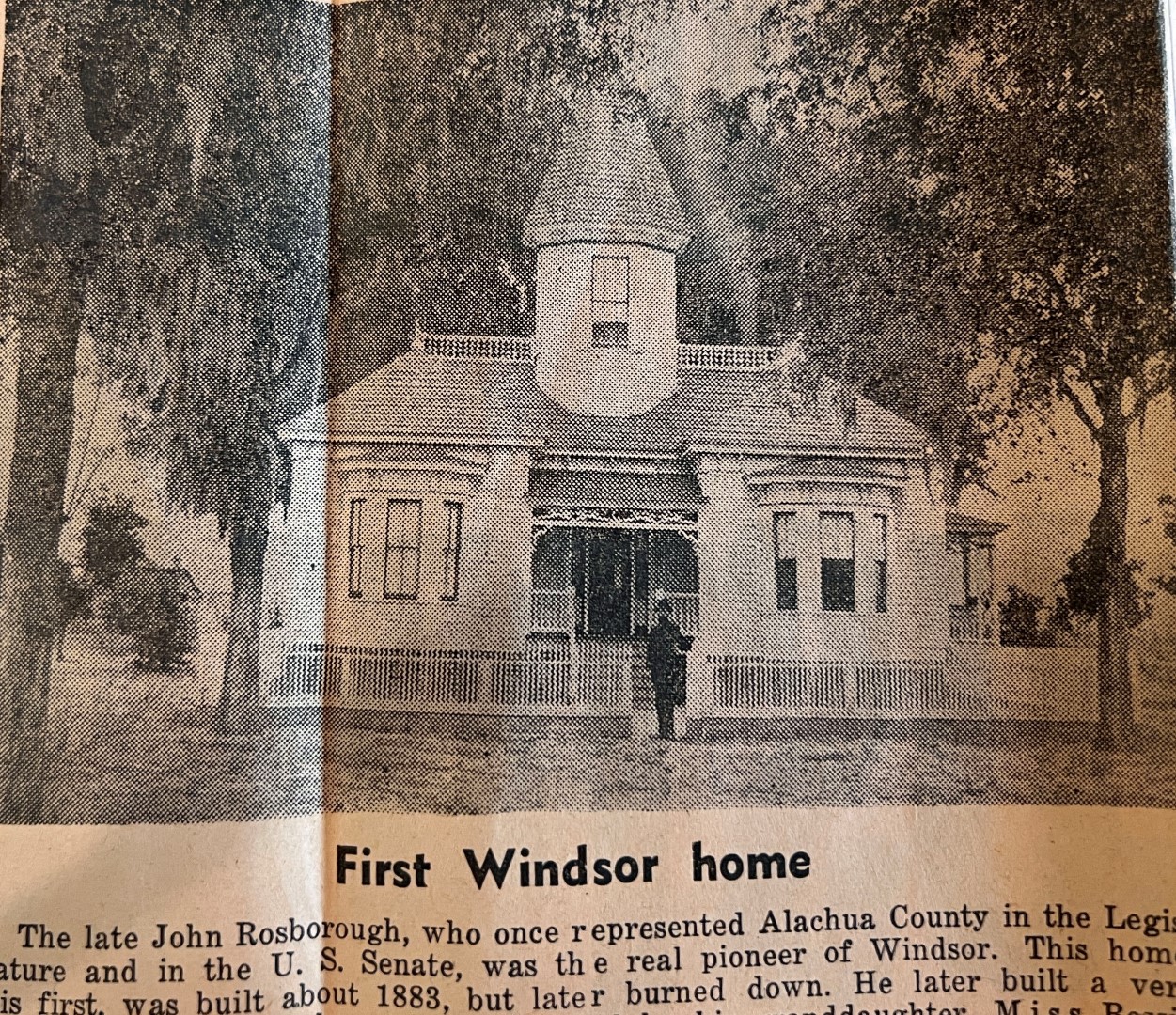 One of the first homes in community of Windsor, the Victorian architecture style home
built by John Alexander Rosborough. This home burned down, and Rosborough
built a second home which is still standing today.
One of the first homes in community of Windsor, the Victorian architecture style home
built by John Alexander Rosborough. This home burned down, and Rosborough
built a second home which is still standing today.
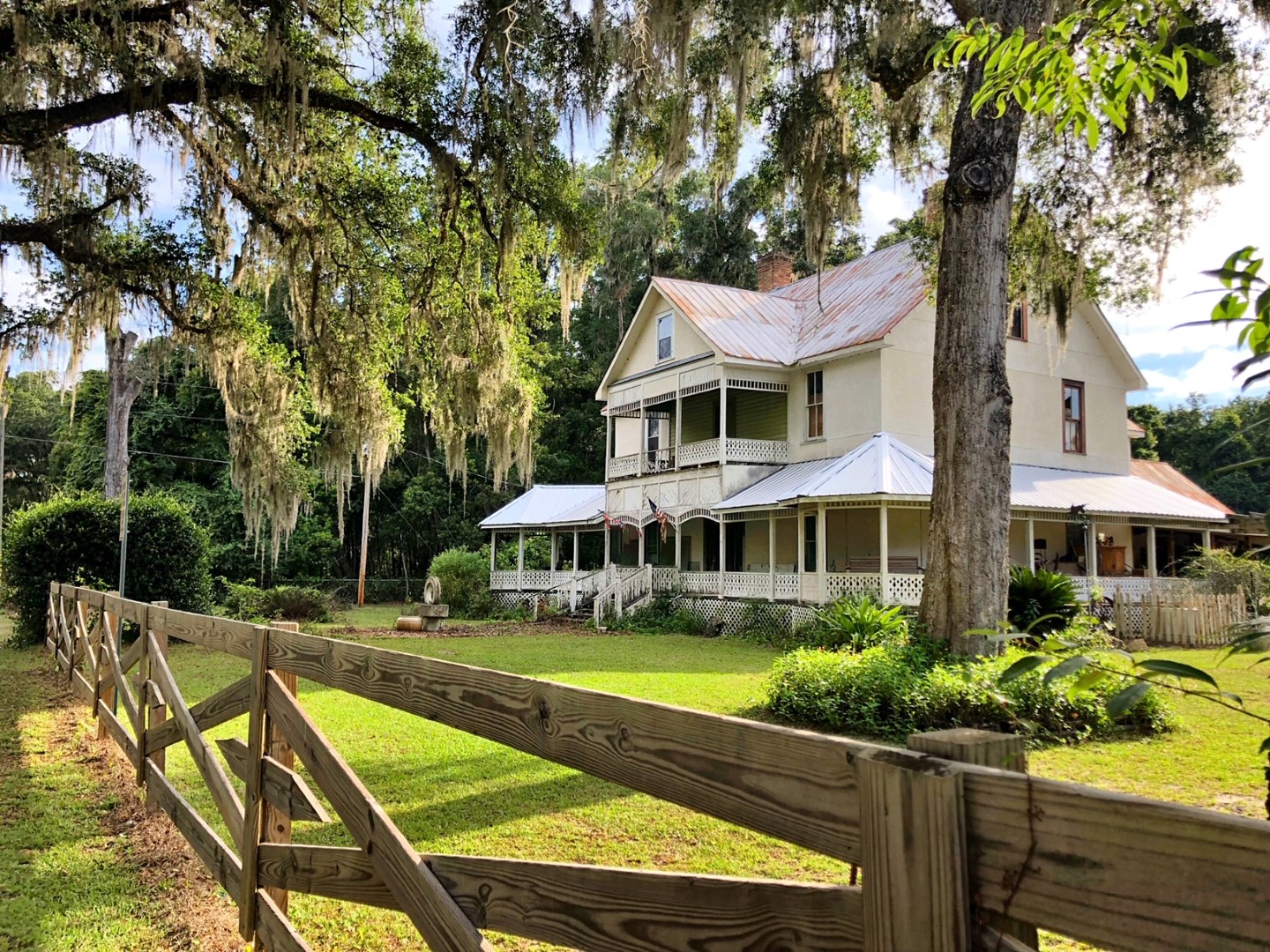 The second John Alexander Rosborough home built in 1902 is still
standing today along County Road 234 (Alachua Trail) in Windsor.
The elaborately detailed embellished gingerbread style architecture
graces the wrap around porches. P Marlin
The second John Alexander Rosborough home built in 1902 is still
standing today along County Road 234 (Alachua Trail) in Windsor.
The elaborately detailed embellished gingerbread style architecture
graces the wrap around porches. P Marlin
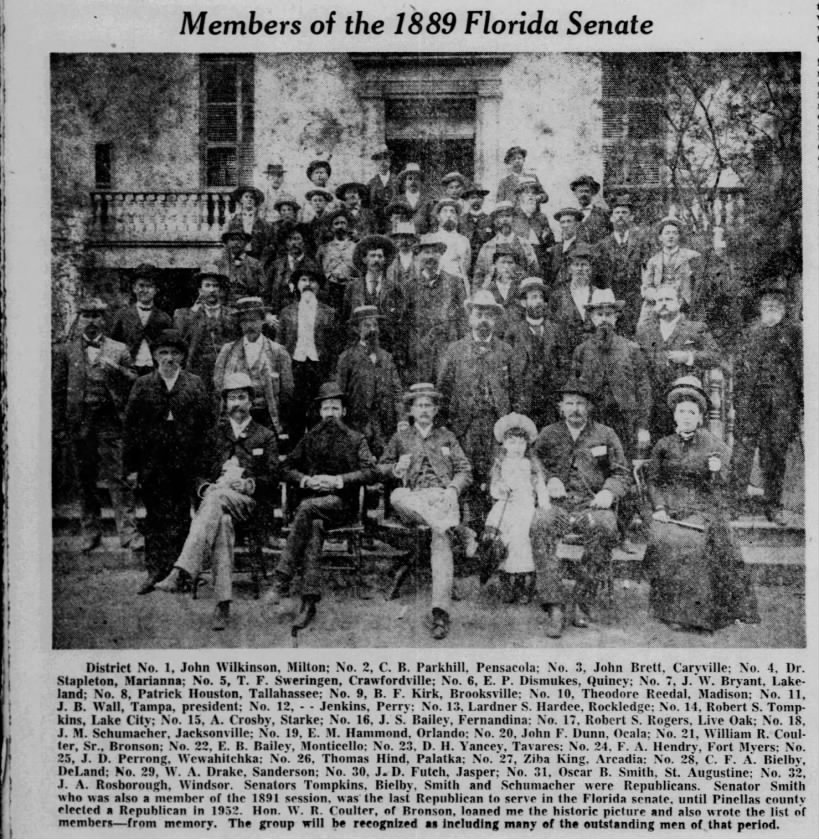 John Rosborough, representing District 32, is photographed with other members of the Florida Senator in 1889.
John Rosborough, representing District 32, is photographed with other members of the Florida Senator in 1889.
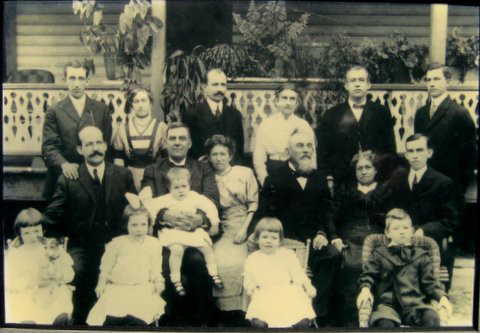 The Rosborough family poses in front of the second Rosborough home.
Notice the embellished gingerbread style architecture. Ancestry
The Rosborough family poses in front of the second Rosborough home.
Notice the embellished gingerbread style architecture. Ancestry
"We enjoy the little church because we know everyone there. We're all friends and neighbors." -Ruby Langford
"I was there during the freeze when Windsor was a larger place. Everyone knew everyone, mostly because they were related. Often someone would go home with others for dinner. We got to know the minister quite well because he mostly picked our house to come for dinner." -Mrs. Jim Hope
Emerging from its roots as a mid 19th century pine-hewn log cabin amidst an era of Seminole attacks, cotton plantations, and the secession of the south, the Providence church has quietly observed the passage of time. In the decades immmediately following the Civil War, the Providence church experienced its greatest growth as citrus farming brought new settlers to the area. Longtime church members as well as newcomers filled the church's wooden pews as congregational hymns and fiery sermons could be heard for miles around.
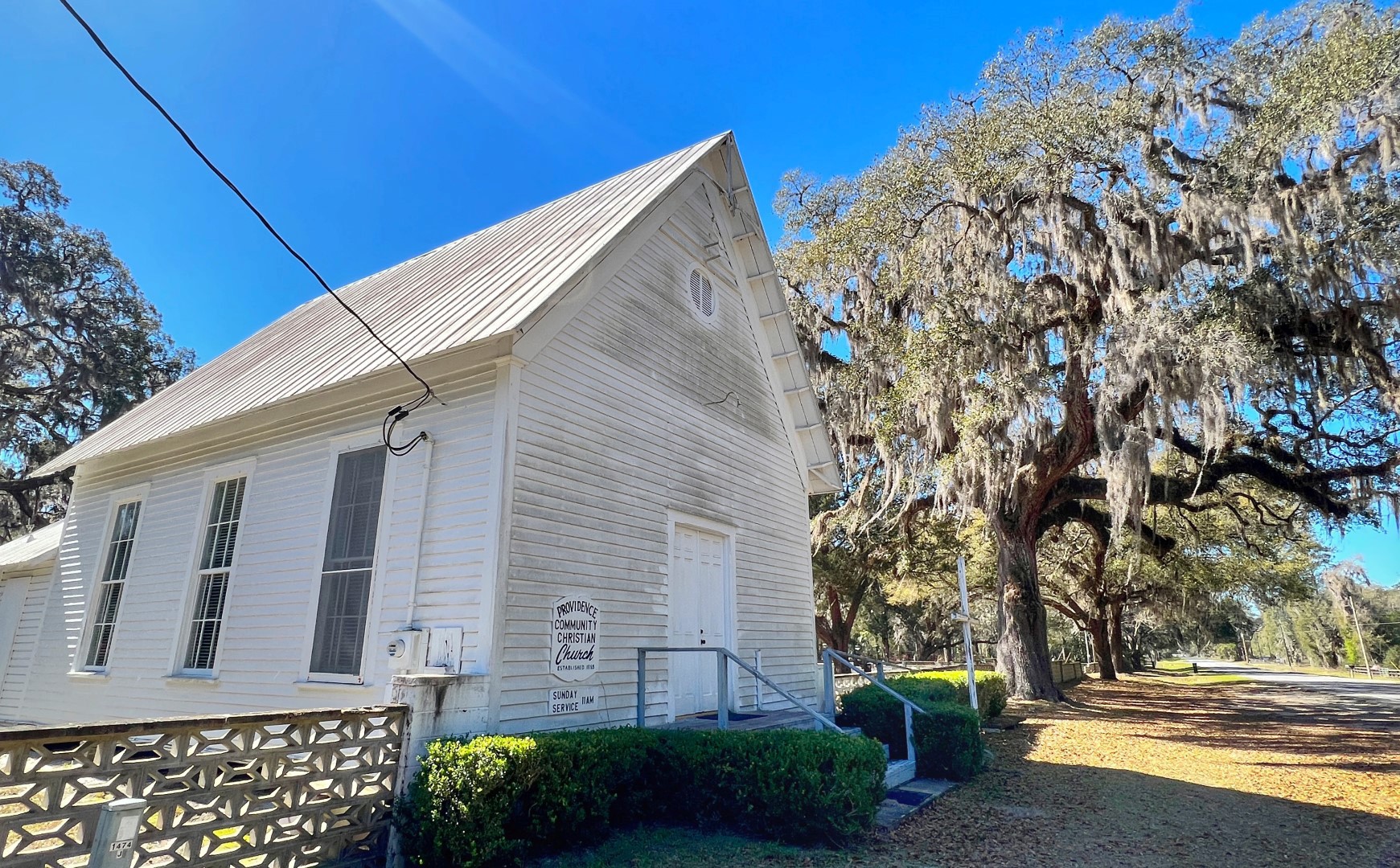 The Providence Christian Community Church in April 2023. P. Marlin
The Providence Christian Community Church in April 2023. P. Marlin
Throughout the 20th century, the Providence church encountered financial challenges as the congregation dwindled in size. Nevertheless, the church remained steadfast in administering to the religious needs of its community. A small, consistent congregation marked significant milestones and events that were covered in numerous articles from The Gainesville Sun. Notably, these events included gospel services in 1911, a 97th anniversary commemoration in 1951, a 74 year old church recognition in 1958, a Christmas celebration in 1976, a 124th homecoming in 1979, and a 144th Homecoming in 1998.
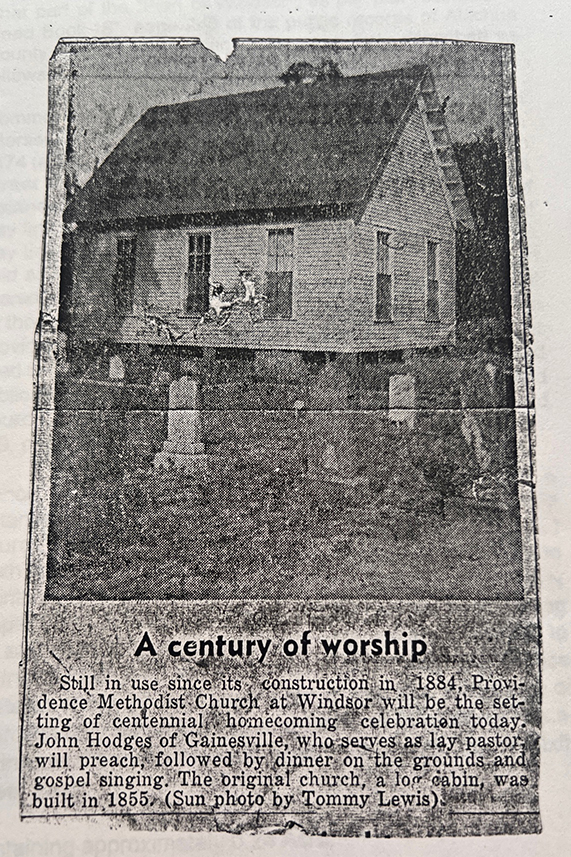 Providence church archives.
Providence church archives.
Continuing into the 21st century, the Providence church has broken from its long denominational past. Renamed the Providence Community Christian Church, it has embraced a non-denominational identity, indicating a departure from its origins of Methodism. Despite the transformation, a small congregation continues to worship at the Providence church. Today, the church building's bright white interior reflects the Florida sun on Sunday mornings as it has for well over a century. Wooden pews and gingerbread embellishments that frame the pulpit area offer a glimpse into its historical charm, while mid-century updates, such as ceiling lights and paneling, reflect the church's journey through time. Modern conveniences like central air conditioning and a sound system bring the church into the contemporary era, harmonizing tradition with modern comfort. These features underscore the church's enduring role as a symbol of the past and a guiding light for the future.
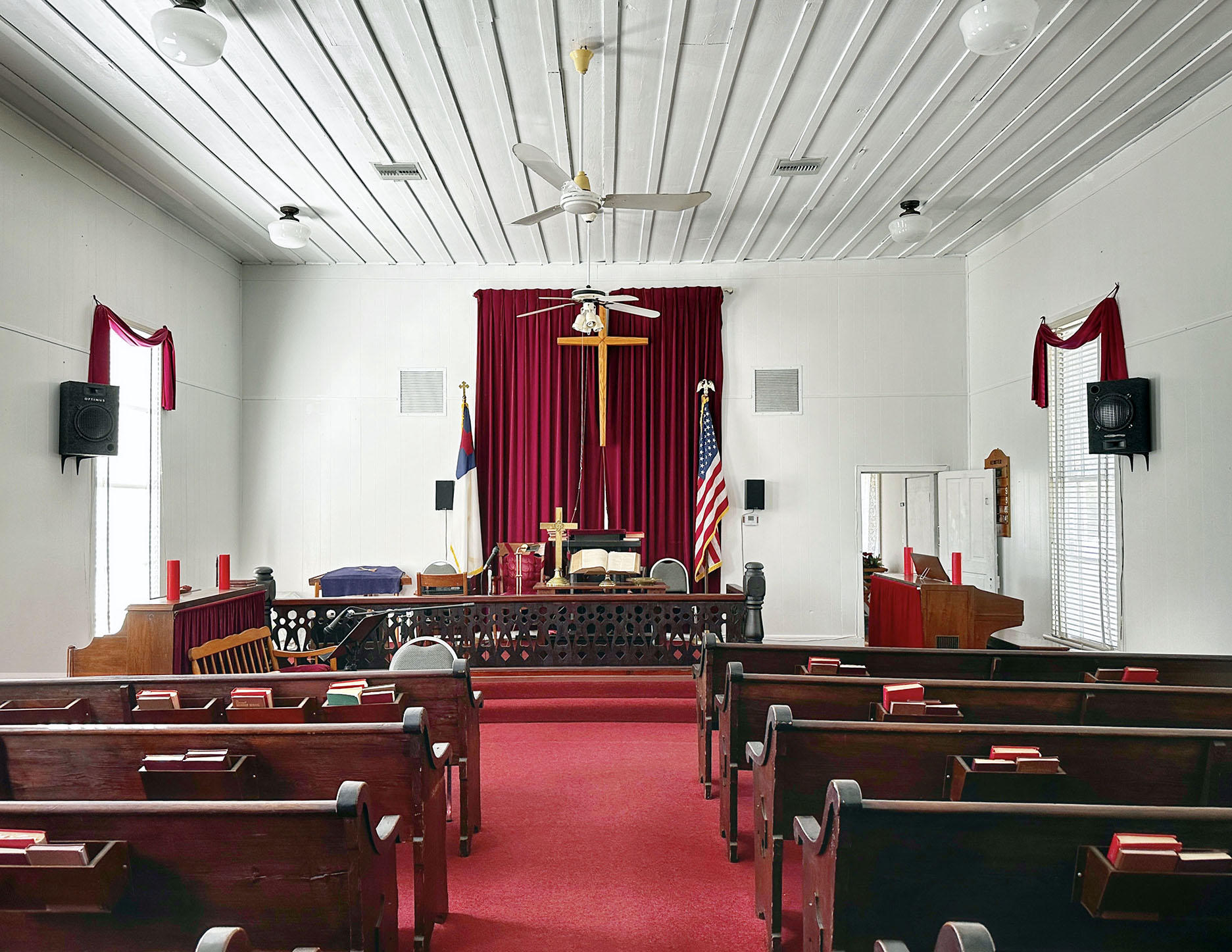 The Providence Community Church interior. P. Marlin
The Providence Community Church interior. P. Marlin
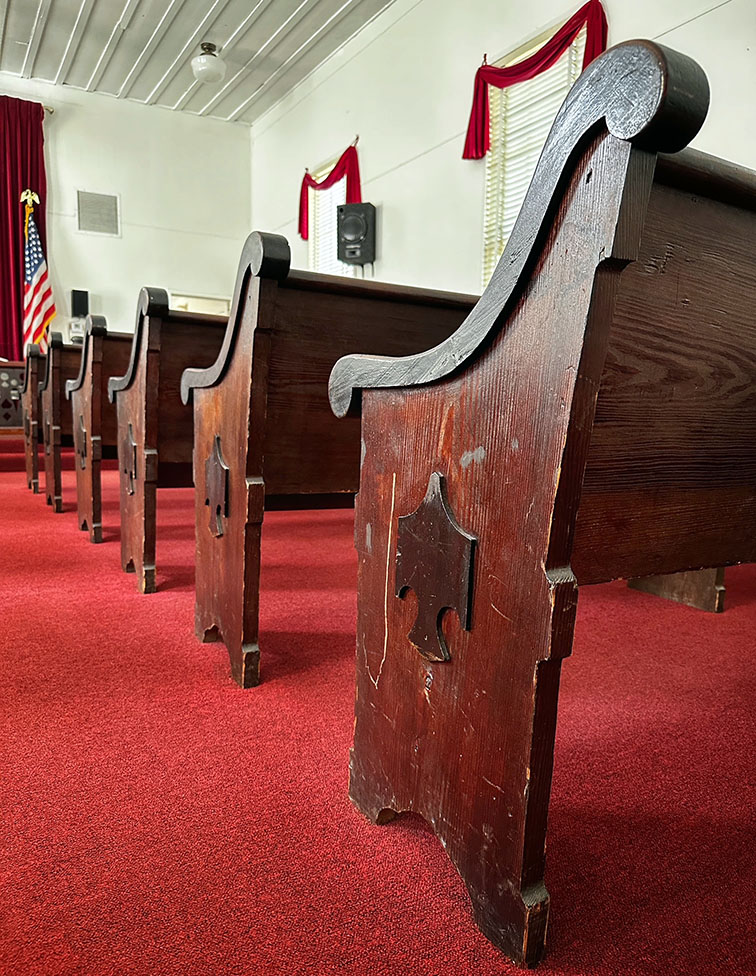 The Providence Community Church interior. P. Marlin
The Providence Community Church interior. P. Marlin
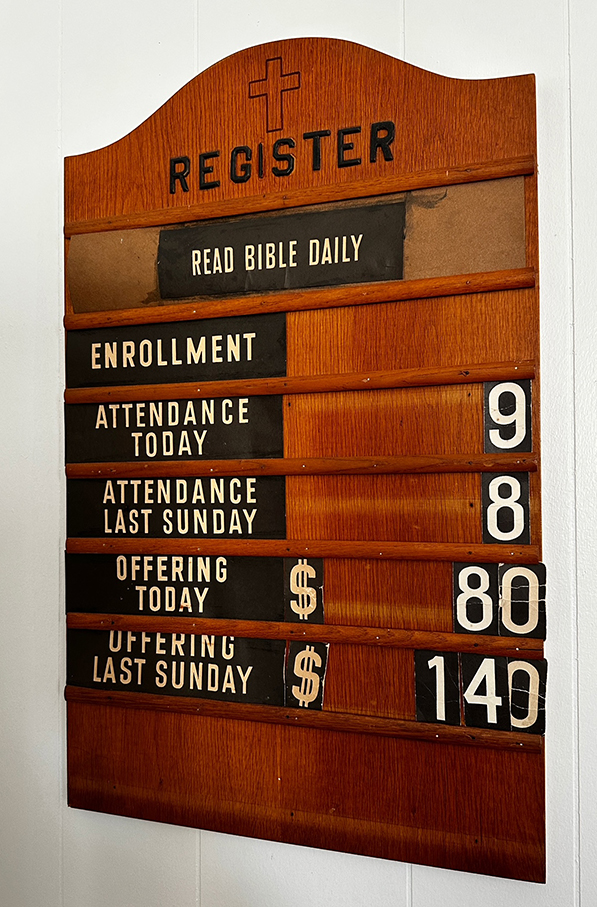 The Providence Community Church weekly attendance register. P. Marlin
The Providence Community Church weekly attendance register. P. Marlin
A large Bible prominently displayed in front of the pulpit holds historical significance having been presented to Providence Church by Edward King Fagan, named after the church's founder, Edward L. King. Tucked within the Bible's front cover is a letter authored by Joseph F. Bell, an early member of the church. Dated 1951, the letter offers valuable insights into the foundational years of the church.
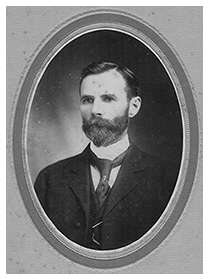 Image: Joseph F. Bell
Image: Joseph F. Bell
"The Pulpit Bible at Providence church was a gift from Edward King Fagan, long time a merchant at Gainesville. I presented it to the church from him on April 19, 1942. He was then 87 years of age, and had bought the book when he was a youth, so he had owned it around seventy years. He was named for Rev. Edward King, one of the founders of Providence church.
That dear old church is close to one hundred years of age. I attended there with my parents as an infact, 83 years ago, and then on through many years. My father, Francis A. Bell, was long time a steward there. The bodies of my beloved parents rest in the grave yard there, also those of a brother and three sisters. That sacred GOD's ACRE marks the graves of many friends and close relatives of mine. I was never the pastor there. Only time I ever ministered at Providence was on August 13, 1922, when I held the funeral for Robert J. Beckham, 95 years of age, who died leaving fifteen living children. Providence was their family church.
Some of the pastors there whom I loved much, were Robert H. Barnett in 1875; T.J. Phillips, 1878 & 79; William Watte 1880 & 81; W.H. Steinmeyer 1883-85; E.H. Giles 1886 - 88. After that I was off at college, then in the Florida Conference myself. Some of the eminent Presiding Elders - T.W. Moore, John C. Ley, J.P. DePass, Charles A. Fulwood, W.F. Norton. These are names from my boyhood memory. many other able men came later, and some at an earlier time.
Good family names of the early times - King, Phifer, Ormond, Lewis, Beckham, Howard, Bell, Roseborough, Dickinson, Miller, Cheves. Bro. Ed Phifer, on the spot where he was born 92 years ago next month, a faithful member, and greatly beloved by all the church.
The first house put up was built of pine logs, stood east and west, with that oak tree out at east front. But a much smaller tree then. The present building was erected I think about 1882 or '83. After 1877 my church was at Orange Creek, north of Hawthorne, where my family had moved. Many fine Methodist families came with the growing up of Windsor, and I do not try to name them. Providence and Orange Creek had the same minister, who lived at Melrose, hence the Melrose Circuit. My own ministry dates from Nov 12, 1887, and if I live to that date this year, my License to Preach will be 64 years old. I was born Feb. 5, 1868 and am now 85 & 1/2 years in age.
Fraternally Yours, Joseph F. Bell
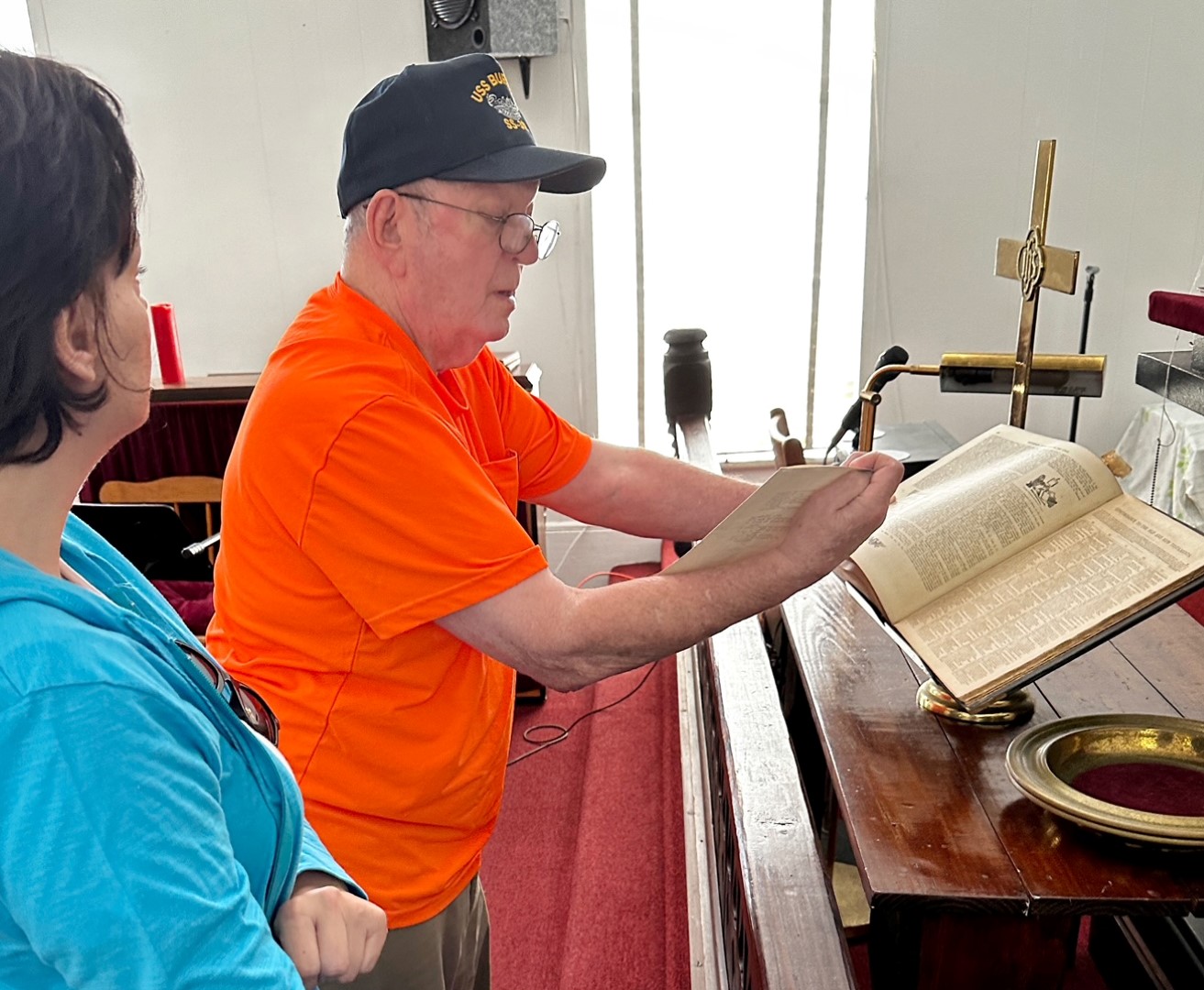 Browsing the Providence Church bible with Gene Hunsucker,
church caretaker and member. P. Marlin
Browsing the Providence Church bible with Gene Hunsucker,
church caretaker and member. P. Marlin
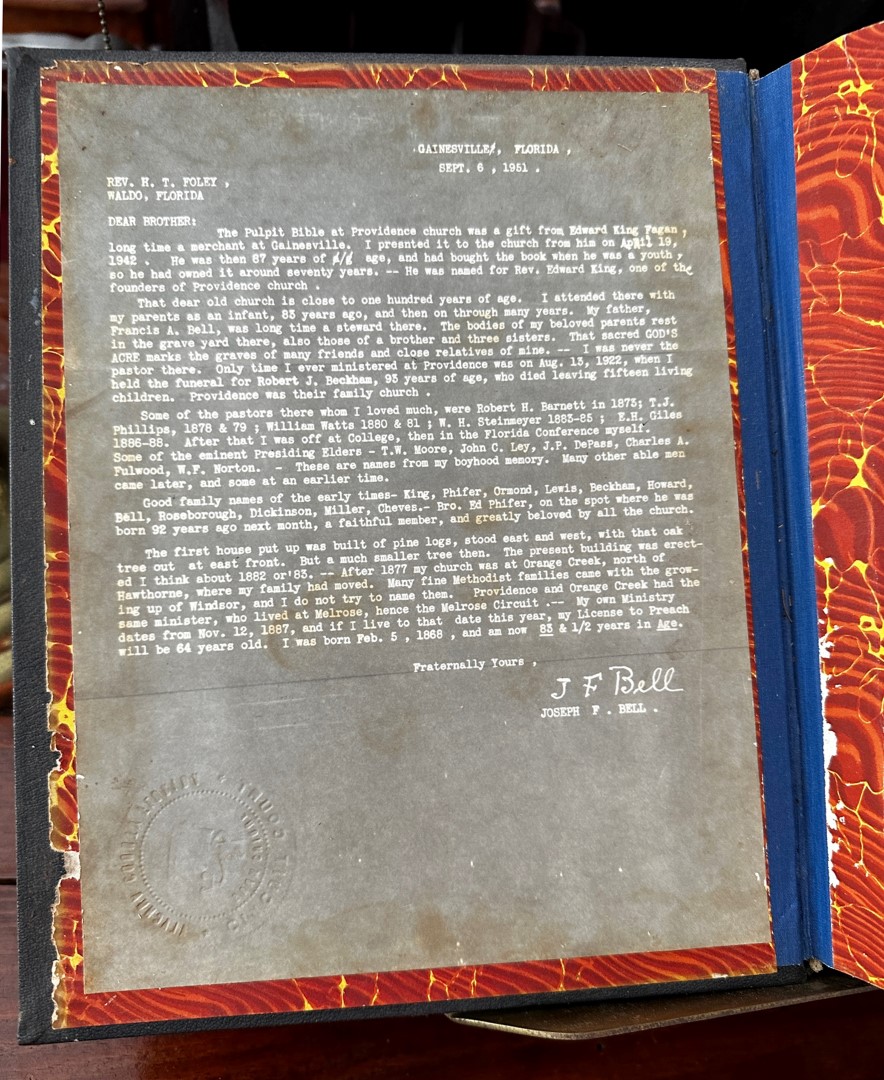 The letter from J.F. Bell located within the Bible. P. Marlin
The letter from J.F. Bell located within the Bible. P. Marlin
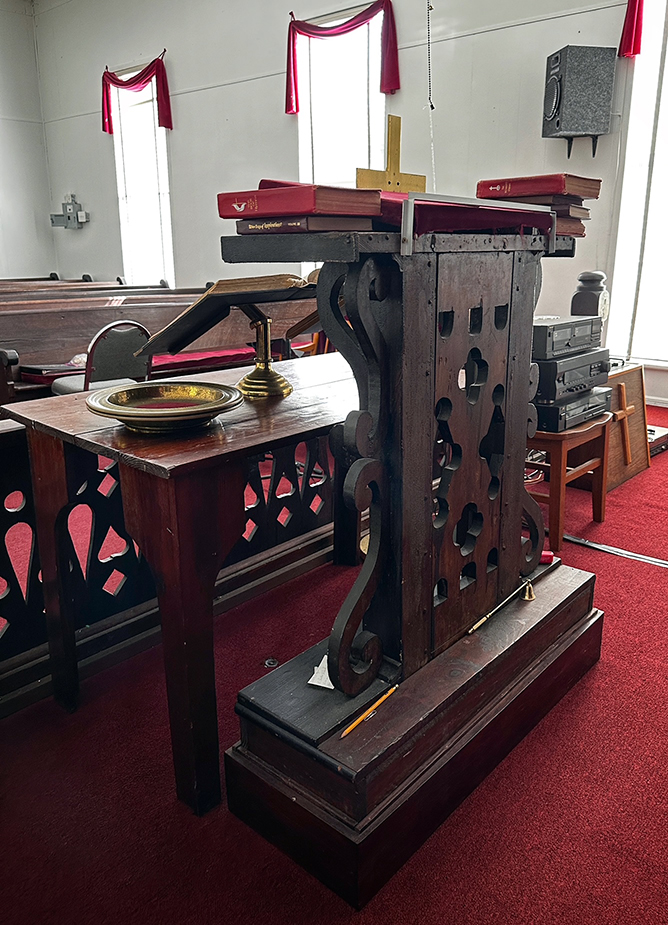 The Providence Community Church pulpit. P. Marlin
The Providence Community Church pulpit. P. Marlin
Only a handful of artifacts from the old church remain. Gene Hunsucker, a invaluable resource in my exploration of the church's past, generously shared stories of the past and surviving church documents. Born near Windsor, Hunsucker served in the military for many years before returning to his hometown to settle. According to Hunsucker, the original church records, kept in filing cabinets and old boxes, were moldy and had been ruined over time. The salvageable records were reportedly handed over to a Alachua County historian years ago, at least as far as Hunsucker remembered.
 An old Providence church record book. P. Marlin
An old Providence church record book. P. Marlin
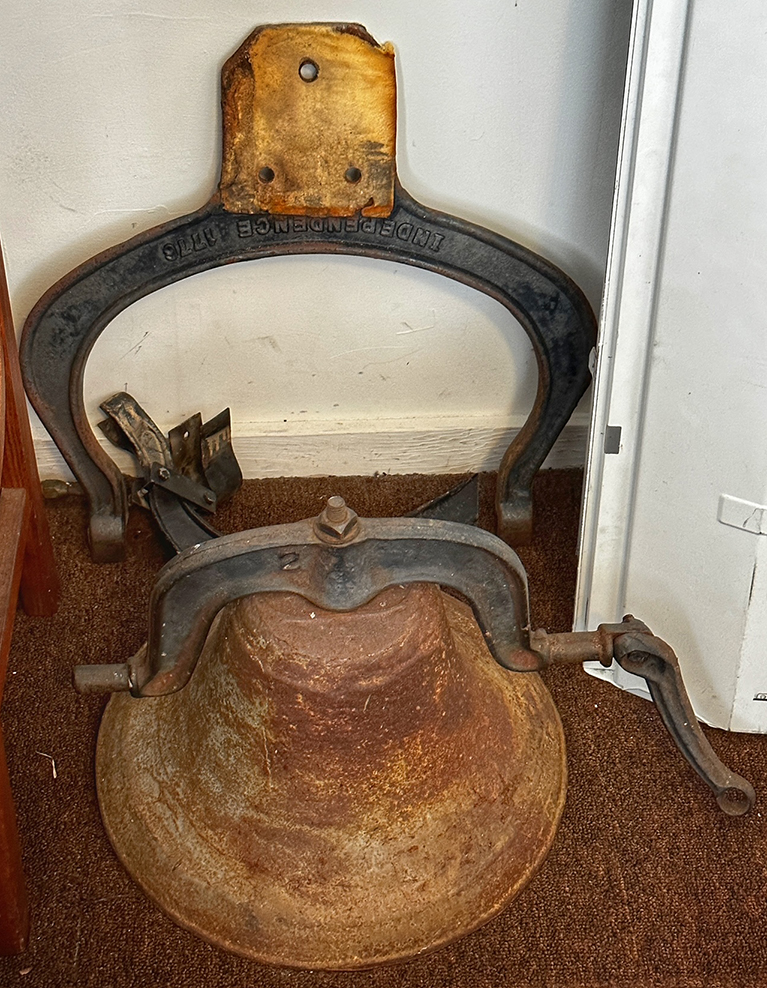 The Providence church bell that was once situated above the main entrance. P. Marlin
The Providence church bell that was once situated above the main entrance. P. Marlin
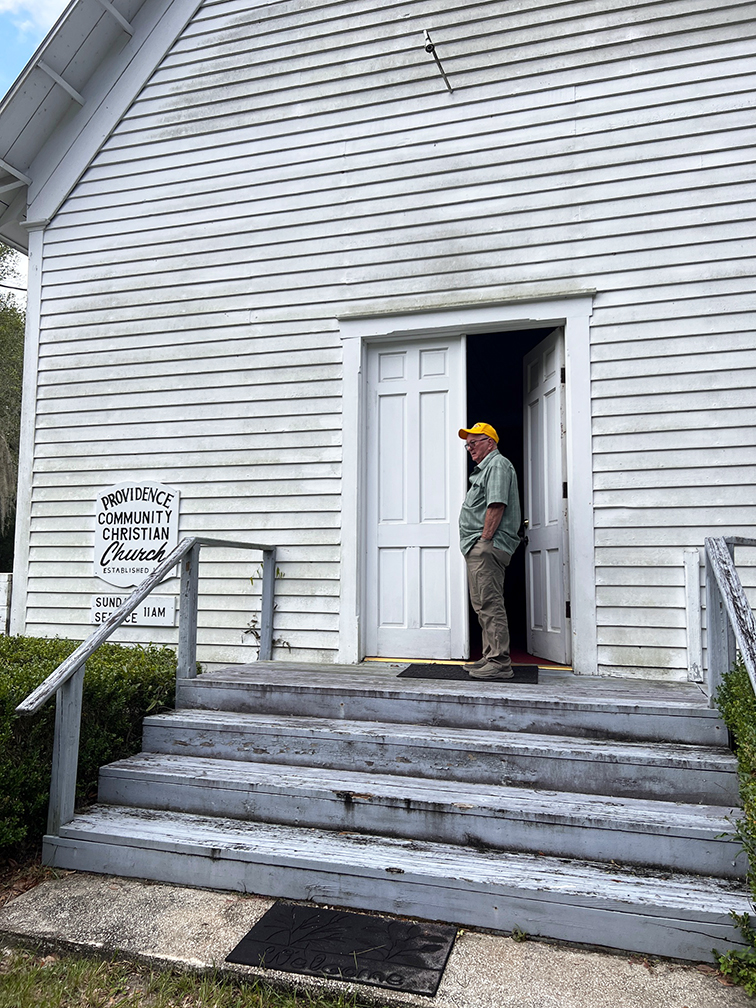 Gene Hunsucker, my research guide throughout this historical exploration. In addition to furnishing the records that proved invaluable in my research, I relished the opportunity to listen to Gene's stories of days gone by.
P. Marlin
Gene Hunsucker, my research guide throughout this historical exploration. In addition to furnishing the records that proved invaluable in my research, I relished the opportunity to listen to Gene's stories of days gone by.
P. Marlin
A cemetery need not be a dark unkempt foreboding place. If properly maintained, it can be a pleasant place to come to remember those who have passed. If we do not care of our forebears resting place now, it is not likely that our children will care for ours. -Providence Church Archives
The Providence church graveyard is not only a burial site, but also a reminder of the struggles and successes of Florida's early pioneers. It is a place where visitors can reflect on the past, connect with their ancestors, and gain insight into the region's history. The graveyard, characterized by majestic oak trees, is most scenic during the spring when azalea bushes are in bloom. The church's records and gravestones indicate that the earliest documented burials at the church date back to 1855, although it is plausible that there are even older burials predating this period.
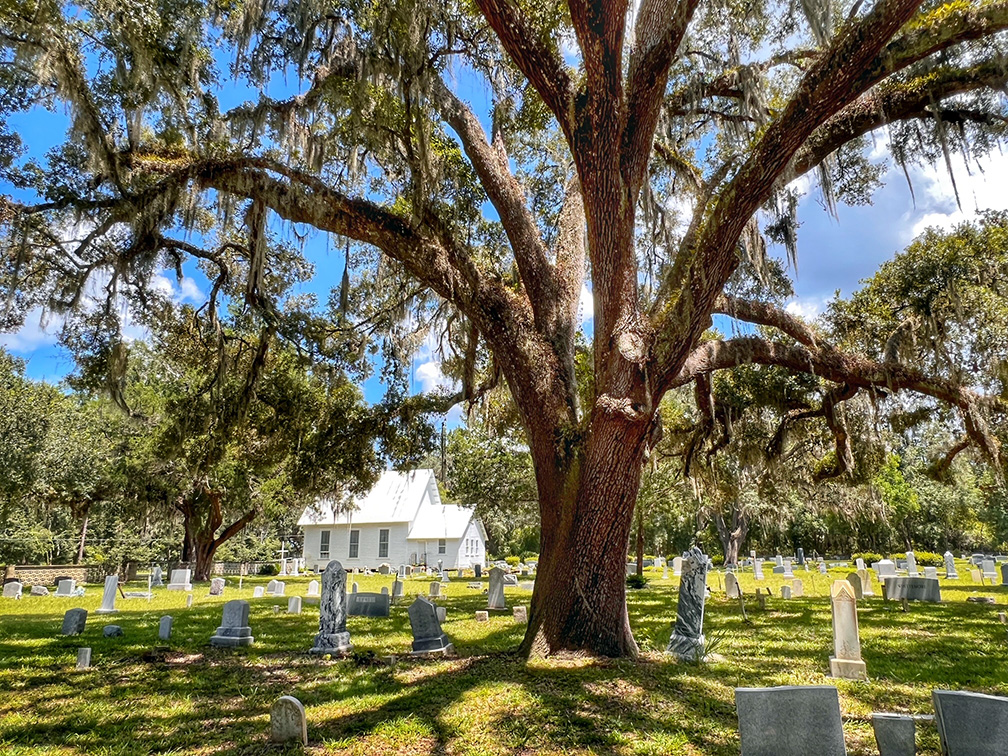 P. Marlin
P. Marlin
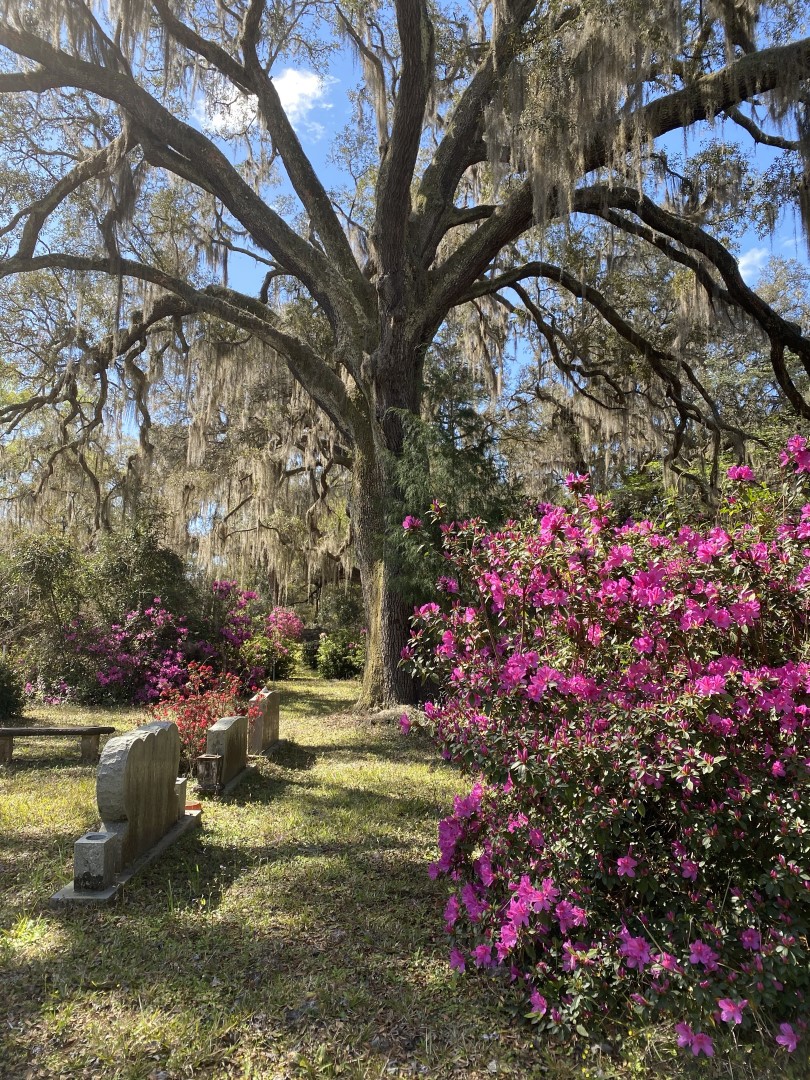 The Providence Christian Community Church Graveyard. P. Marlin
The Providence Christian Community Church Graveyard. P. Marlin
According to the records in the Providence church's archives, the graveyard experienced a period of neglect lasting approximately 20 years during the mid-1900s. Before that time frame, routine workdays were conducted, as highlighted in the following excerpt from The Gainesville Sun.
 A Providence graveyard cleaning in 1911.
A Providence graveyard cleaning in 1911.
In 1963, Mrs. O.M. Tillman, recording secretary (since 1957) of the Providence church wrote a history of the Providence Cemetery Assocation. In the writeup, Mrs. Tillman stated that, "For several years (maybe 20) previous to organizing the Providence Cemetery Assocation the cemetery at Providence church (or Windsor) had been neglected, except for a few spots kept by individuals who tried to keep their immediate family graves clean. The fence was down, cattle and hogs ranged there, more than half the cemetery was over-grown with scrub oaks and trees."
As per Tillman, the church's tradition involved organizing a cemetery workday twice a year, specifically on a Saturday preceding the third Sunday in May and October. Initially, a majority of families with loved ones in the cemetery actively participated in these workdays. However, over time, an increasing number of families who had laid their deceased to rest there relocated, leading to the neglect of the cemetery.
Upon the establishment of the cemetery association in 1957, their efforts were directed towards enhancing the cemetery. This involved tasks such as clearing trees and scrub oaks, installing a deep well to establish a water system for the cemetery, planting grass, and erecting a concrete fence around the burial ground. Mrs. Tillman's full history of the Providence Cemetery Association.
Of particular note are the graves within the graveyard which exhibit a distinctive feature of being adorned with bricks. These bricks are believed to have been sourced from the nearby old Campville Brick Co., located approximately one mile away in Campville. This unique architectural detail adds a layer of historical significance to the graveyard, linking it to the local brick production industry of the past.
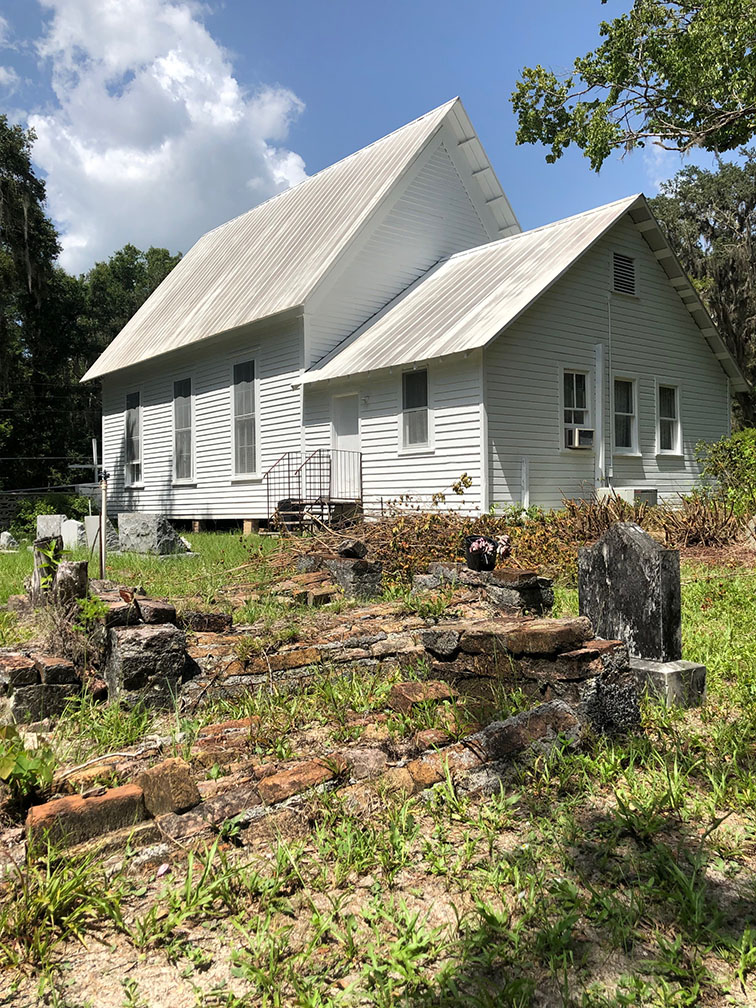 P. Marlin
P. Marlin
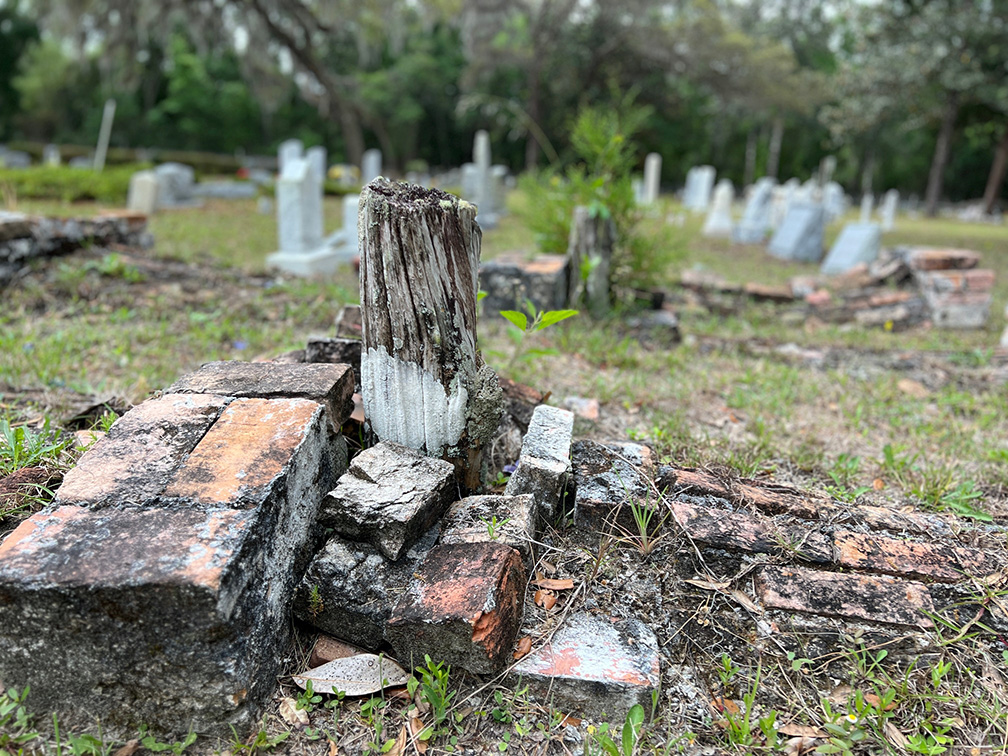 P. Marlin
P. Marlin
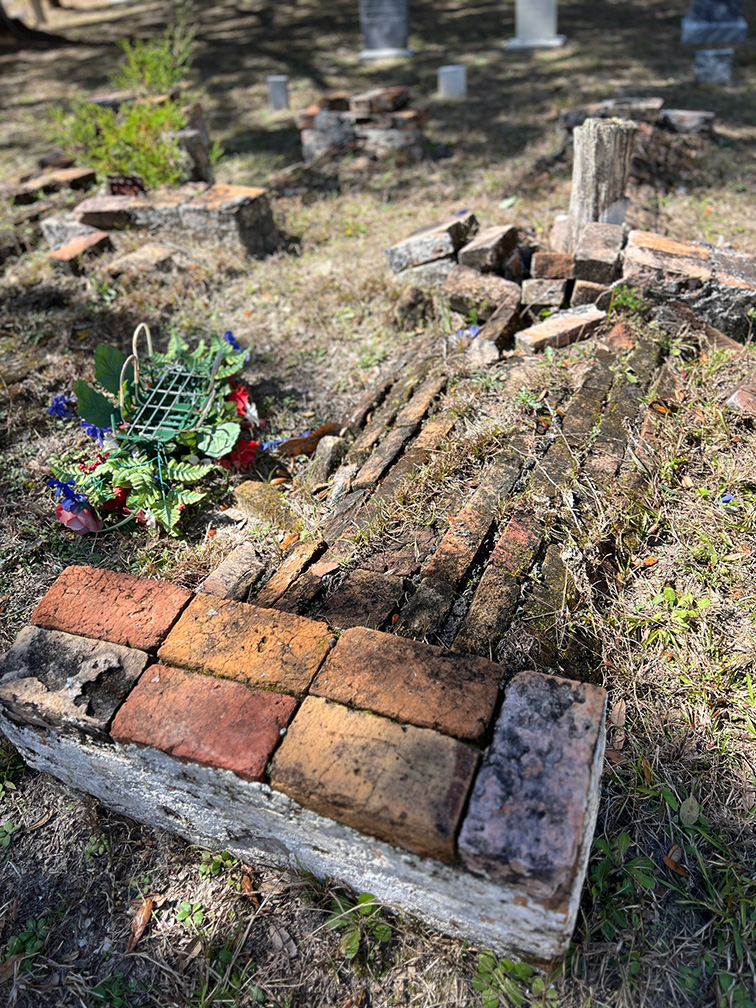 P. Marlin
P. Marlin
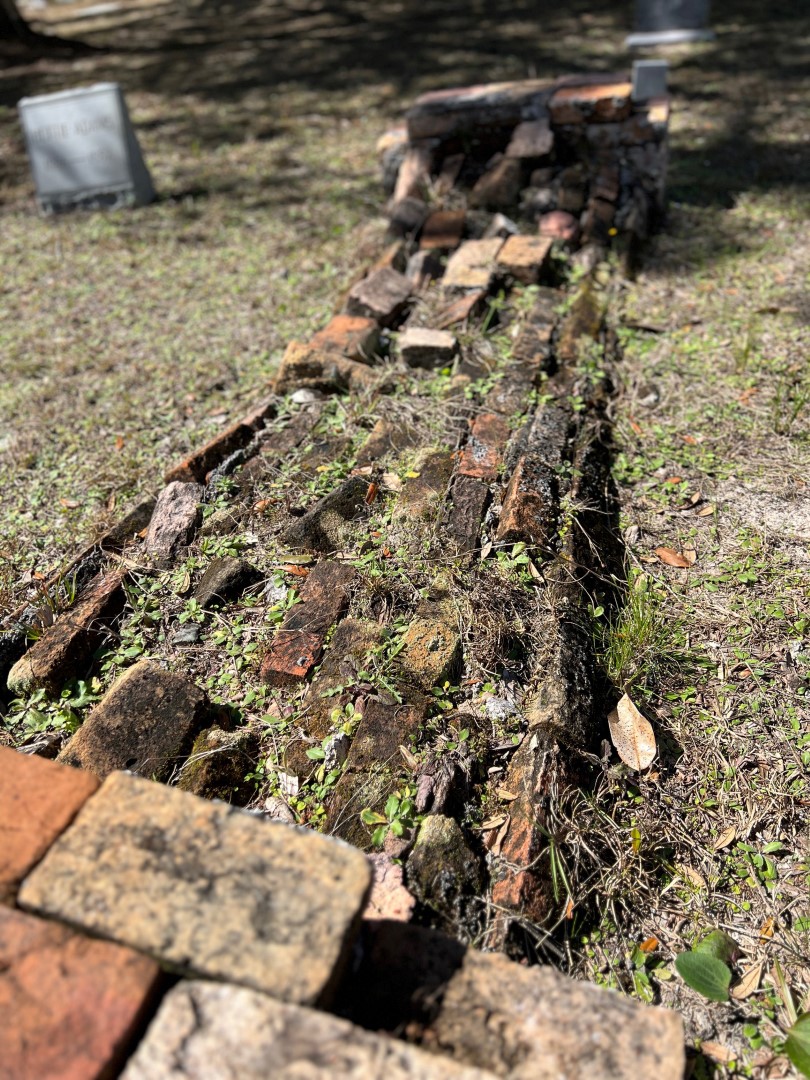 P. Marlin
P. Marlin
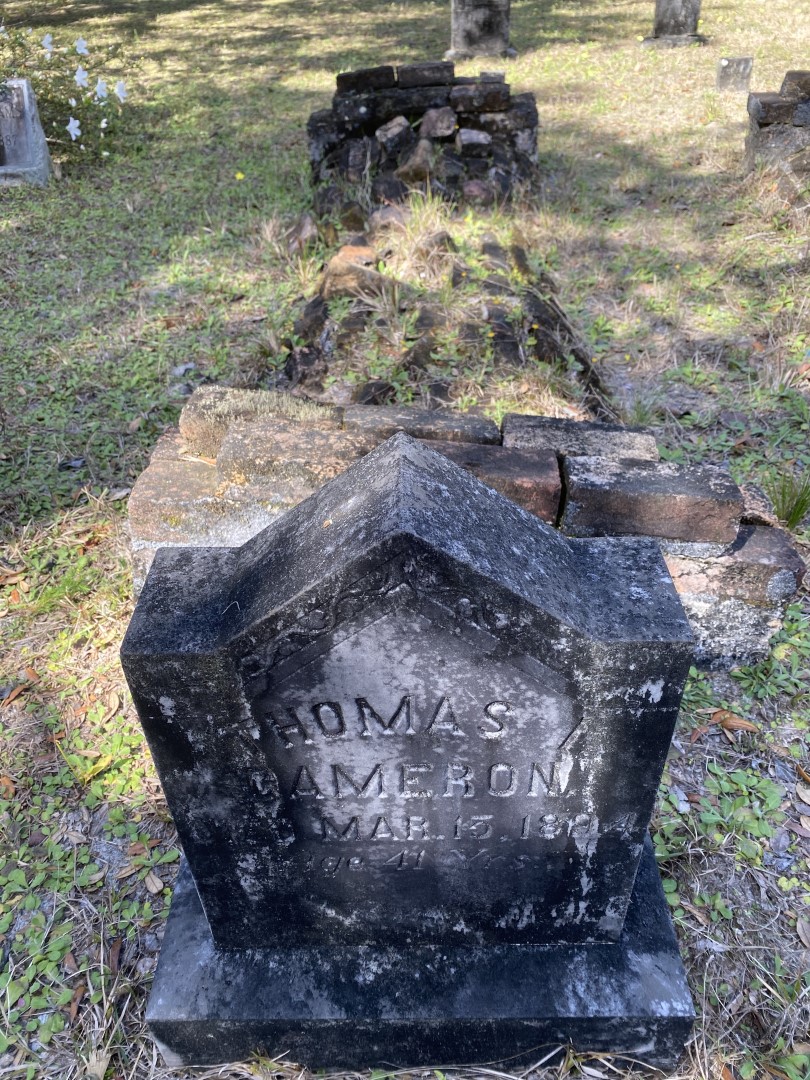 P. Marlin
P. Marlin
Among the oldest documented burials in the graveyard is that of J.F. Cheves (1855), Amanda Phifer, young daughter of McCollum Phifer (1855), Adelaide Williams (1858), and George Dansby (1858).
On the day of my visit to the Providence church, Gene Hunsucker, along with a group of church members, were cleaning the graveyard. Hunsucker proudly informed me that the team had discovered three gravestones that day. Many of the photos of the gravestones were taken the day of the cleaning showing the gravestones in pristine condition.
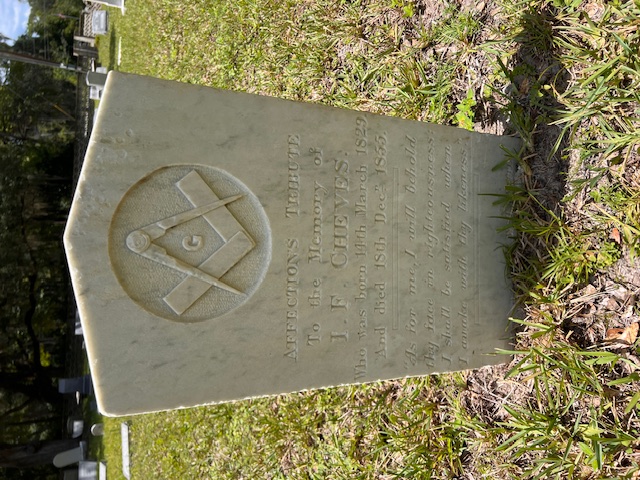 J.F. Cheves 1855. P. Marlin
J.F. Cheves 1855. P. Marlin
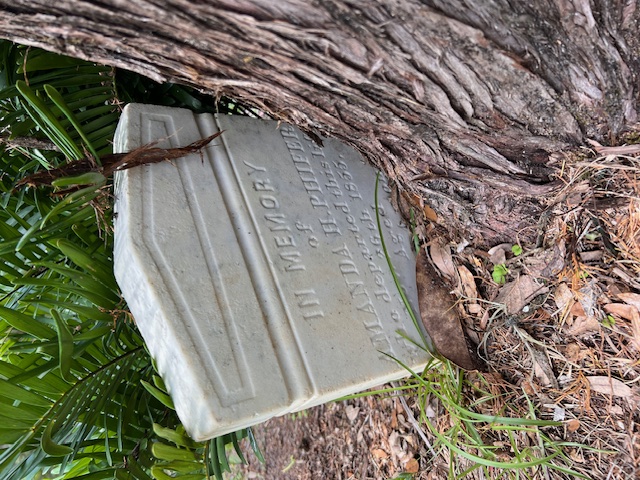 Amanda Phifer 1855. P. Marlin
Amanda Phifer 1855. P. Marlin
 Adelaide Williams 1858. P. Marlin
Adelaide Williams 1858. P. Marlin
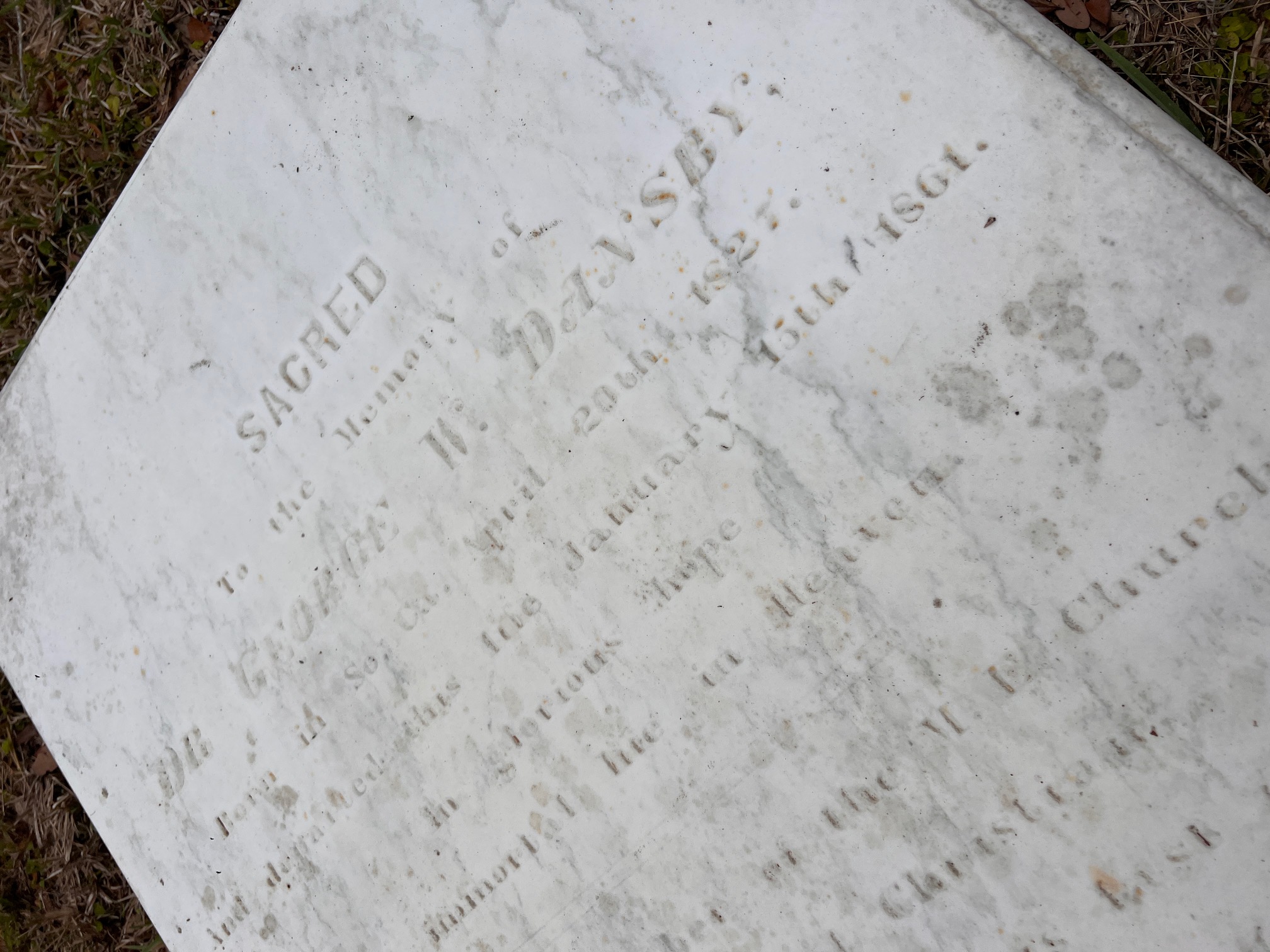 Close up of George Dansbury 1861. P. Marlin
Close up of George Dansbury 1861. P. Marlin
This series of photos includes the gravestones of those people highlighted in this blog, including the King family, McCollum Phifer, David Scott, and John A. Rosborough. John Alexander Kennedy is buried in the Oak Ridge Cemetery in Rochelle (referenced prior).
Those who served in the Confederacy are honored with gravestones commemorating their involvement. These were put in place by the United Daughters of the Confederacy in the 1960s. The iron crosses that once adorned these graves have since been stolen.
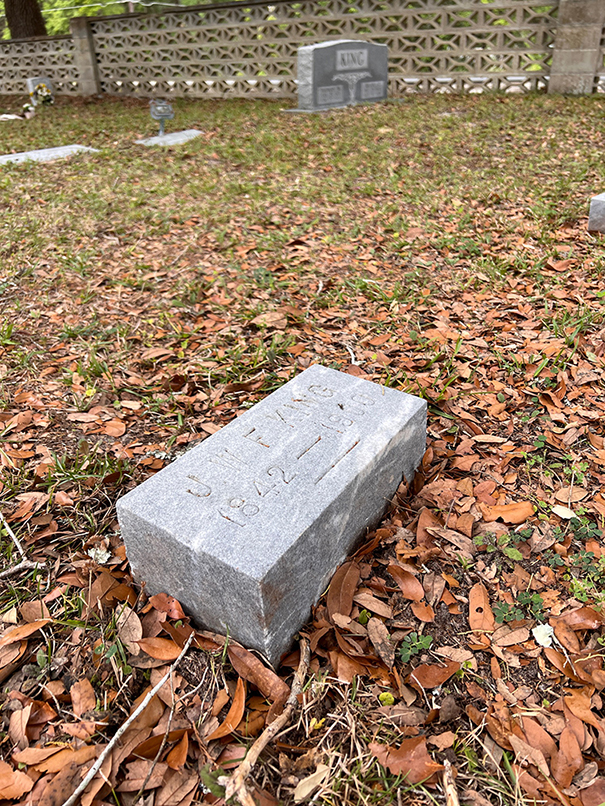 John William Fletch King, son of Reverend Edward L. King and his wife, Martha Kennedy King. P. Marlin
John William Fletch King, son of Reverend Edward L. King and his wife, Martha Kennedy King. P. Marlin
 Descendants of Reverend Edward L. King and Martha Kennedy King. P. Marlin
Descendants of Reverend Edward L. King and Martha Kennedy King. P. Marlin
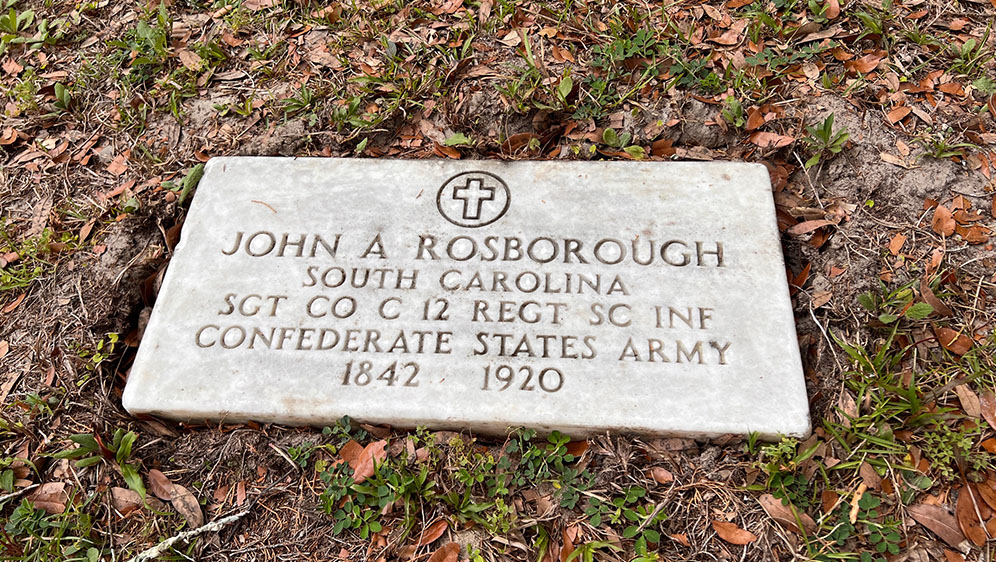 John Alexander Rosborough. P. Marlin
John Alexander Rosborough. P. Marlin
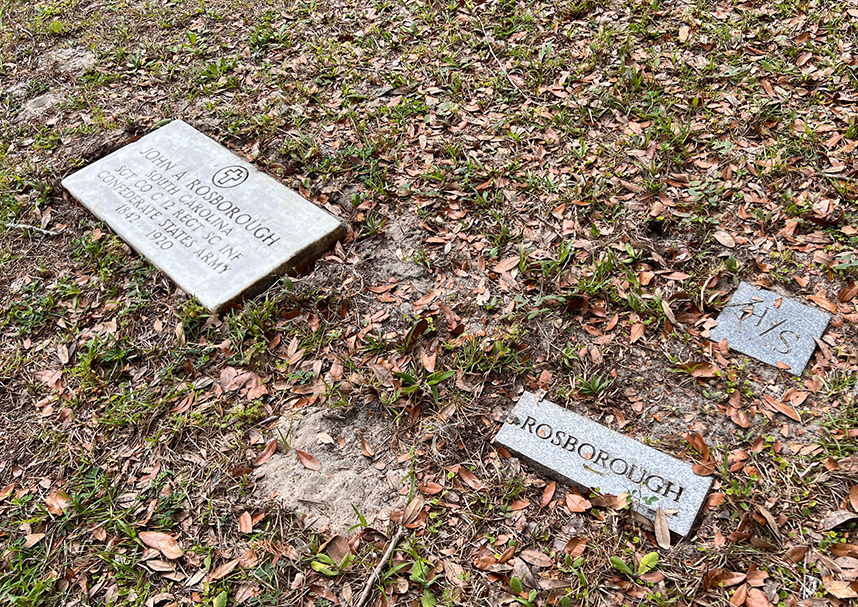 John Alexander Rosborough. P. Marlin
John Alexander Rosborough. P. Marlin
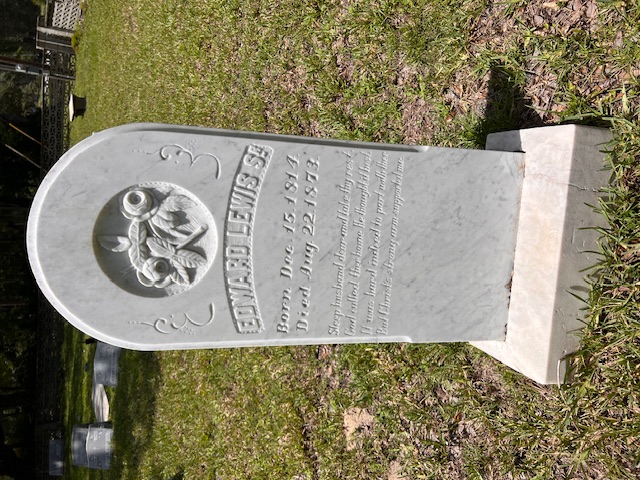 Edward Lewis Sr. P. Marlin
Edward Lewis Sr. P. Marlin
 Daniel Scott. P. Marlin
Daniel Scott. P. Marlin
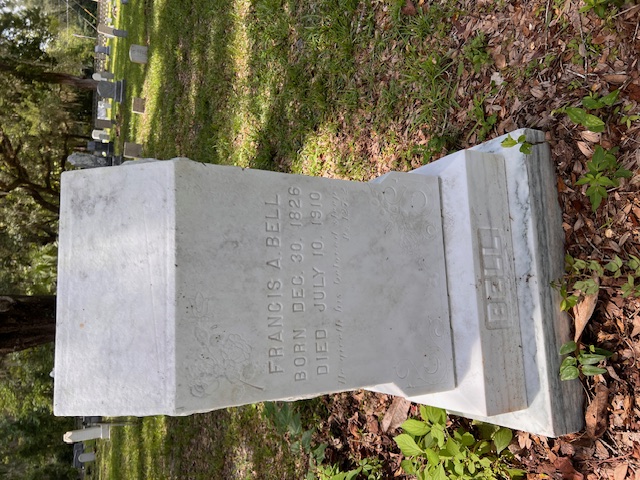 Francis Bell, father of Joseph F. Bell. P. Marlin
Francis Bell, father of Joseph F. Bell. P. Marlin
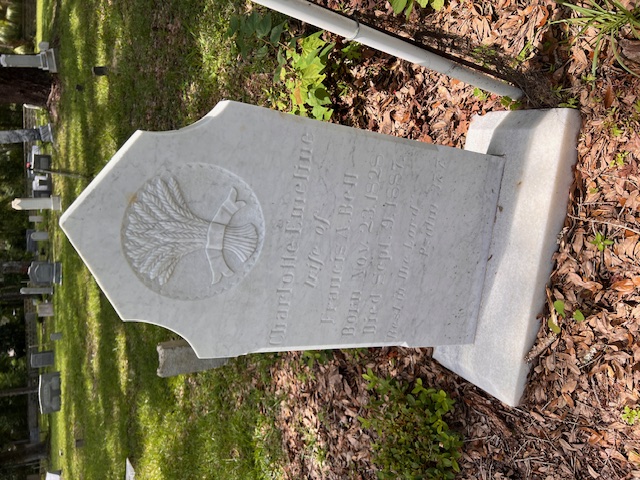 Charlotte Emeline Bell, mother of Joseph F. Bell. P. Marlin
Charlotte Emeline Bell, mother of Joseph F. Bell. P. Marlin
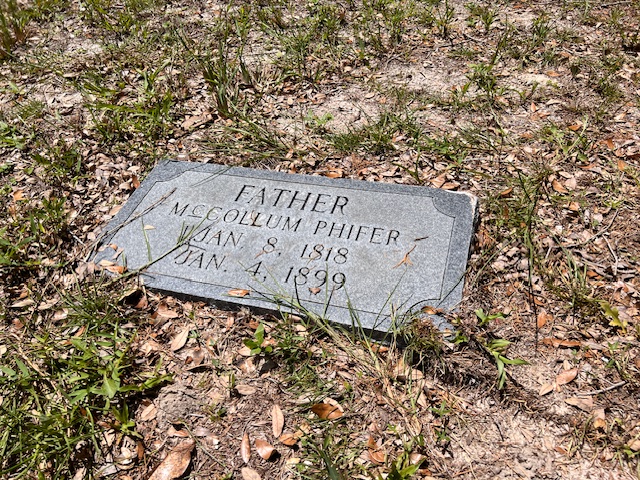 McCollum Phifer. P. Marlin
McCollum Phifer. P. Marlin
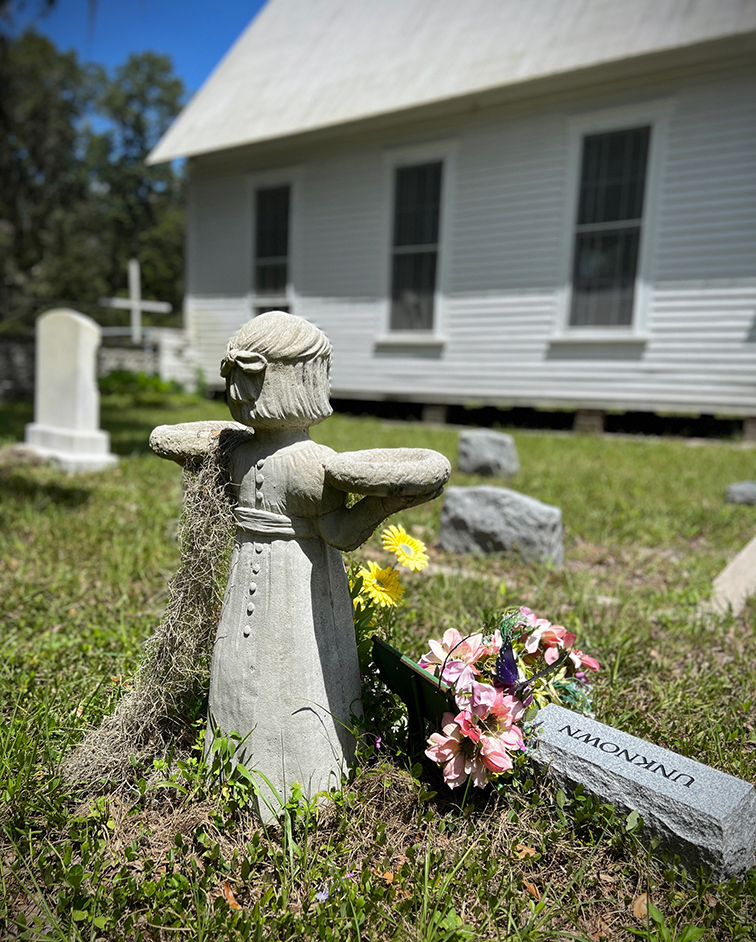 P. Marlin
P. Marlin
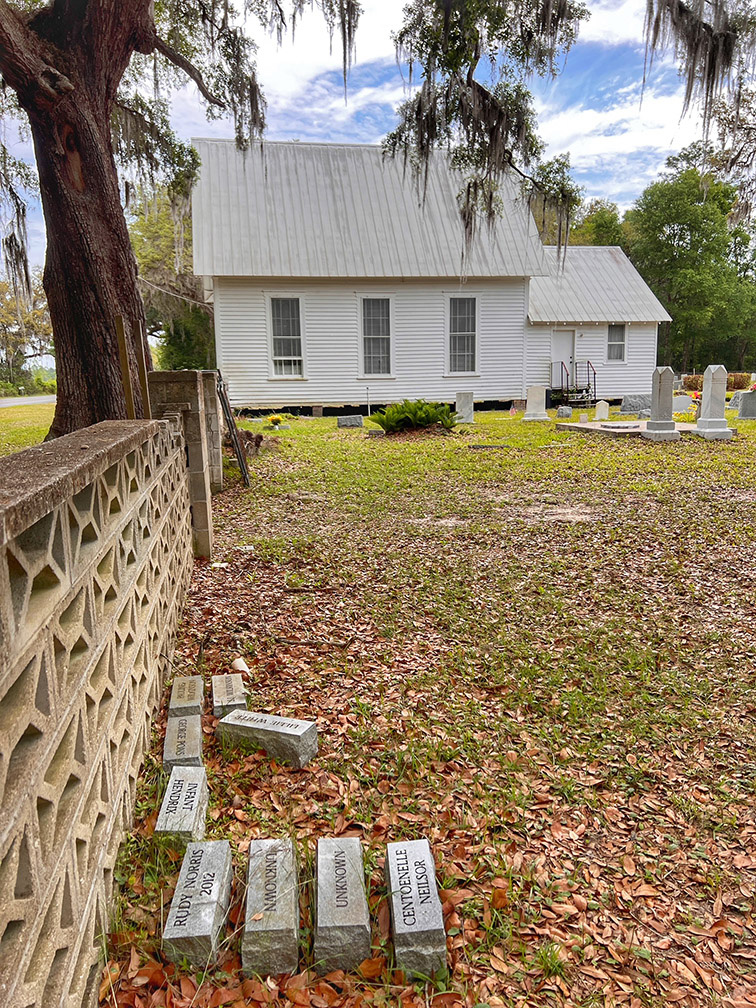 P. Marlin
P. Marlin
 P. Marlin
P. Marlin
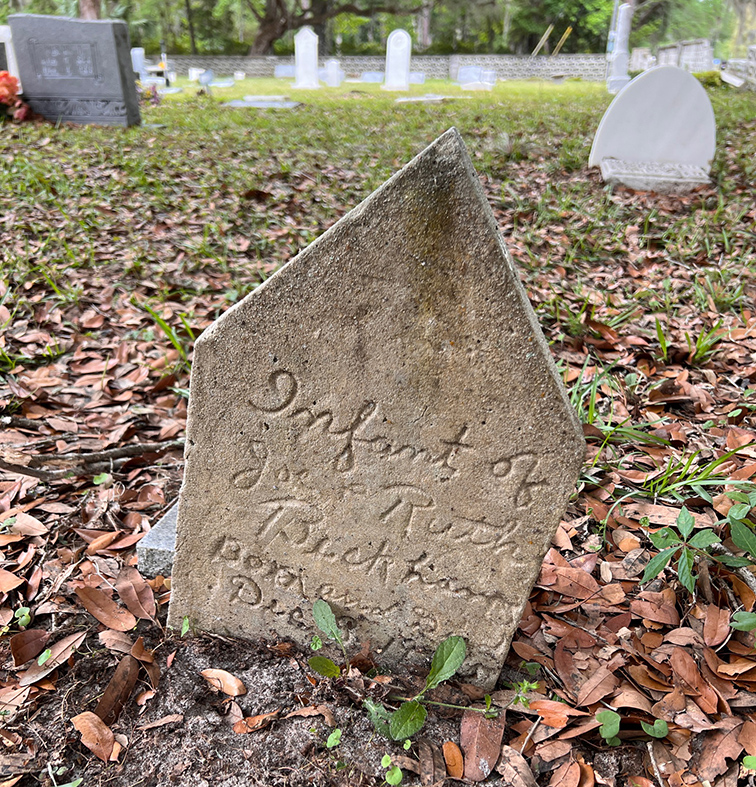 P. Marlin
P. Marlin
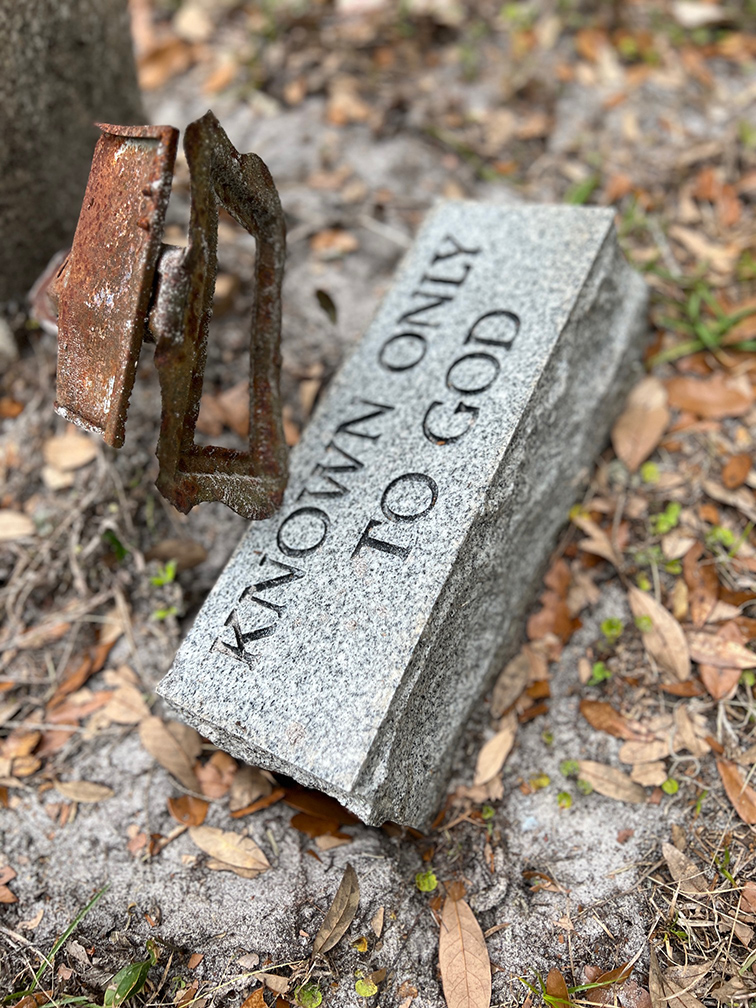 P. Marlin
P. Marlin
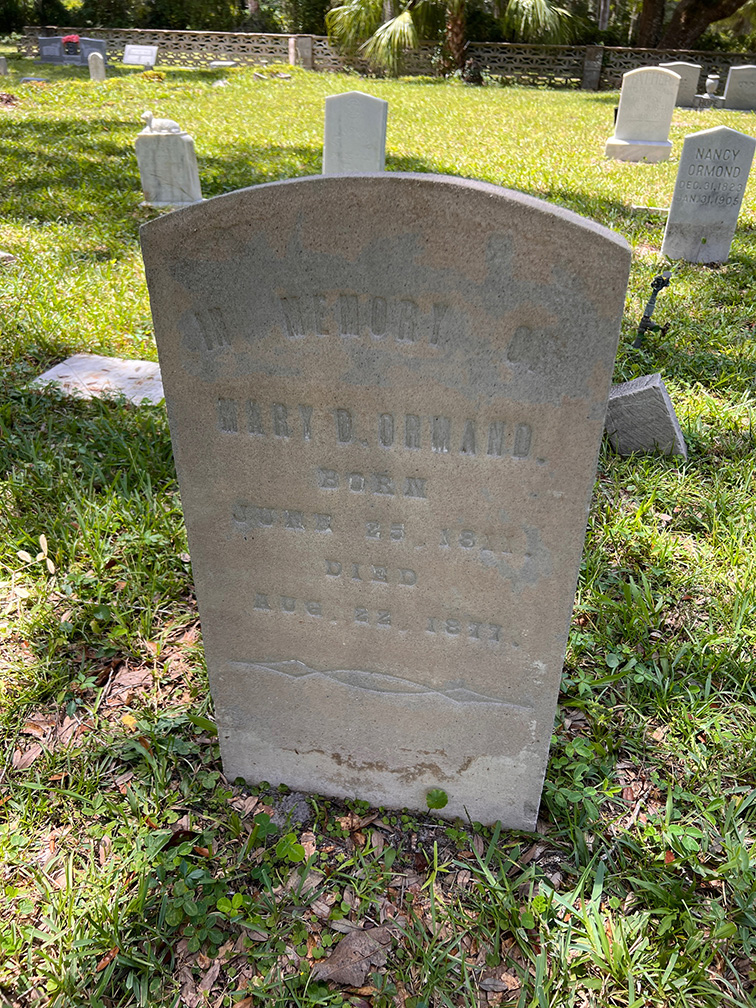 P. Marlin
P. Marlin
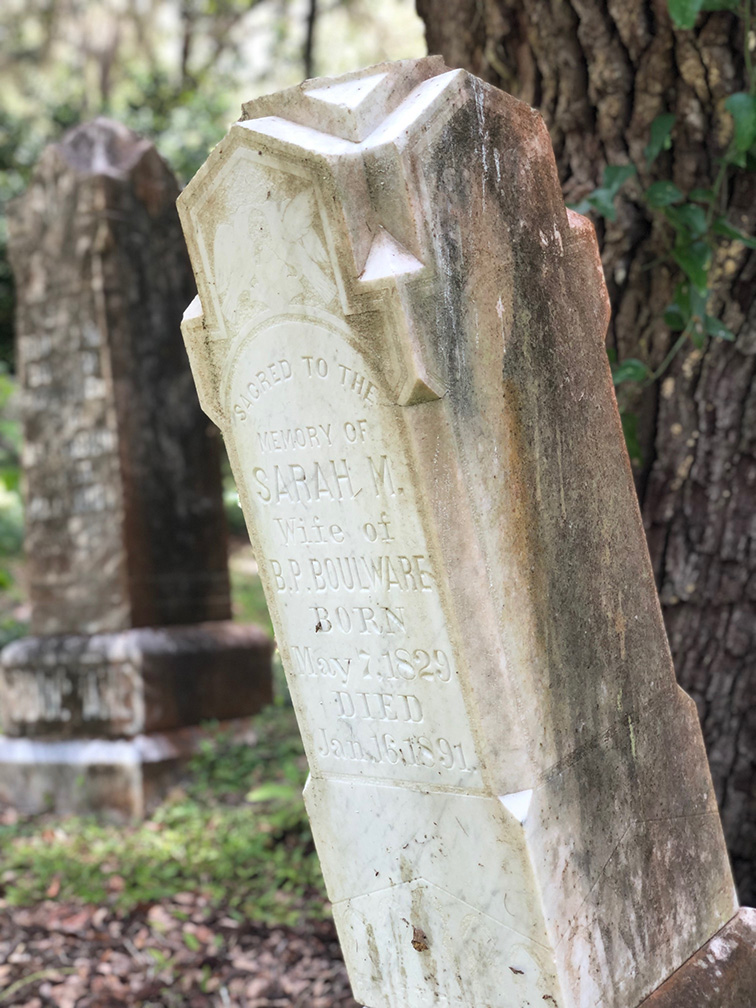 P. Marlin
P. Marlin
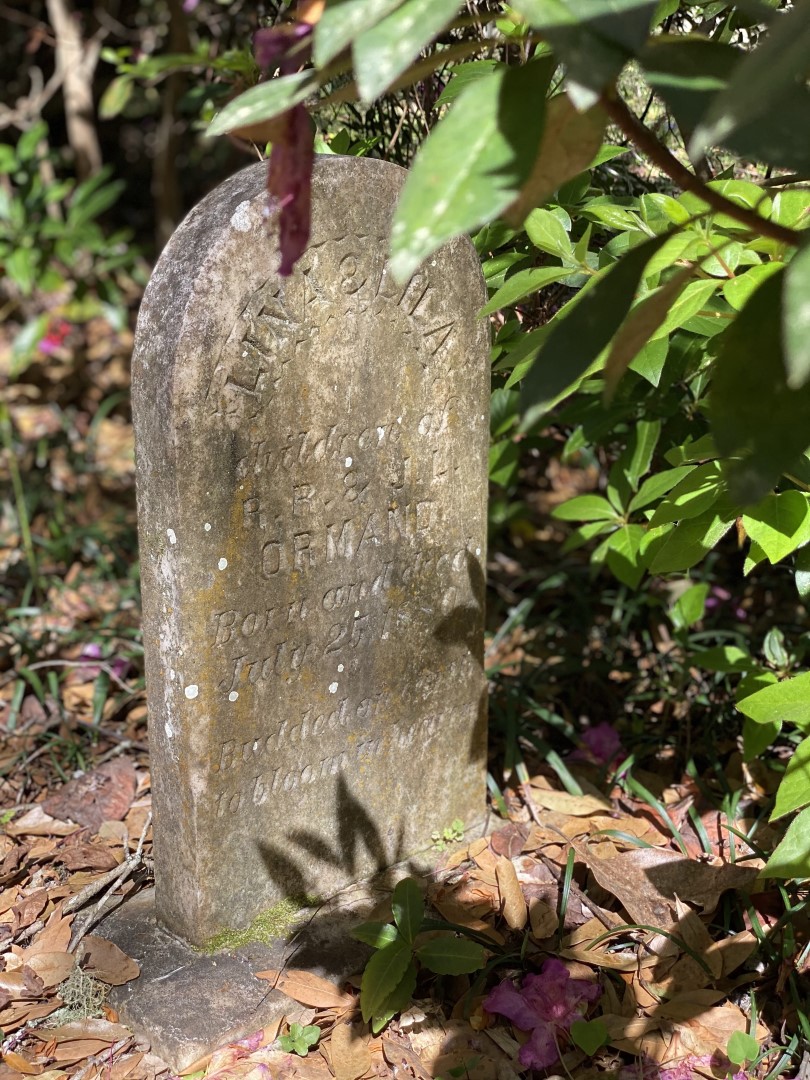 P. Marlin
P. Marlin
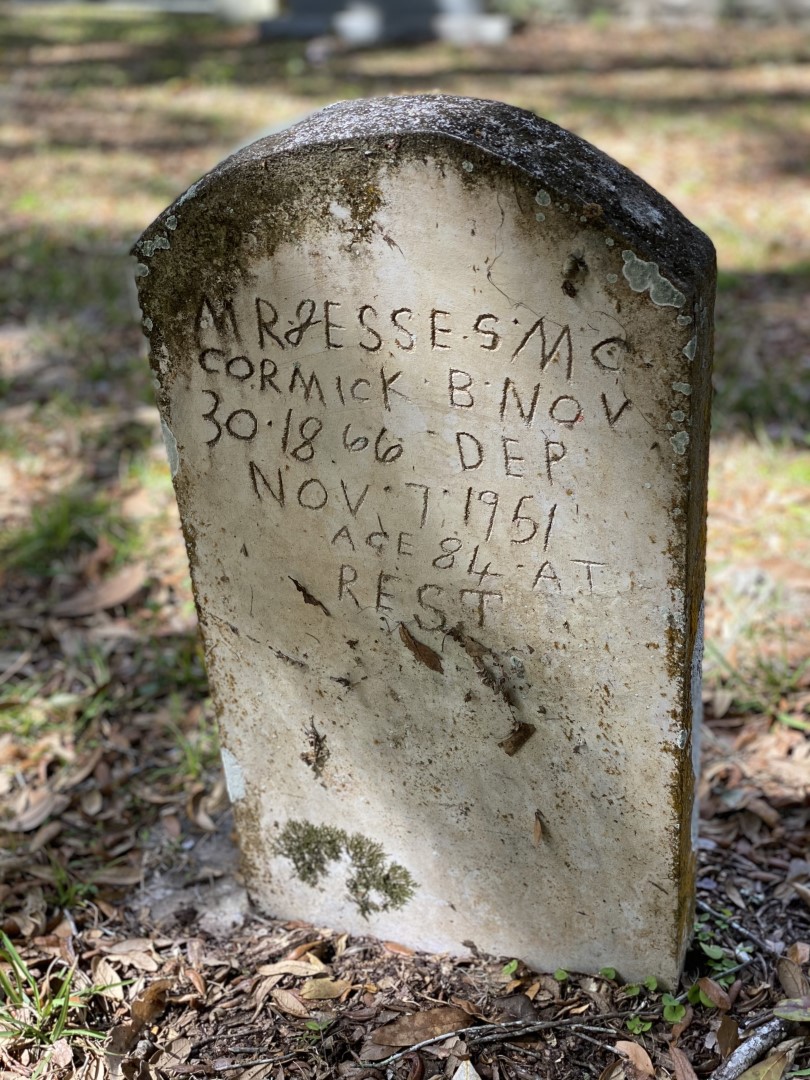 P. Marlin
P. Marlin
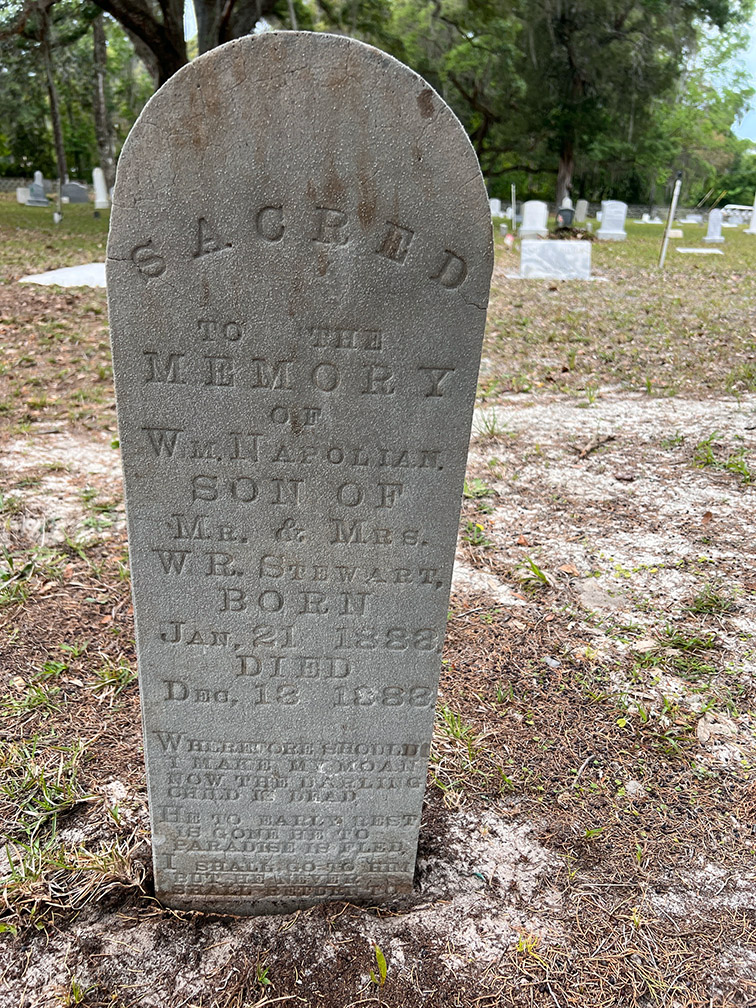 P. Marlin
P. Marlin
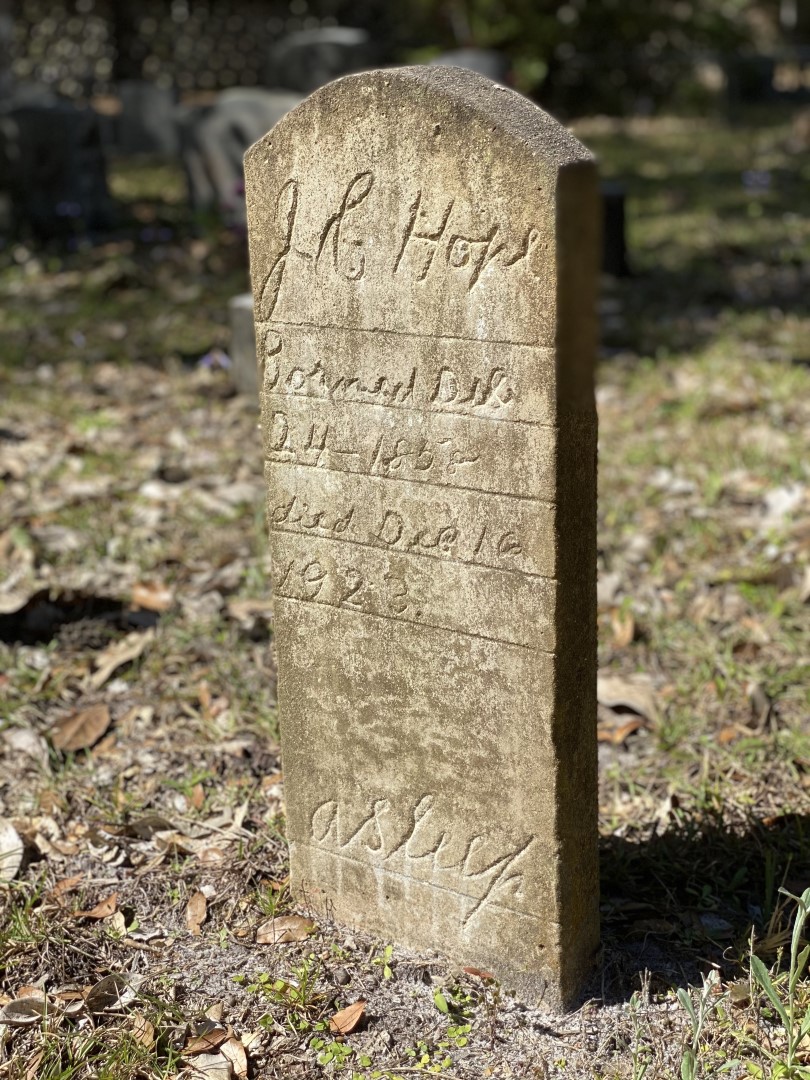 P. Marlin
P. Marlin
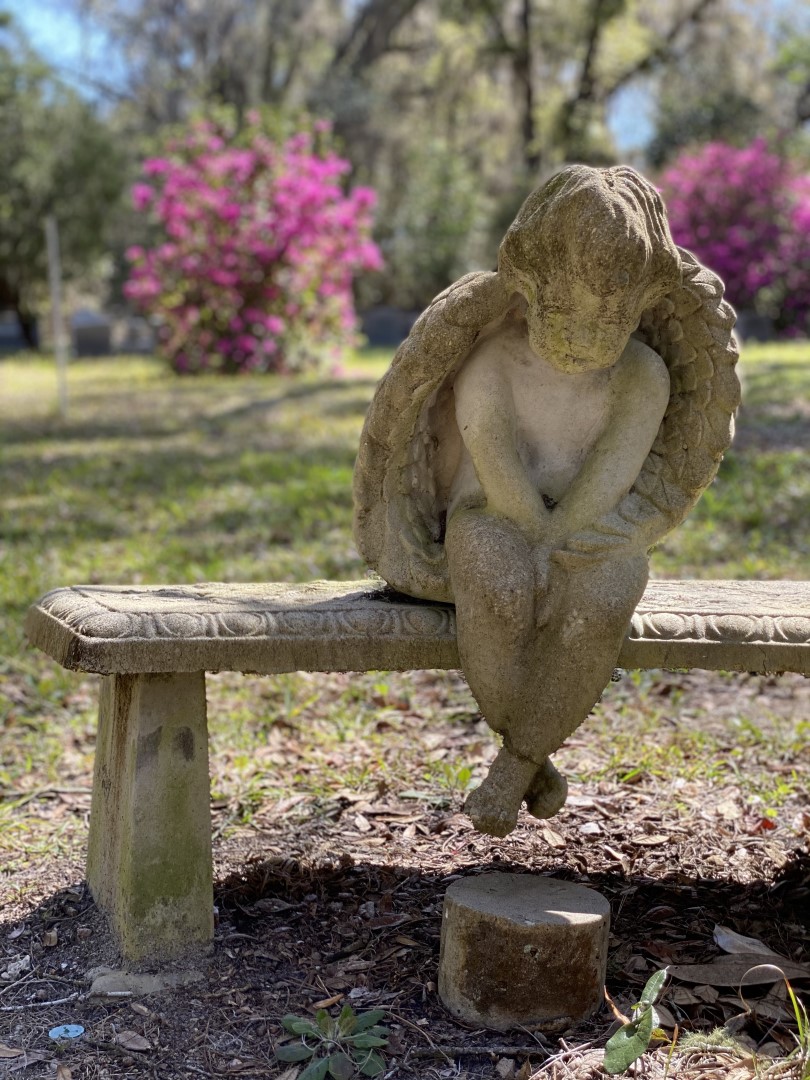 P. Marlin
P. Marlin
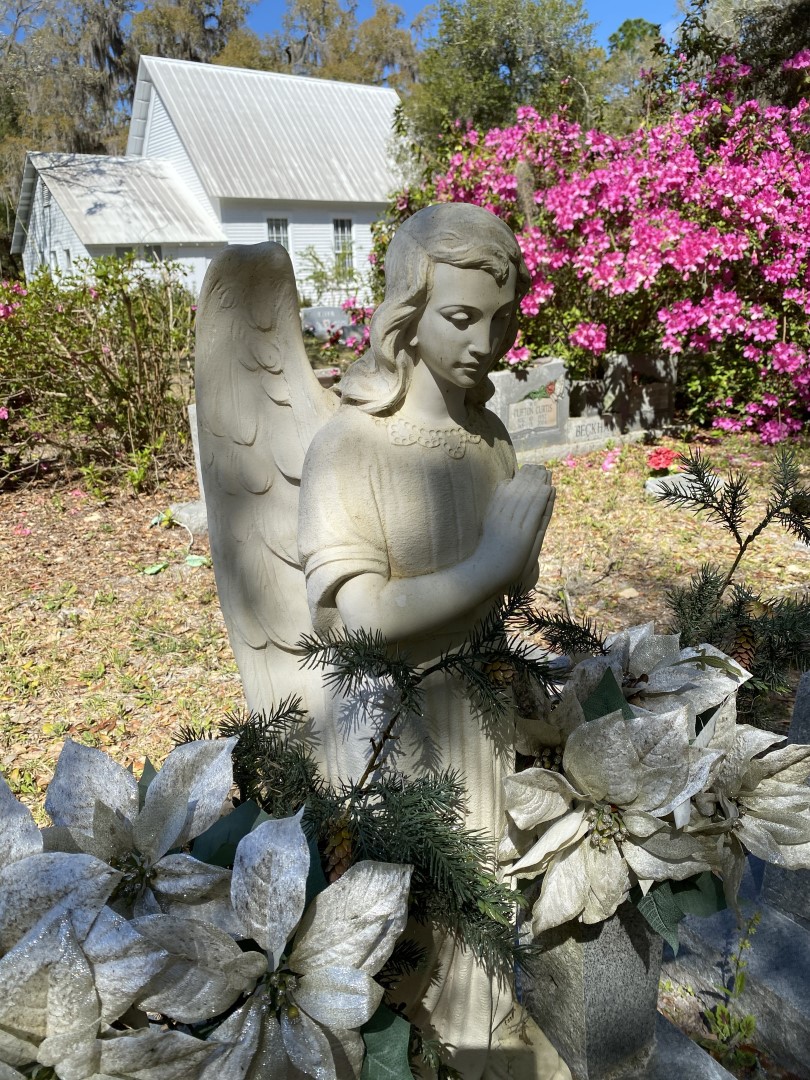 P. Marlin
P. Marlin
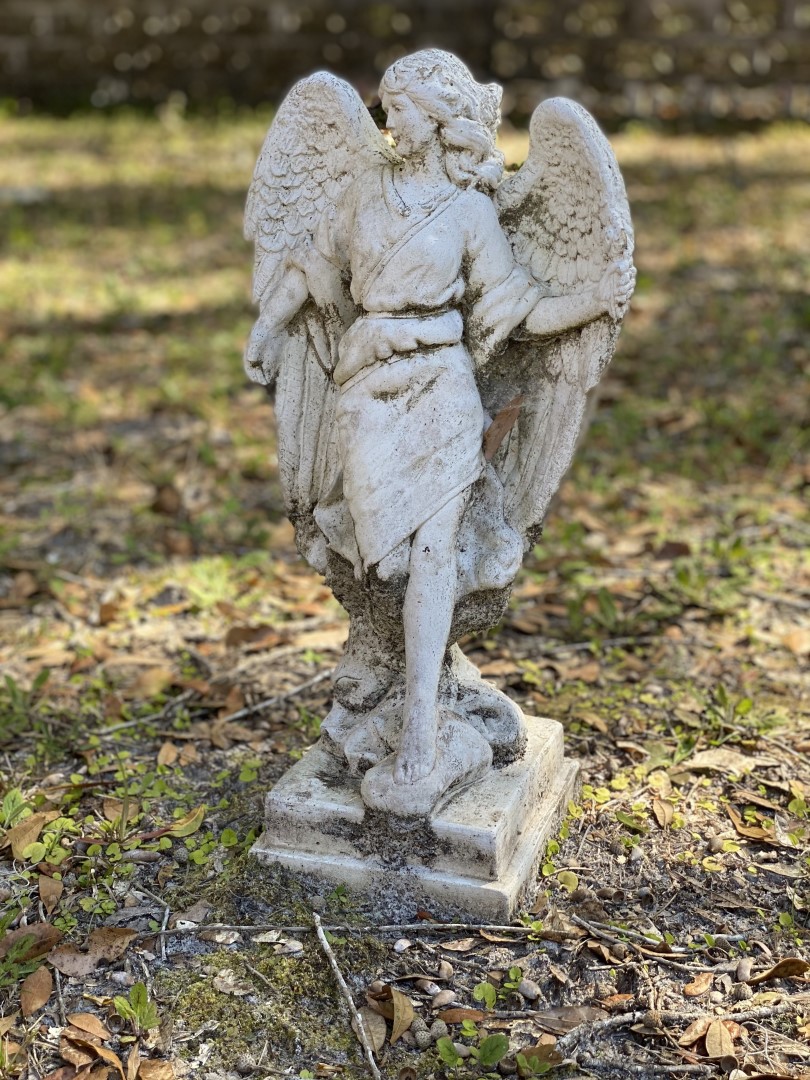 P. Marlin
P. Marlin
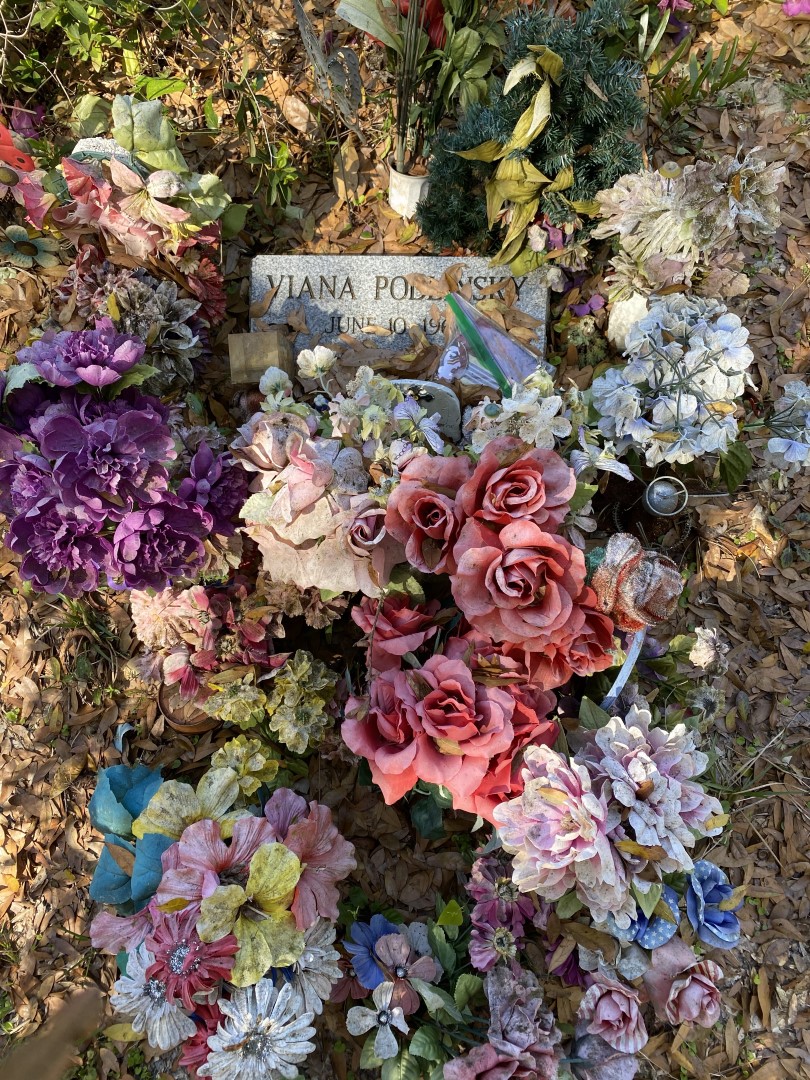 P. Marlin
P. Marlin
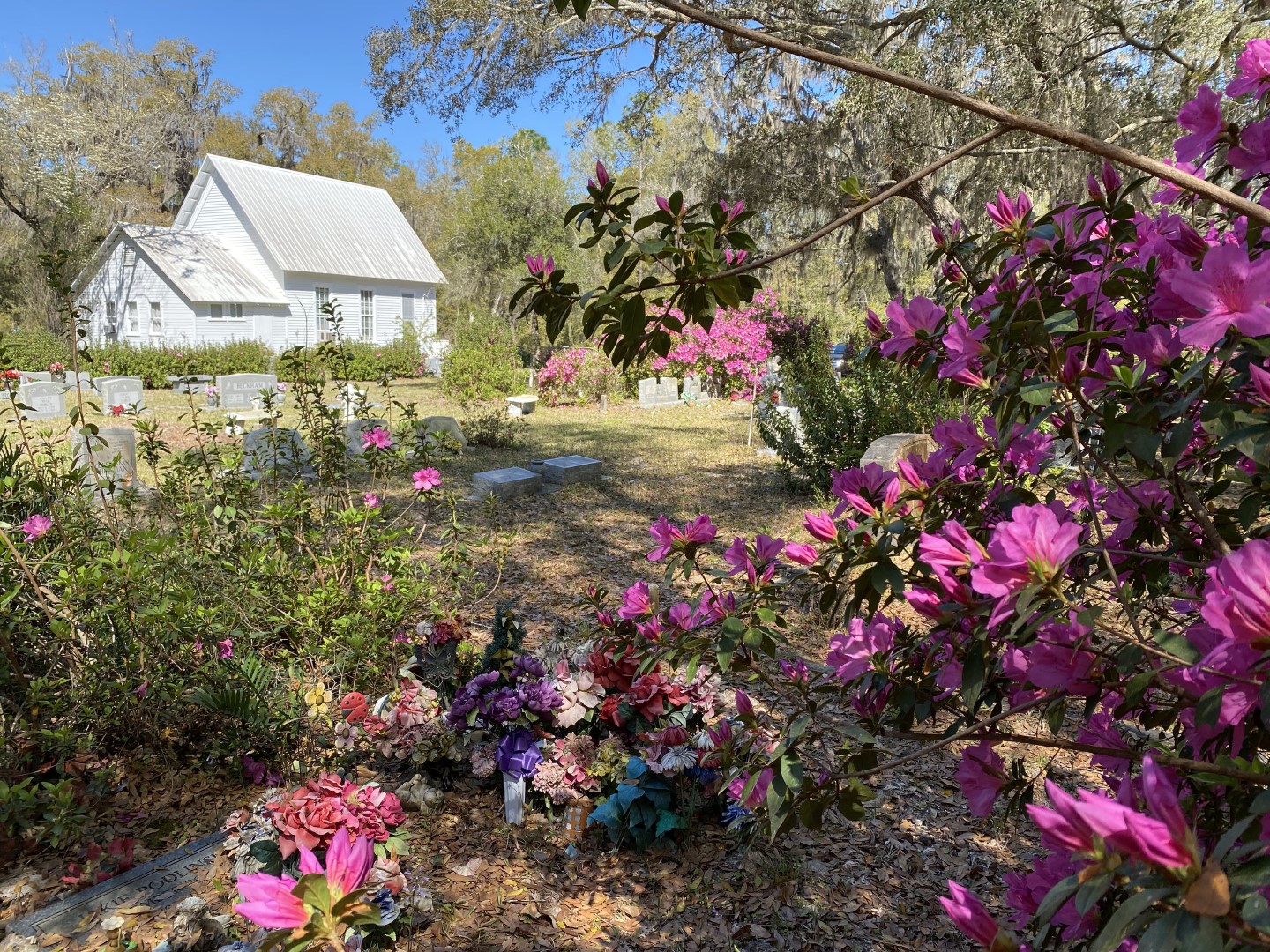 P. Marlin
P. Marlin
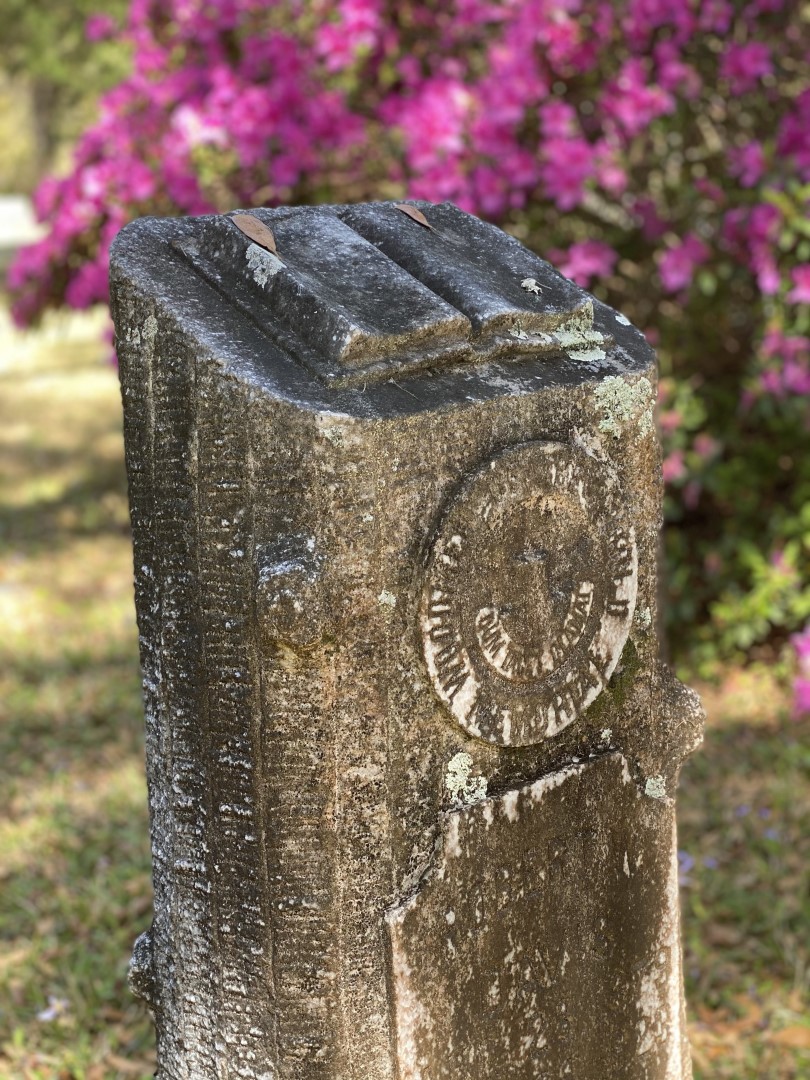 P. Marlin
P. Marlin
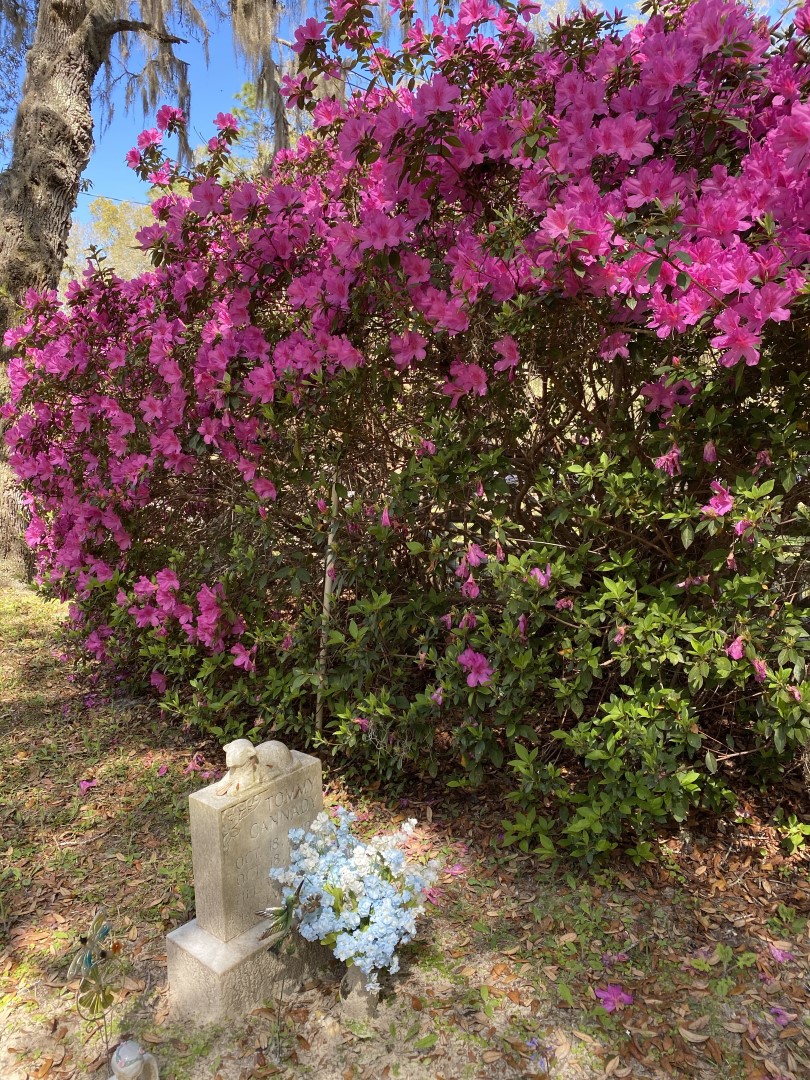 P. Marlin
P. Marlin
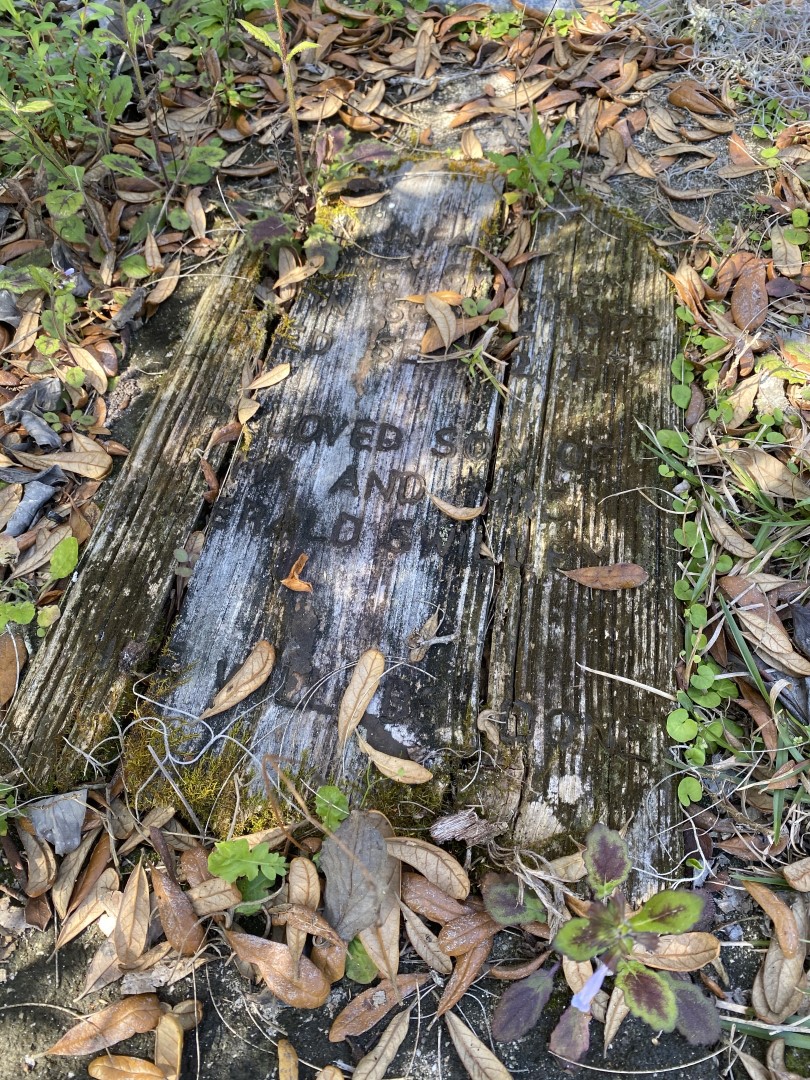 P. Marlin
P. Marlin
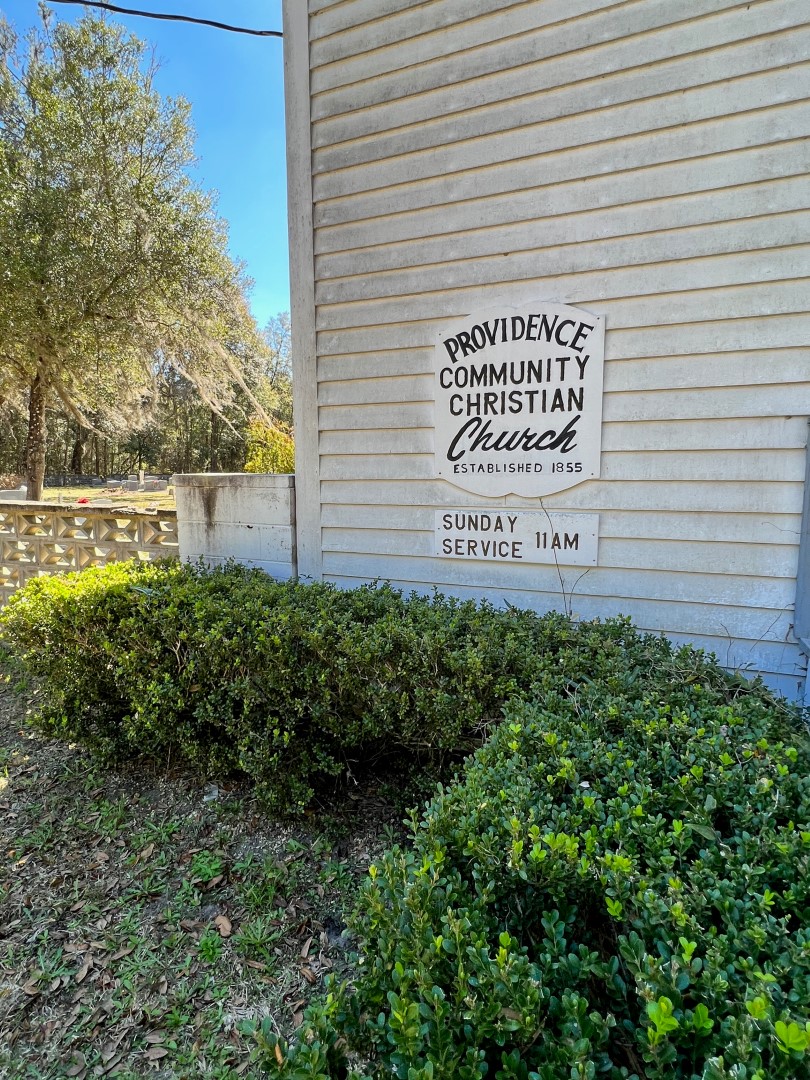 P. Marlin
P. Marlin
In 1959, my grandfather relocated from southern Illinois to Alachua County, initially establishing himself in Micanopy and eventually Gainesville. In 1970, he purchased a 10-acre pecan grove situated approximately a mile east of the Providence church. This property is situated in section 7 of the 1846 Arredondo Grant map (referenced prior). Despite my family's lack of involvement in the Providence church, our route to the family homestead consistently took us through Windsor and past the Providence church.
Following my grandfather's passing in the 1980s, my father acquired the property. Subsequently, he expanded it by purchasing an additional 10 acres, bringing the total to 20 acres. More than half a century later, I still pass by the Providence church enroute to my parents' home. My own connection to Edward L. King emerged when I perused my parents' abstract of title book. In 1855, King had acquired the property that encompassed the very lot my parents currently own, highlighting the eastern extent of King's property boundaries.
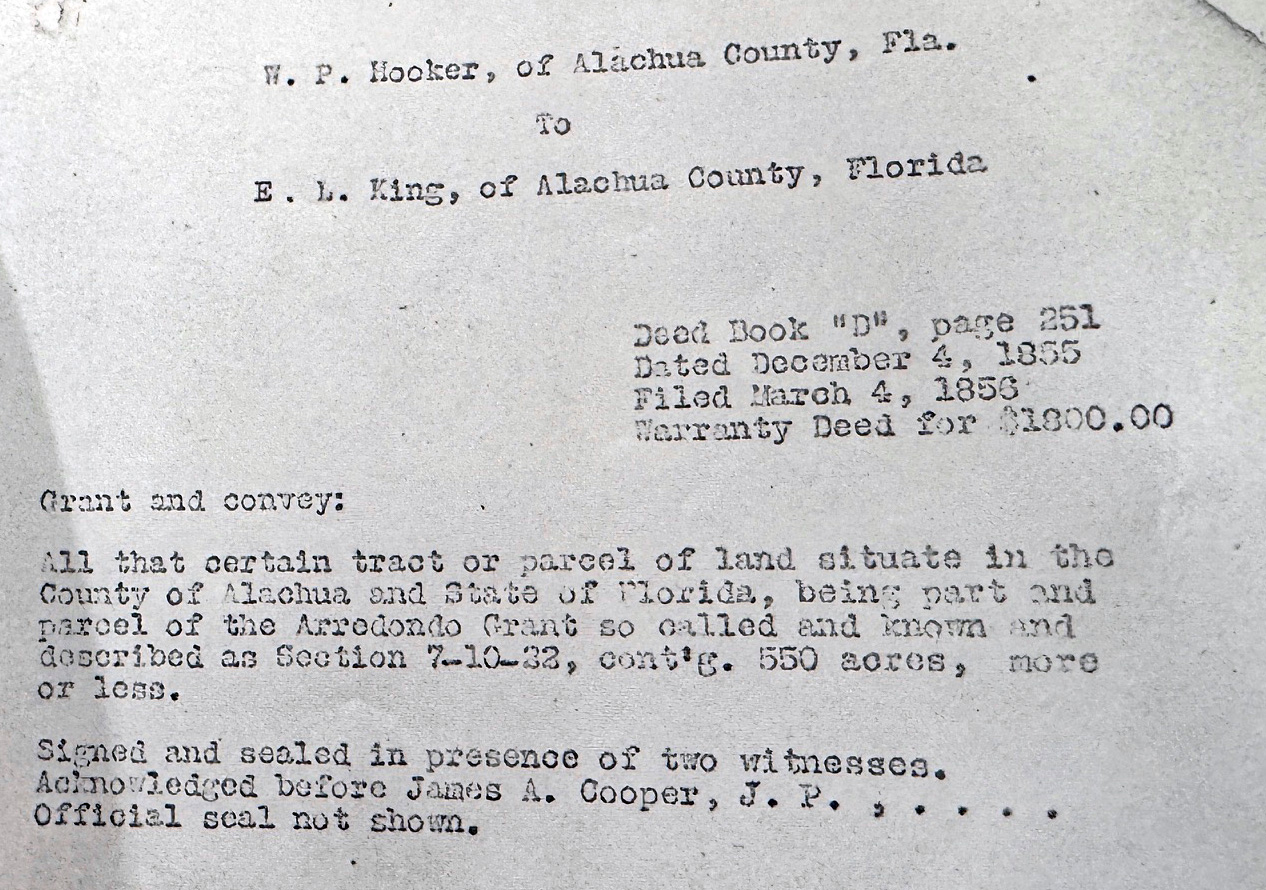 From my parent's abstract of title book. P. Marlin
From my parent's abstract of title book. P. Marlin
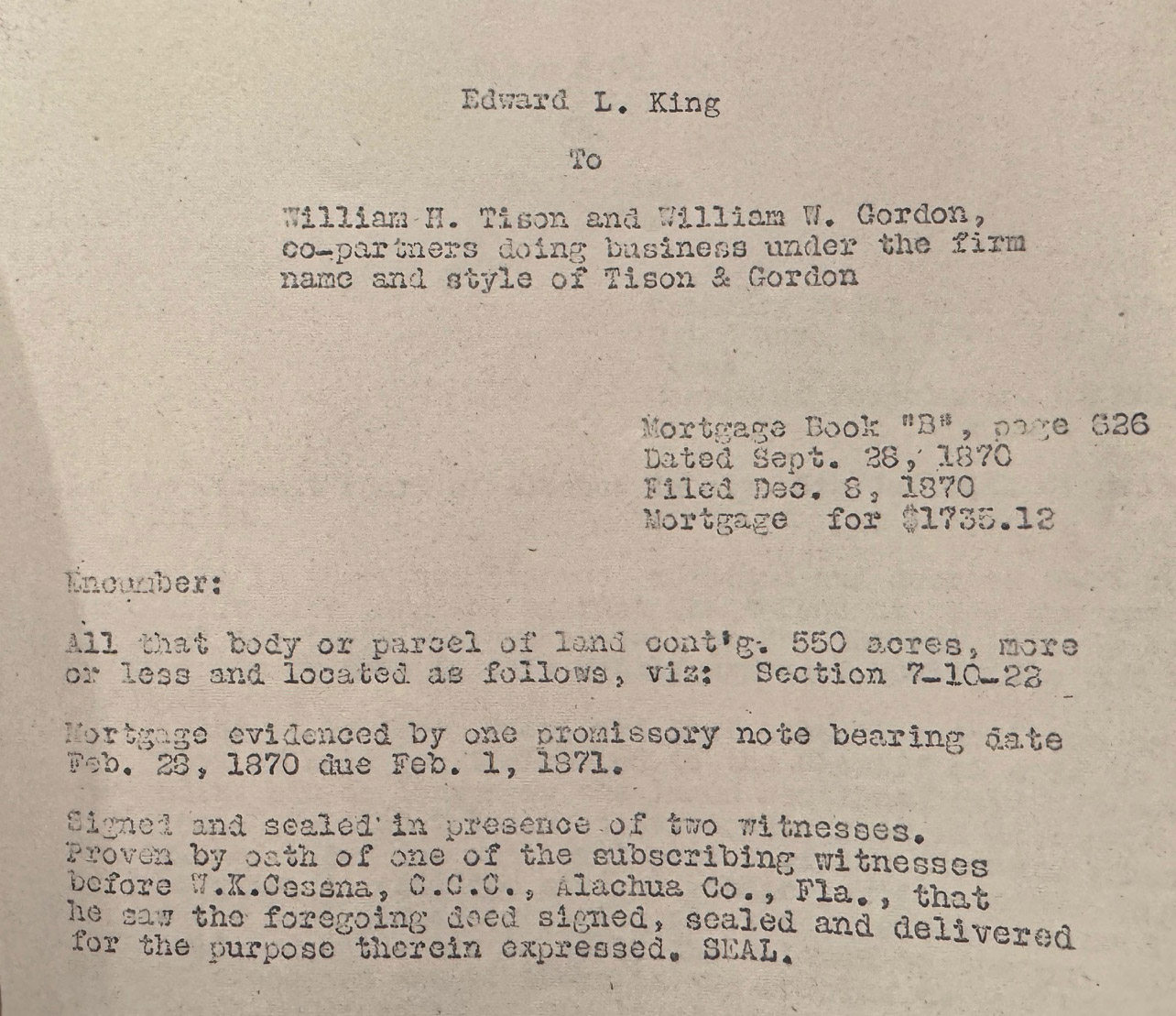 From my parent's abstract of title book. P. Marlin
From my parent's abstract of title book. P. Marlin
Numerous photos and histories associated with the Providence church have likely been lost to time. If you wish to contribute to the church's history by sharing a photo or historical account, please feel free to email me at zgator66@gmail.com.
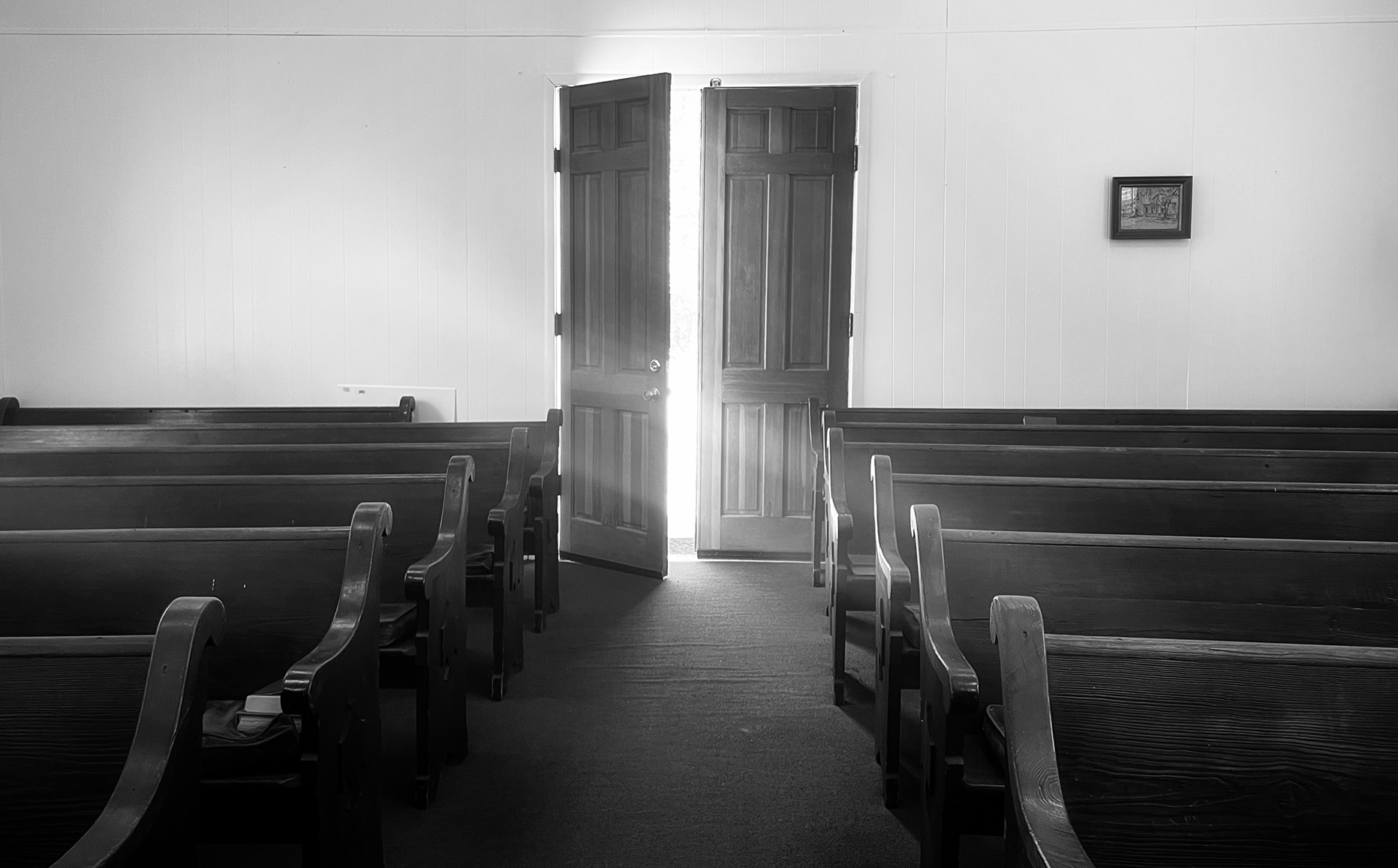 Journey's end. P. Marlin
Journey's end. P. Marlin
1 Slavery and Plantation Growth in Antebellum Florida: 1821-1860
2 Settlement Patterns in Alachua County, Florida, 1850-1860
3 Webb's historical, industrial and biographical Florida Pt. I.
4 Greene, Gerald Edward Lewis, Antebellum Planter of Alachua County, Florida
5 Methodist Circuit Riders in America 1766-1844
6 The History of Methodism in South Carolina
7 East Florida Seminary - Micanopy
8 Minutes of the Annual Conference of the Methodist Episcopal Church, South for the year 1875.